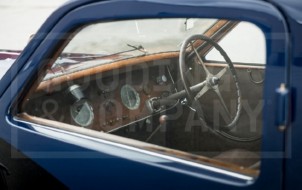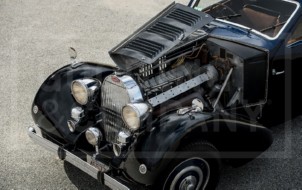

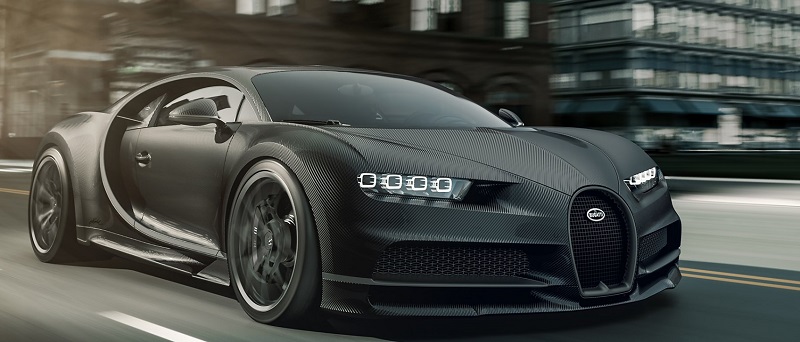
December 5, 2019
|
Molsheim, 29-11-2019 NEW EDITION MODEL OF THE CHIRON INSPIRED BY THE MOST BEAUTIFUL CAR IN THE WORLD “La Voiture Noire”, the black car, was a special Type 57 SC Atlantic created by Jean Bugatti – the most famous and most beautiful car in the world. Only four were built between 1936 and 1938. The black car disappeared at the beginning of the Second World War. If it were ever to be found, it would probably be the most expensive and most valuable car in the world. In March 2019, Bugatti Design Director Achim Anscheidt ( My info is different from that of Bugatti, as far as I know it was designed not by Anscheidt, but by Etienne Salomé) reinterpreted “La Voiture Noire”, bringing this special automobile forward to the 21 century. The modern interpretation of the coupé was created as the ultimate Gran Tourismo for Bugatti enthusiasts. This unique specimen once again demonstrates that Bugatti makes the most powerful, luxurious and exclusive hyper sports cars in the world. “The true form of luxury is individuality. 'La Voiture Noire' is the spearhead of automotive engineering – a sculptural beauty,” says Bugatti President Stephan Winkelmann. A coupé with the comfort of a luxury limousine and the power of a hyper sports car.´
La Voiture Noire continues to attract interest Black exposed carbon covers the finely wrought body of the “Chiron Noire Élégance”. The grille of the famous Bugatti radiator sports a fresh design, while the Bugatti “Macaron” emblem sits at the centre, made of solid silver and exclusively refined with black enamel. Calipers finished in black are installed behind the new Caractère wheels. The C-shaped Bugatti signature line, milled from solid metal, visually interrupts the black body of the “Chiron Noire Élégance” with its matt polished aluminium finish. Other exterior accentuations such as the rear-view mirror and engine cover are finished in black carbon and polished aluminium. The “Noire” inscription adorns the side panels in front of the rear wheel and the underside of the rear wing. The interior is also dominated by black. Inside the “Chiron Noire Élégance” only the “Inner Signature Line” – the light bearer curved in the style of the outer C-line – is made of aluminium with a silk-matt finish. The edition model inscription “Noire” appears on the door sills and on the outside of the centre console, as well as being sewn into the headrests. An additional carbon badge inlaid in the centre armrest demonstrates the exclusivity of each edition vehicle.
Bugatti “Chiron Noire Sportive” with matt finish The iconic 8.0-litre 16-cylinder engine with 1,103 kW/1,500 hp and 1,600 Newton metres of torque continues to serve as the power unit. The “Chiron Noire” is also available for the Chiron Sport at an extra charge of EUR 100,000. The edition model, limited to 20 vehicles, will be delivered from the second quarter of 2020 at a price of three million euros net in the basic version.
|
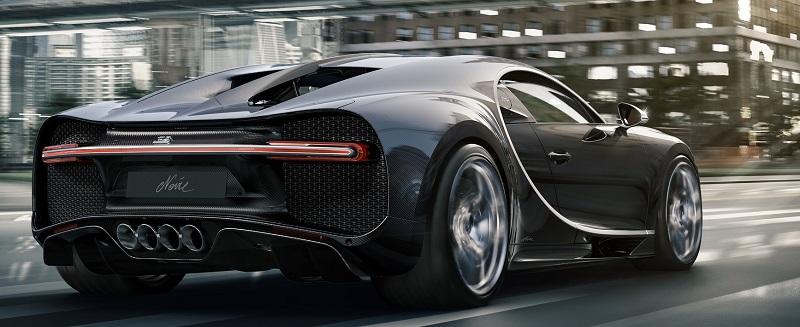
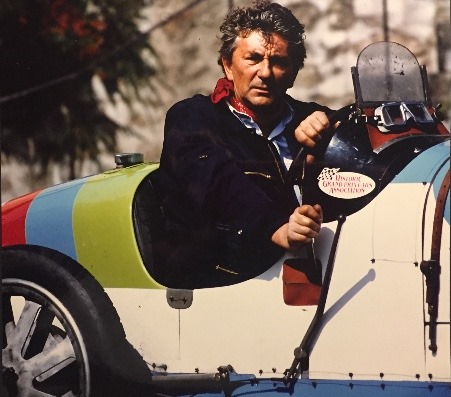
November 29, 2019
|
Marc Nicolosi, famous Bugattiste and founder of the Retromobile show left us Wednesday morning. Marc was the first to unite the world of the classic automobile by creating in 1976: Retromobile.
Generous, he liked to share his passions and especially for Bugatti. Although he was not in the organisation
|
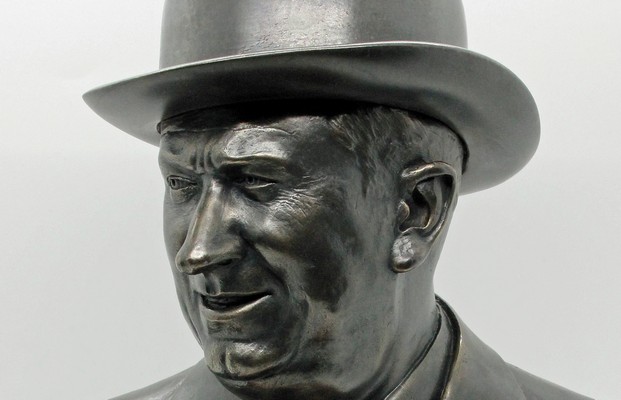
November 29, 2019
|
UK model maker, designer and Bugatti enthusiast Greg Morgan has recently completed a sculpt of Ettore Bugatti. He sent me the photographs above and below, judging from the photographs alone, the sculpture is very accurate and life-like. 20 individually numbered editions have been made in bronze from the original wax sculpt using the cire perdu method.
The piece stands 250 mm high on a solid rose wood base, inset with Ettore’s signature in stainless steel on the front face. Maybe a nice Christmas idea for "the man (m/f) who already has everyting"? |
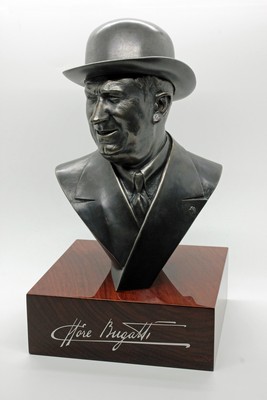
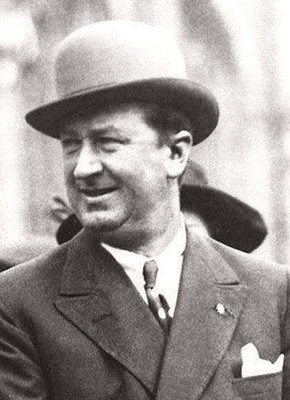
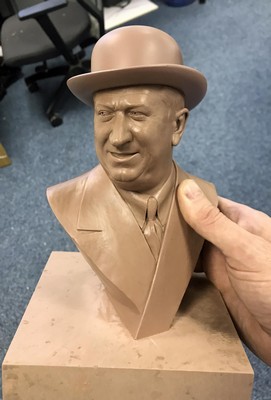
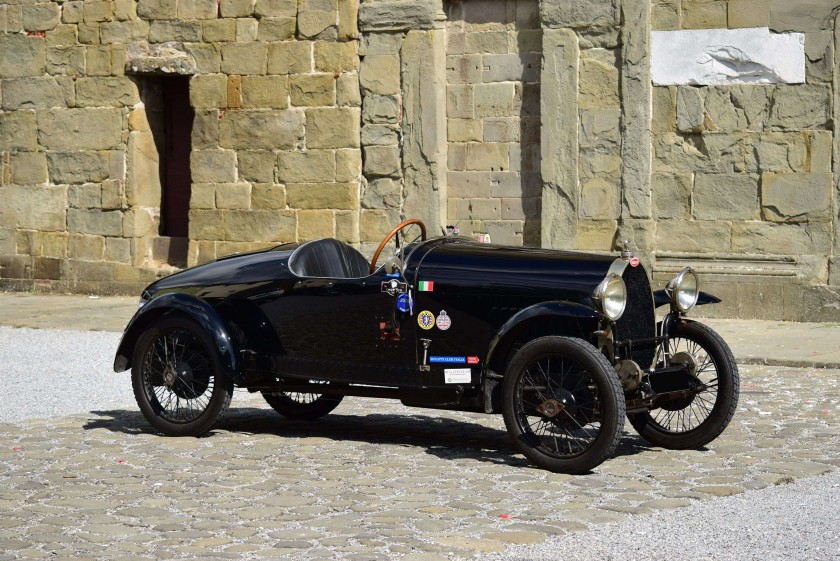
October 31, 2019
Artcurial "Automobiles sur les Champs" auction, October 27, 2019

October 24, 2019
At the Bugatti Trust they are extremely proud, as the Trust won the "Museum of the Year" award!
In fact it was kind of a double win for the Trust as the 1939 Bugatti Type 59/50B won the Car of the Year award. The Trust of course has had it in a special exhibition!
Trust Curator Angela Hucke writes:
Incredibly grateful to Sue Barnes, David Morys and David Carpenter what a team we are and to all our amazing volunteers and our board and Hugh Conway and the BOC
and of course to Richard Keller @citeautomulhouse who nearly two years ago said yes to a very special exhibition plan!
We have only gone and done it!
And of course thank you to everyone who voted for the beauty that is the Wimille car! So special that it won by public vote!
See here the winners in all classes.
October 16, 2019
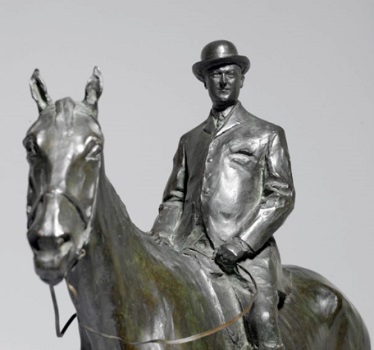
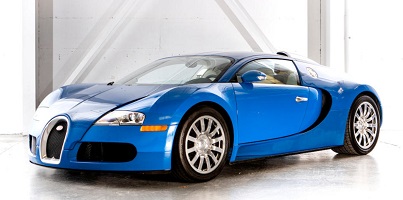
October 2, 2019
Koller Auction, Zürich, Switzerland, September 26, 2019
Bonhams' Bonmont Sale, Cheserex, Switzerland, September 29, 2019
It seems the truth becomes clear: if you're in it for the investment; better go for sculptures, or even modern Bugattis!
 September 26, 2019
September 26, 2019 For several years Ladislas de Monge and Pierre de Bellefroid have been working on a documentary movie about the history of an unusual plane, to pay tribute to those who have conceived and built it. Announced for a long time, this film about the racing aircraft "Bugatti 100P" is nearing completion. To finish "Beyond the Blue", they need your help to complete the post-production. For this purpose they have started a crowdfunding campaign. The "Kiss Kiss Bank Bank" platform is used, for which you will find the link below:
www.kisskissbankbank.com/en/projects/beyond-the-blue
A Facebook "Beyond the Blue" page is also open to follow the evolution of the project and the current financing:
www.facebook.com/beyondtheblue.movie/
In advance we thank you for your help, it is expected that the achievement will be presented in the spring of 2020.
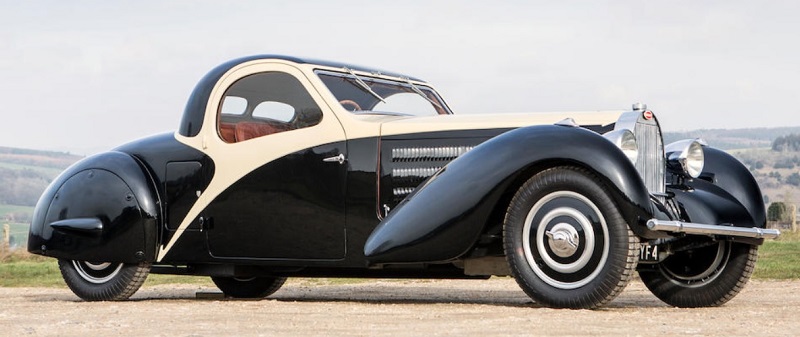
September 14, 2019
Bonhams Goodwood Revival Sale, Chichester, Sussex, UK, September 14, 2019
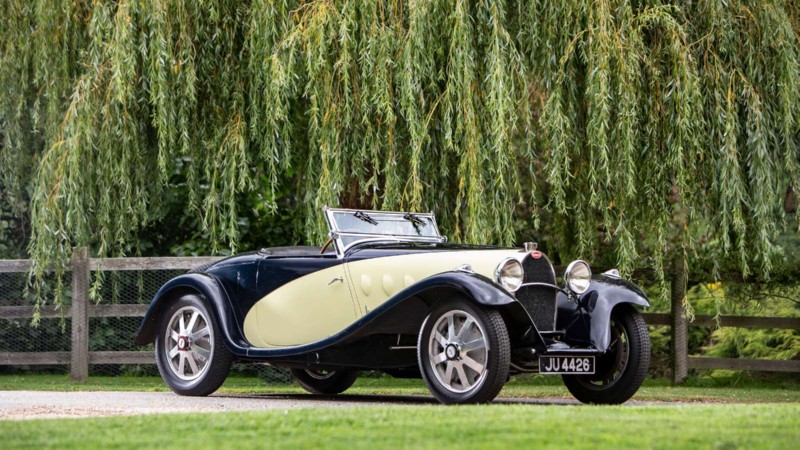
September 14, 2019
|
Bonhams announced that one of the most famous Type 55's will be the star at their 2020 Grand Palais Sale.
1931 Bugatti Type 55 Roadster |
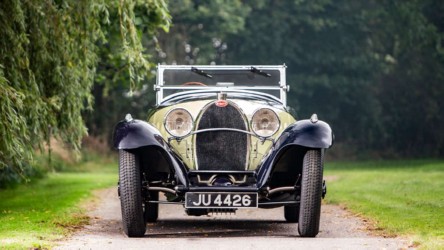
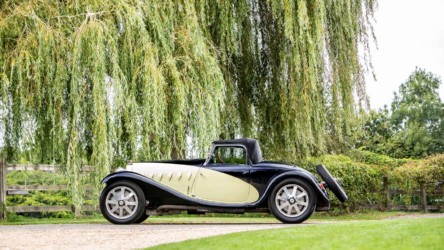
|
At a media preview of the Bonhams Goodwood Revival sale, the auction house unveiled the 1932 Bugatti Type 55 – a car as coveted today as it was in its heyday. Following 56 years in the ownership of one British family, Chassis no. 55221 will be offered for the first time at auction next year. One of only 38 examples of the Type 55 Super Sports model produced between 1932 and 1935, it one of just 29 known surviving models Powered by a 2.3-litre, supercharged, twin-cam, eight-cylinder engine – a detuned variant of the engine in the Grand Prix-winning Bugatti Type 51 – at launch, the 110,000 FF ($7,500) model boasted blistering acceleration, covering 0-60mph in 13 seconds and setting a new road car top speed of 115mph. To the discerning motor car fan, the Type 55 was a wolf in sheep’s clothing, a Grand Prix challenger in a sports car body. This fine example started life as a works entry in the 1932 24 Hours of Le Mans, driven by charismatic French racers Louis Chiron and Count Guy Bouriat-Quintart, and fitted with a temporary four-seater body in order to meet the event’s regulations. Unfortunately, the fuel tank split after three hours’ racing, and the Type 55 was forced to retire. Fresh from Le Mans, Count Bouriat sold the Bugatti to wealthy French magazine publisher Jacques Dupuy, who immediately did away with the much-praised, doorless body, designed by Jean Bugatti, son of Ettore. Instead, he commissioned noted Parisian automotive designer Giuseppe Figoni to create a unique two-seat Type 55 coachwork, including full doors complete with wind up windows, providing ease of access and protection from the elements while retaining a continuous bodywork. Many argued that Figoni’s design considerably improved upon Jean Bugatti’s work. New owner Dupuy then entered the Type 55 into the 1933 Paris-Nice Rally, La Journée de l’Elégance et de l’Automobile au Bois de Boulogne concours d’élégance. Predictably, it excelled in all three. The Second World War put a stop to all racing activity, and in 1962 the Bugatti was brought to England by A.A. Morse, who the following year sold it to leading Vintage racer Geoffrey St John in 1963. And in the St John family hands it has remained ever since, receiving first a restoration in 1966, and once again thirty years later following a road accident in France. Following this accident, the chassis was painstakingly repaired by specialist Gino Hoskins. Of the rare auction piece, Director of Bonhams UK Motor Cars Sholto Gilbertson commented: “This is a once-in-a-lifetime opportunity to acquire an extremely historic and important motor car owned by the same family for 56 years. “Over the years, the family have resisted many offers and we are very much looking forward to presenting the Bugatti for sale in Paris next February. Everyone will now have an equal opportunity to secure one of the most important motor cars to come to market in recent years.” The auction will take place in Paris, France, on February 6, 2020.
|
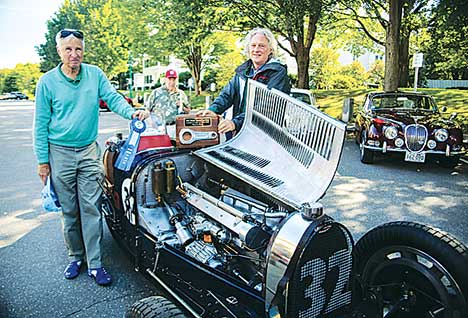
September 14, 2019
Maine owners of British and European sports cars, saloons and touring cars competed for prizes and recognition Sunday, September 1, in the 18th Annual Camden Foreign Car Show, sponsored by the Mid Maine Sports Car Club.
From this year’s field of 42 cars the winners were:
Entry fee proceeds go to local charity. For more information on the club visit mmscc.com.
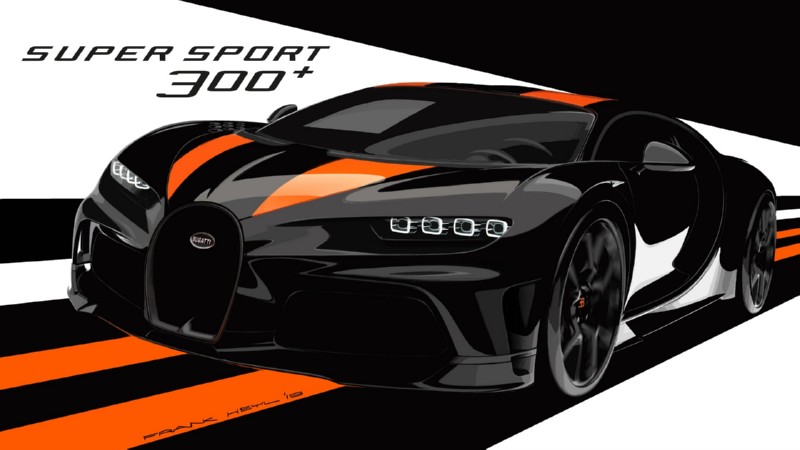
September 14, 2019
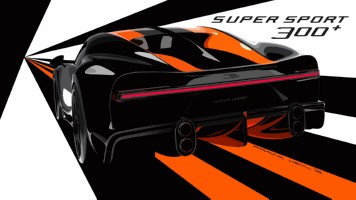 BUGATTI CELEBRATES 110 YEARS IN MOLSHEIM, SHOWCASING THE NEW EDITION MODEL SUPER SPORT 300+
BUGATTI CELEBRATES 110 YEARS IN MOLSHEIM, SHOWCASING THE NEW EDITION MODEL SUPER SPORT 300+Nobody is faster. Just a few weeks after the sensational record-breaking run undertaken by Bugatti – when for the first time a hyper sports car drove faster than 300 miles per hour – the French brand is showcasing a very special edition based on this new Chiron derivative: the Bugatti Chiron Super Sport 300+. Last Saturday evening, Bugatti presented the new model to a selected group of customers as the highlight of the celebrations to mark the 110 anniversary of the tradition-steeped company in Molsheim. The Chiron Super Sport 300+ played a very special role among numerous historic Bugatti models and the current Bugatti hyper sports cars of modern times, such as the Divo, La Voiture Noire, and the Centodieci.
“After the incredible speed record of more than 300 miles per hour, which we were the first series manufacturer to achieve, we're now offering our customers the Super Sport 300+ – a very special edition model and the fastest Bugatti ever”, says Stephan Winkelmann, President of Bugatti. “But the Chiron Super Sport 300+ is more than just the fastest series-production sports car in the world. It is a testimony to Bugatti's technical refinement, masterly workmanship and enormous attention to detail.”
The body is made of exposed, jet-black carbon fibre set through in the centre with racing stripes in Jet Orange. The interior is dominated by black carbon, leather and Alcantara in Beluga Black, complemented by colour highlights in Jet Orange. On the carbon door sills, the exclusive lettering likewise radiates in this colour, as do the headrests, the knee support in the centre console and the fine double-stitched seams. All interior trim parts on the other hand have a black anodised finish, while the rear-view mirror and centre line are painted in Beluga Black. “With the Super Sport 300+ we pay homage not just to our glorious history with its numerous speed records but also to the performance of the entire record-breaking team. They were the ones who tackled the challenge of driving over 300 miles per hour,” says Stephan Winkelmann, President of Bugatti. “For this reason, the Super Sport 300+ is more than just an edition. It is by far the fastest luxury hyper sports car in the world and a genuine Bugatti in every fibre of its being – uncompromisingly beautiful, fast, comfortable and exquisite.” The Super Sport 300+ was showcased on Saturday evening as the grand finale of the Grand Tour, a rally that takes in the most important stages in the life of Ettore Bugatti – from Milan via Monaco and Paris to Molsheim in Alsace. The first vehicles of the limited edition model Super Sport 300+, restricted to 30 units, will be delivered to customers at a net unit price of 3.5 million euros in mid-2021.
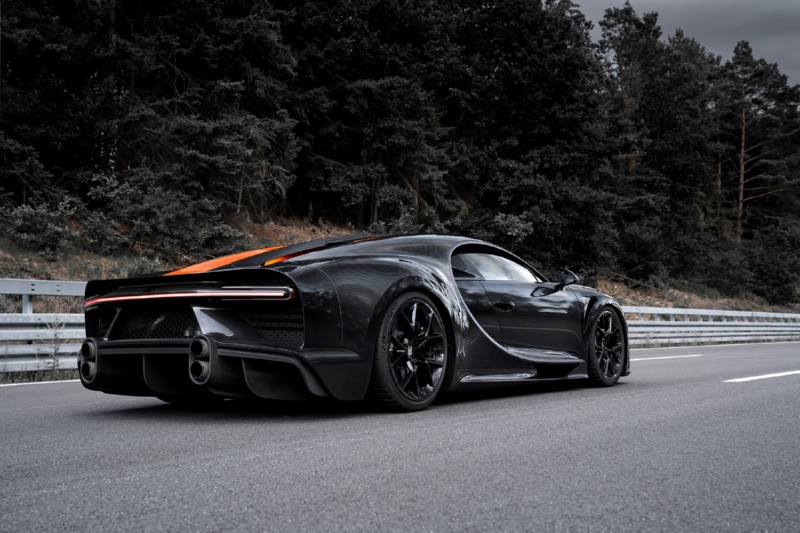 French engineering has been known to produce some of the finest luxury vehicles. From Bugatti cars to Prestige Yachts, designers in France truly know what luxury is meant to be. Many of these companies operate along the coast near Marseille or Grasse where the climate is pleasant. |
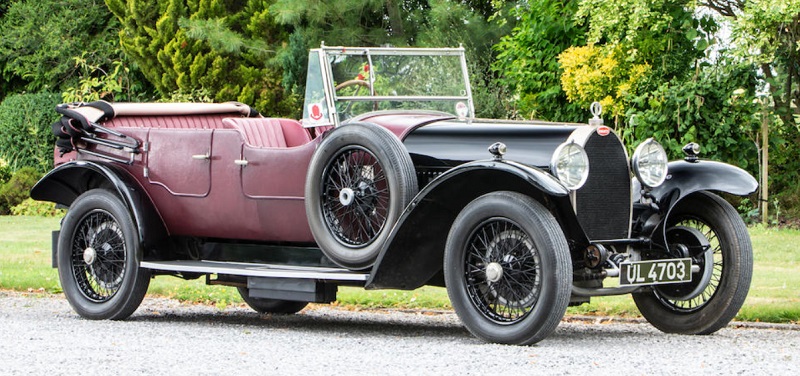
September 10, 2019
Bonhams The Beaulieu Sale, UK, September 7, 2019
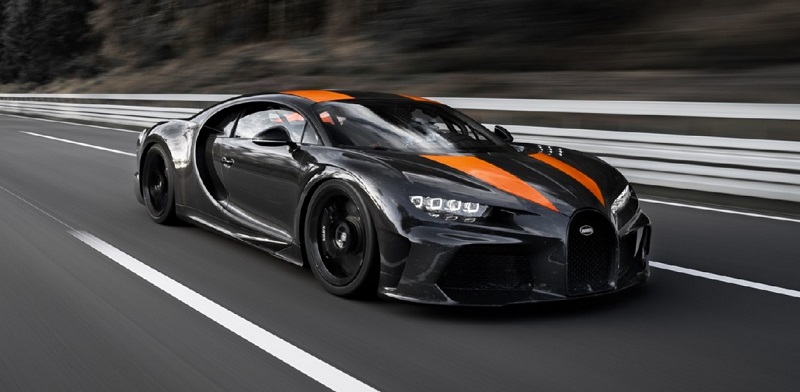
September 2, 2019
Source: Car and Driver Website.
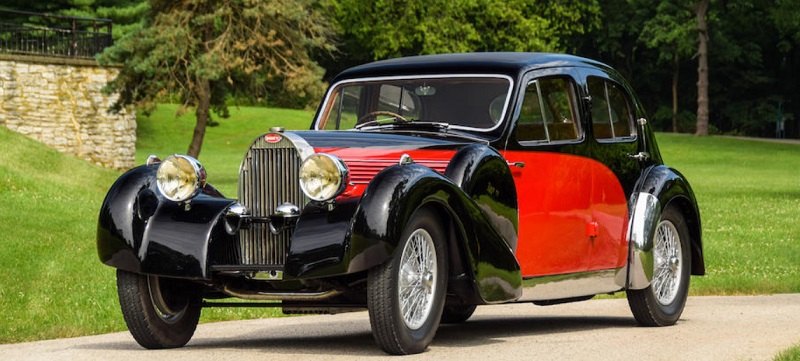
August 26, 2019
RM / Sotheby's Pebble Beach Auction Monterey, CA, USA, August 15 - 17, 2019
Bonhams Quail Lodge Auction California, USA, August 16, 2019
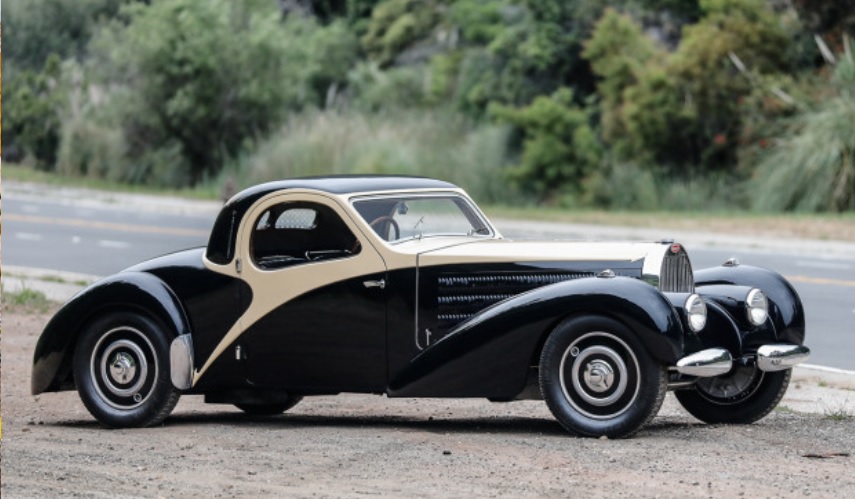
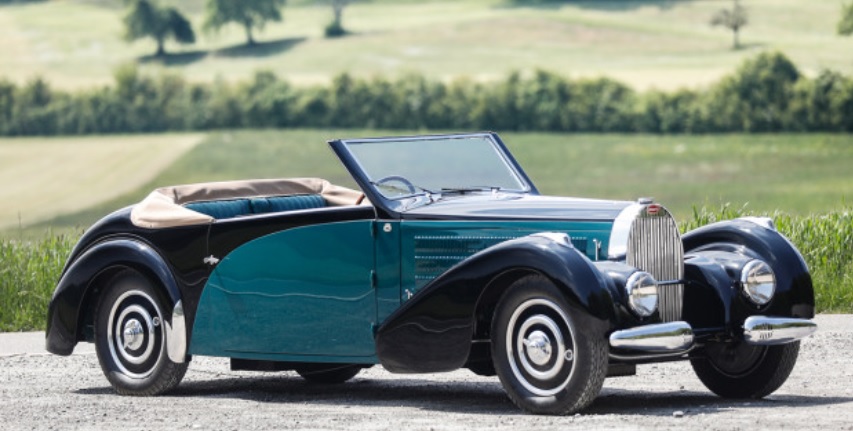
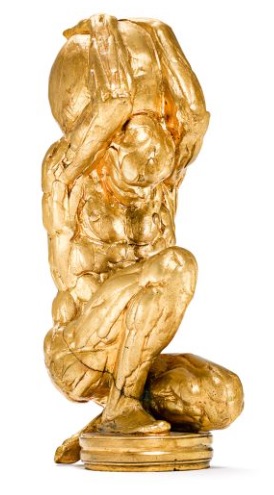
Gooding & Company Pebble Beach Auction Pebble Beach, California, USA, August 16-17, 2019
Koller International Auctions Switzerland, June 27, 2019
|
All Bugatti Automobiles were sold, though be it quite a bit below their estimates, with an incredibly cheap Galibier. And remember; the estimate is usually without premium, while the sell price usually is including premium of about 20 - 25%.... Prices seem to continue going down (though some estimates were rather optimistic!). It is time to switch from Ettore to Rembrandt Bugatti.... Low prices for automobiles however is something seen in most auctions... Classic cars rarely go over their estimates, and usually are much more closer to their lower estimate, than to their higher estimate. |
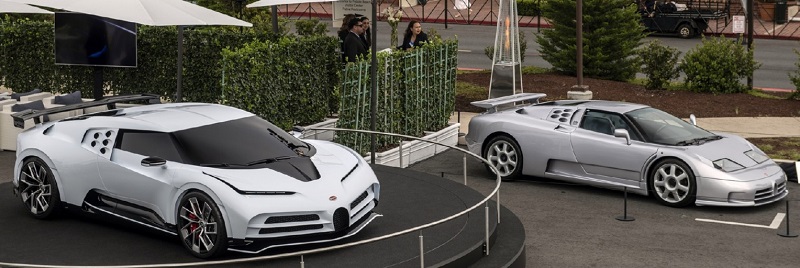
August 26, 2019


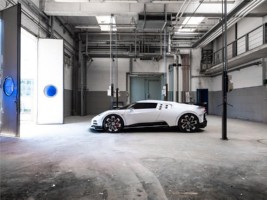
|
Info from Bugatti
FRENCH LUXURY BRAND ECHOES HISTORIC SUPER SPORTS CAR EB110 “We are proud of our long Bugatti history, of which the EB110 is very much a part. That’s why we’re celebrating a reinterpretation of this extraordinary vehicle with the Centodieci – Italian for 110,” says Stephan Winkelmann. The EB110 was built in Campogalliano, Italy, but from the very outset it never denied its French influences. Former owner Romano Artioli opened the factory on Ettore Bugatti’s 109 birthday – 15 September 1990. Artioli made a deliberate choice in opting for Campogalliano, a small town in Emilia Romagna. The location had a key advantage in the 1990s: it was in the catchment area of several Italian sports car brands, so Artioli was easily able to recruit experienced employees for his project. Artioli presented the super sports car EB110 to the public on Ettore Bugatti’s 110 birthday – hence the type designation: EB for Ettore Bugatti, 110 th for his 110 birthday.
|
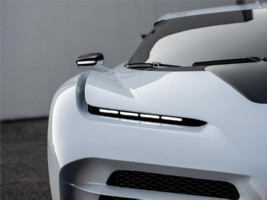
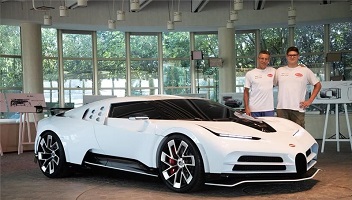
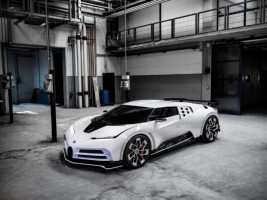
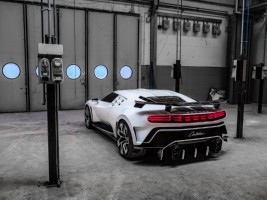
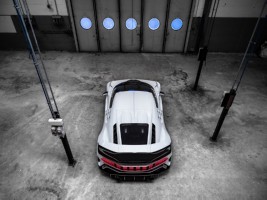
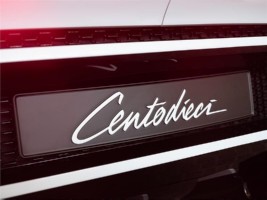
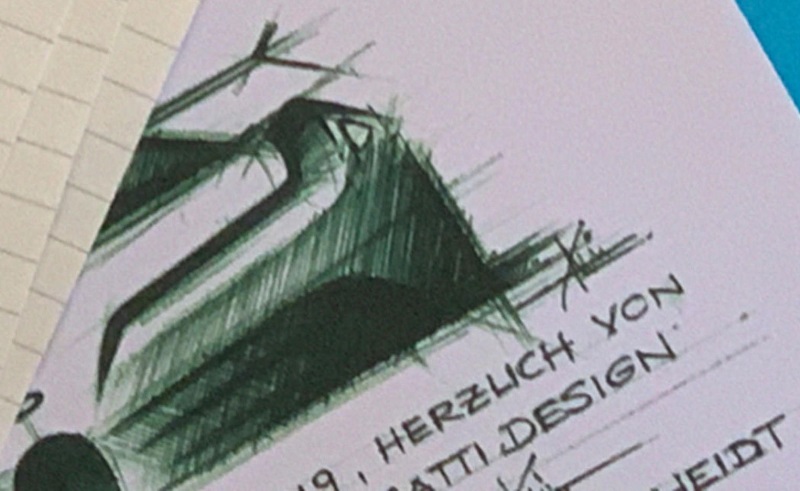
August 9, 2019
|
After presenting the light-weight (several pounds lighter!) Divo and later "La Voiture Noire" shown the first time at the 2019 Geneva Motor Show, Bugatti is to present a
new version of the 1500 HP Chiron, next week at Pebble Beach. Before presenting "La voiture Noire", the new VW-Bugatti company showed a lot of information and history about the T57SC Atlantic, which turned out to be the inspiration for that new design. This time, Bugatti showed the last month a lot of images and info on Romano Artioli's EB110GT and EB110SS. Also, this year is the "110th anniversary" of the Bugatti brand, thus using the EB110 as inspiration for the new version of the Veyron would make sense. During a recent interview, the EB110’s creator (below) revealed he would love to see Bugatti develop a tribute to the mid-engined supercar. So far, Bugatti hasn’t released any teaser photos of the new model, but Germany’s Auto Motor Und Sport has managed to obtain a partial design sketch (shown above) allegedly produced by Bugatti chief designer Achim Anscheidt, potentially showing what Bugatti’s next hypercar will look like. Auto Motor Und Sport believes the internal design sketch was used on a greeting card from the Bugatti Design Studio, but this hasn’t been confirmed. Using the design sketch as a basis, the German publication has mocked up a render (pictured above) showing what the new hypercar tribute could look like when the covers come off at Pebble Beach. Shown from the front, the distinctive crossbars in the grille are clearly inspired by the EB110 Super Sport but the quad headlights on each side of the hood have been vertically stacked, resulting in a striking appearance. We'll have to wait and see if the final car's design matches the render. Well; luckily we do have a photograph of the finished car, be it just a part of it.. See below, this is one of the wheels, apparently of novel design, see below. In fact, it seems that part of the wheel is in fact located behind the large brake disc.
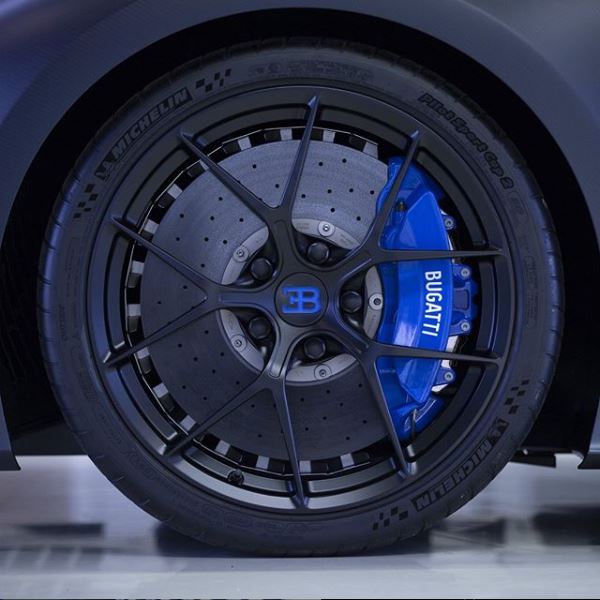 As proof that the current Bugatti does seek for inspiration in the EB110, are the photographs below of a Chiron alongside two racing Bugatti EB110SS's (Le Mans and IMSA, see this article from 1996 in the Bugatti Revue for more info), inside and outside the old Campogalliano factory, which in fact still exists and was not touched since it closed in 1995.. Romano Artioli was interviewed not long ago about what he thinks of this new revival. He is the Italian entrepreneur who revived Bugatti in the 1990s and launched the EB110 before it went bankrupt. A few years later the company was acquired by Volkswagen and launched the Veyron. He has revealed what he thinks about a modern interpretation of the EB110.
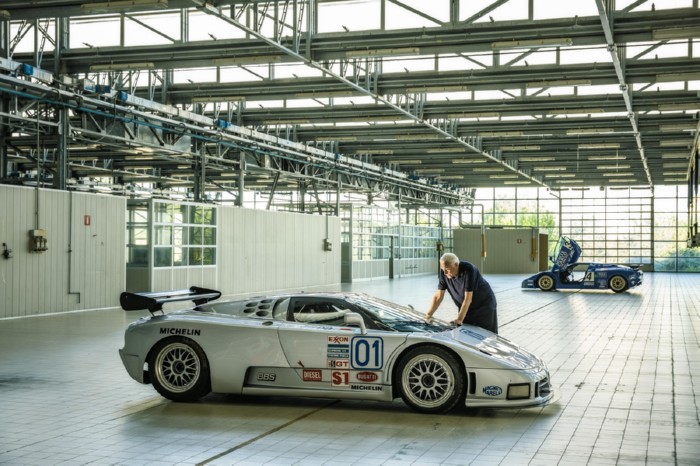 "I have read the rumors about a new Bugatti being presented in Pebble Beach and it being inspired in the EB110. I don’t know if that’s the truth, but if it were, it would mean a lot to me, to my whole family, and to my old companions at Bugatti Automobili,” he said. "The EB110SS was designed to last for a long time, into the future, and for this reason all the technical solutions that had been anticipated, today are present in the new Bugatti cars. I would be very pleased if even the design of the possible future Bugatti was inspired by the EB110SS, which is still contemporary. La Fabbrica Blu in Campogalliano, the EB110, but also the Lotus Elise - these were a dream come true for me, my life’s work.” Artioli recently came out with a book about these times. While Artioli doesn’t know if the rumors are true, he believes the EB110 SS is long overdue a tribute car. "The EB110 was a car ahead of its time, 110% worthy of carrying the name Bugatti. I might not be the most impartial person in this matter, but no other car deserves a tribute more than the EB110.”
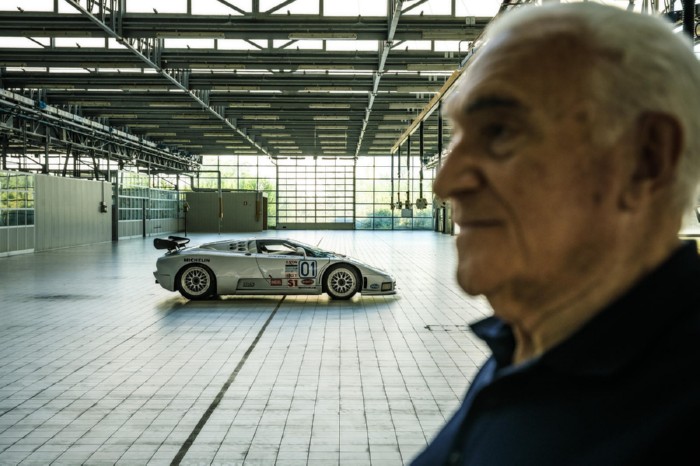 The EB110’s distinctive design was the work of Giampaolo Benedini. Artioli says he would like to see some of the car’s design elements applied to a modern car. "Giampaolo Benedini finished the design of the EB110 - as an architect! That’s quite uncommon in the automotive world, and it resulted in a very distinguished design of this super car,” he explained. "The styling of the EB110 - especially evident in the Super Sport version - is a very graphical one. The memorable, graphical elements make it truly iconic. This Bauhaus style inspiration before that art tendency became popular. Also, design-wise, the EB110 was ahead of its time and nothing but a trendsetter.”
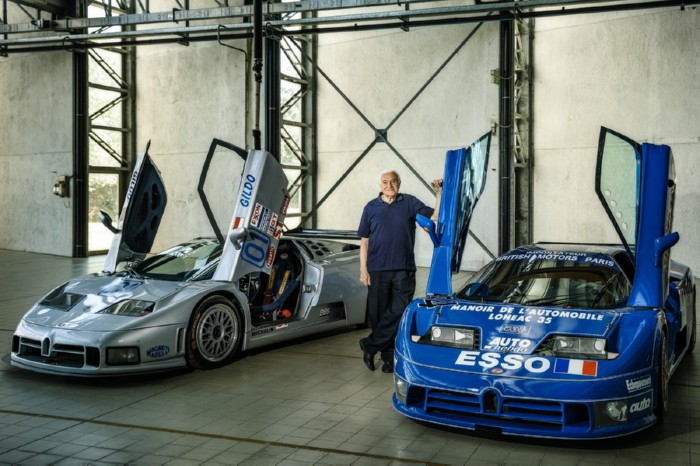 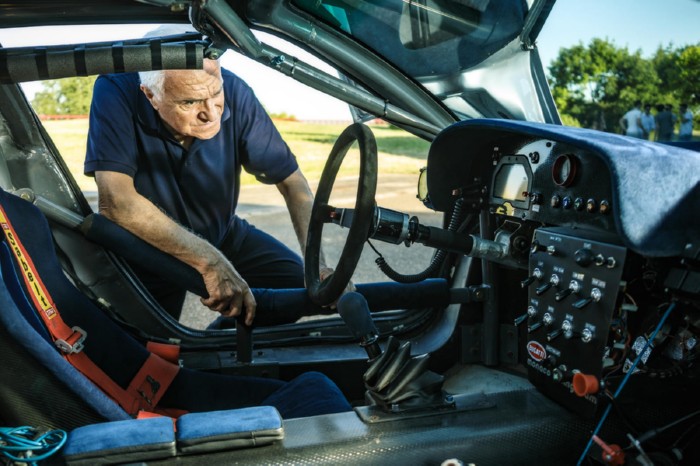 Today, Bugatti is better known for the Veyron and Chiron hypercars after the company was acquired by Volkswagen in 1998. But what does Artioli think of Bugatti’s current design direction? "Ferdinand Piech, maybe the last "Patron” figure of today’s automotive world took over the brand, and has it shaped to his idea, but always with respect of the long and proud Bugatti history. I think that’s the most important point.” "The Veyron was and the Chiron are the absolute pinnacle of the automotive industry, the most powerful and the fastest supercars. By the way, the fact that Loris Bicocchi, our main test driver for the EB110 and employee number 7 at Bugatti Automobili, also helped test drive the Veyron and the Chiron, makes me proud!”
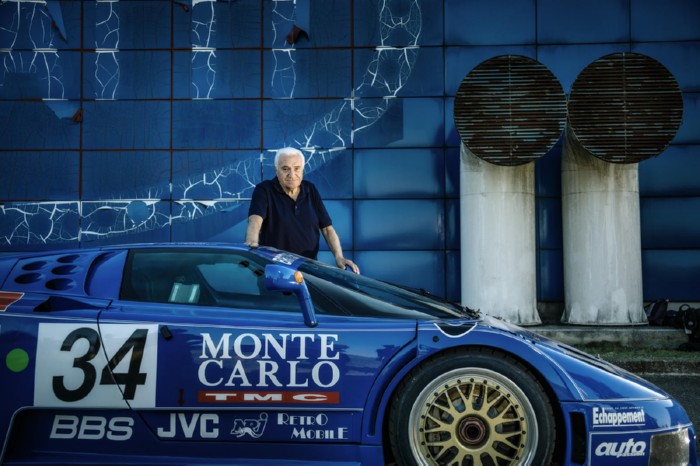 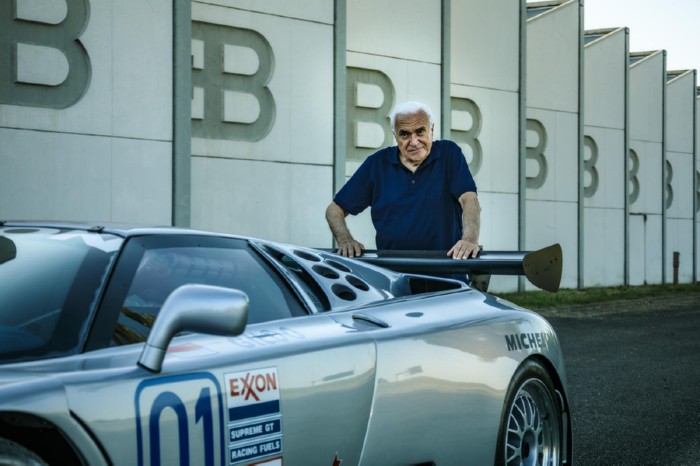 Back in January, Bugatti invited Artioli to Chateau Saint Jean, where he got to drive the Chiron. Was this when Bugatti revealed plans to Artioli to build an EB110 tribute car? "I had never been to Molsheim after Volkswagen had bought the rights to the Bugatti brand. So it was long overdue. It was an amazing experience to be received by Stephan Winkelmann and his team in the Château St. Jean and to test drive the Chiron. We exchanged a lot of ideas and stories, but no tribute or homage project was ever mentioned or presented to me.” We’ll find out if the rumors are true when Bugatti unveils its latest project at Pebble Beach on August 16. Sadly, Artioli won’t be at the show, but he will still watch the premiere. "I wish I could. However, it is a very long journey that would take me away from my current projects for too long. I will, however, sit in front of the laptop to watch the live stream of the Bugatti press conference, as one more Bugatti enthusiast. Maybe even still the biggest one out there…”
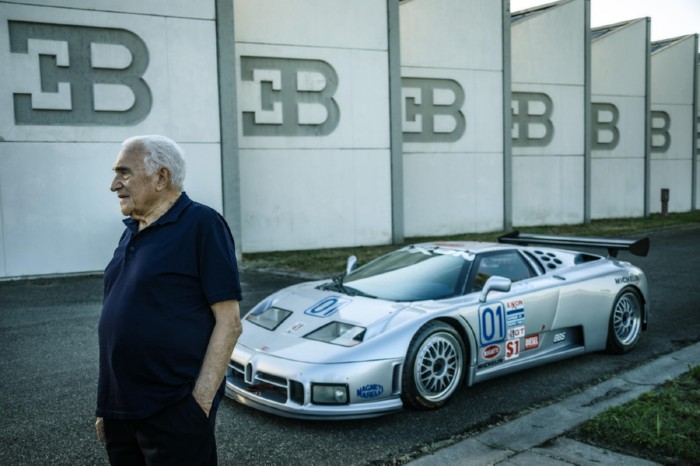
|
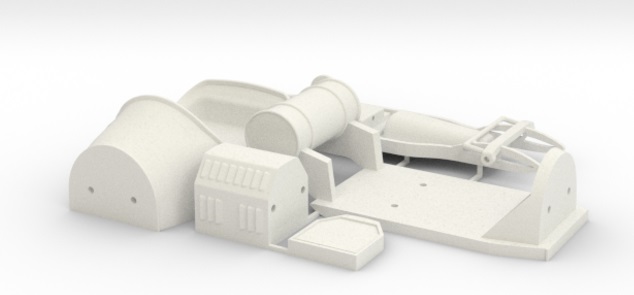
June 28, 2019
...in miniature that is.
I was visiting the old BugattiBuilder website, and found an interesting link.
One hears about 3D printing related to a lot of parts and technologies these days, even the brake parts for a Chiron. However, in this case application is much less structural, but can be fun too.
3D printing enables specific miniatures to be made in small series, with virtually no tooling costs. On this website, there is a listing from different suppliers, with interesting models, even like the T46 wheels for the famous Heller T50 kit.
However, I especially liked the 1911 T13 GP, available in various scales, the biggest being 1:24.
No easy kits though, as these are the basic shapes only, and miss a lot of essential parts (wheels!) and details, which you will have to source elsewhere. Also, the 3D printed material is rather rough, and needs quite a bit of fiddling before it has a smooth surface. Well, plenty of time in these hot summer months, which are too hot to go outside anyway....
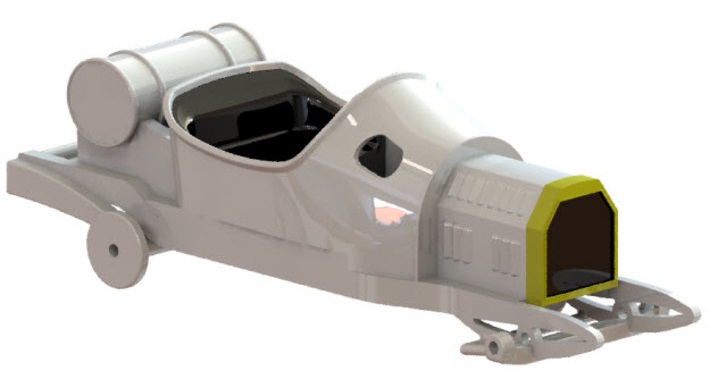
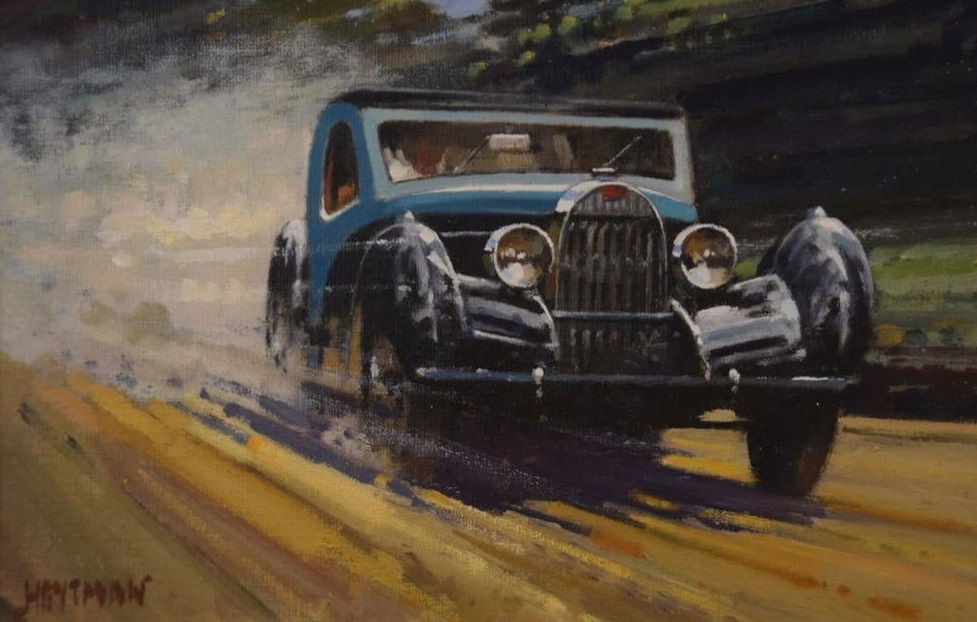
'1936 Bugatti Type 57'
By Willem Heytman
A descendant of the “Dutch Frenchman” J.B. Jongkind (1819-1891), Heytman (born 1950) showed talent early, filling the ages in his exercise books with drawing after drawing between lessons. Soon after leaving school, Heytman started experimenting with pastels, watercolours and oil paint, choosing to concentrate on the last medium in particular. The artist had his first exhibition in 1976 in Middelburg, Zeeland, the Dutch province that has remained his home. Apart from the lessons he took from Dutch seascape painter J.W. Heijting, Heytman is very much a self-taught painter. Innovating and improving continuously on style, use of colour and composition, and boldly tackling almost any theme. His canvases depict a whole rare of subjects, from summer seascapes and beach scenes to winterty cityscapes. Heytman also paints subjects many other painters shrink from, such as cars or trams, devotedly representing his perception of them in oils, Having painted in this way for over 20 years, Heytman has irrefutably carved a niche for himself in the world of contemporary Dutch painting.
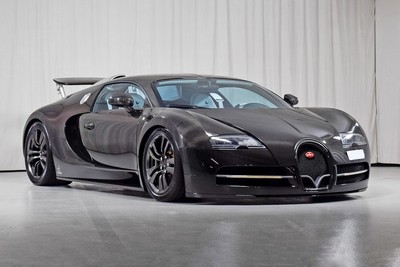
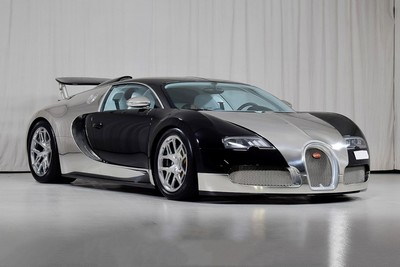
November 22, 2019 Silverstone Auctions Riyadh auction Riyadh, Saudi Arabia
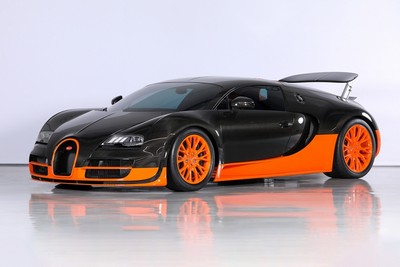
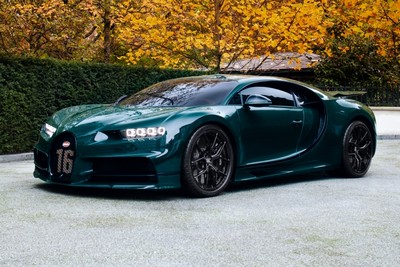
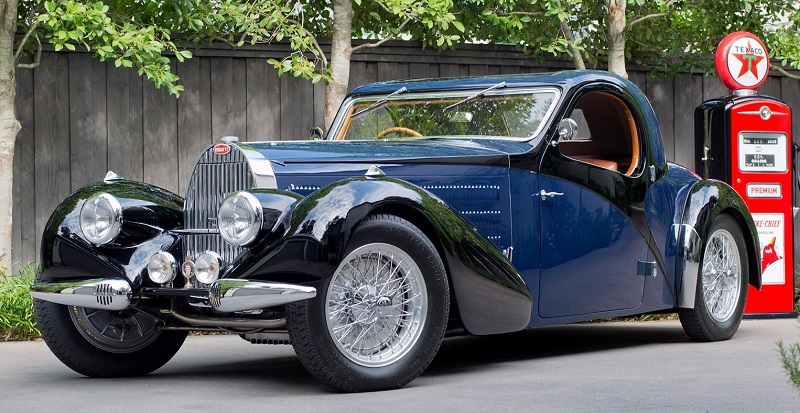
November 23, 2019 Worldwide Auctioneers Riyadh auction Riyadh, Saudi Arabia
| Bearing Chassis Number 57641, this Bugatti Type 57C is a right-hand drive, ‘Series 2’ example, benefiting from numerous upgrades from 1936, including improved engine mounts, detail updates to the camshafts and valve timing, a redesigned exhaust manifold and a modified crankcase with provision for supercharger mounting. Other welcome improvements included adoption of De Ram self-adjusting shock absorbers and a new dashboard with two large centrally placed instruments. Provenance of 57641 is outstanding, extensively documented by Bugatti marque historian David Sewell, who quotes transcriptions of Bugatti factory records stating the car was fitted with engine no. 456 and invoiced as a Type 57 on November 15, 1936 for direct delivery to its first owner, a Frenchman named Baptifaut. Subsequent registered owners included the Joussy family of Paris in May 1937. Chassis 57641 was still located in Paris during the early 1950s, listed as such in “The Bugatti Book,” , first published in 1954 in commemoration of the 25th anniversary of the Bugatti Owner’s Club. According to Sewell, by 1960 Chassis 57641 had passed through seven owners since new and was in the hands of well-known Parisian Bugatti enthusiast, Henri Novo. Sewell states in his report that 57641 was listed in the 1962 Bugatti Register as having a Ventoux drophead coupe body, with a subsequent switch to the Atalante coupé body, “…probably executed by Novo himself.” According to Sewell, eight Atalante bodies were constructed for the ‘Series 1’ cars of 1935 and it is believed only three of them featured the bureau-style “roll-back” roof design. Since only one more was produced for a surviving 1936 ‘Series 2’ car, Sewell concludes that the coachwork fitted to 57641 was taken from a 1935 model. |
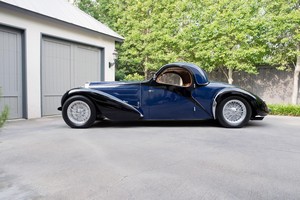
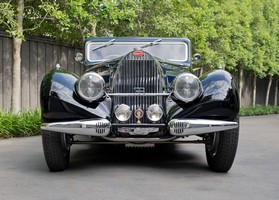
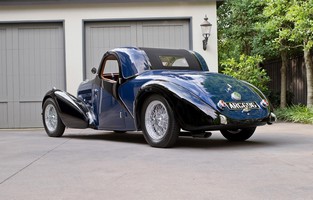
|
Further according to Sewell, who cites Hugh Conway’s 1973-74 update to his original vehicle register in “Bugantics,” the quarterly journal of the Bugatti Owners Club, 57641 is listed with A. Delincourt as the owner. Analysis of Conway’s 1962 and 1973-74 register entries against the factory records for 57641 also led Sewell to state that factory records were in error regarding this vehicle’s original engine number and that the originally assigned unit was switched out at the factory in favor of the engine, numbered 474, powering the car. Also, according to Sewell, the supercharger was a later addition to the car, possibly fitted by Novo when he changed the coachwork. Following its ownership by Delincourt, 57641 was part of the renowned Seydoux-Schlumberger collection in Paris, from which it was acquired by its current owner in 2012 and then given a concours-quality restoration by Bob Smith Coachworks in Gainesville, Texas. Confirmation of this beautiful Bugatti’s excellence was quickly confirmed, with accolades including a perfect judging score at the 2015 Amelia Island Concours d’Elegance and Best in Class at the 2016 Pebble Beach Concours d’Elegance. Beautifully finished and preserved throughout, 57641 is accompanied by a concours tool kit and mounted spare tire inside the trunk compartment. Carrying excellent provenance and expert documentation, this multiple award-winning Bugatti Type 57C is a study in Bugatti’s design and engineering genius on every possible level.
|
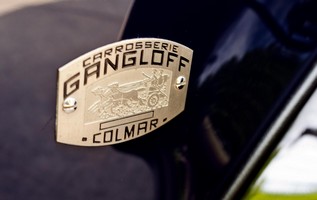
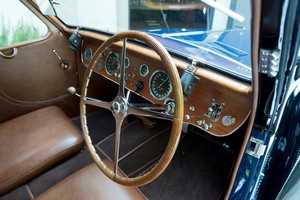
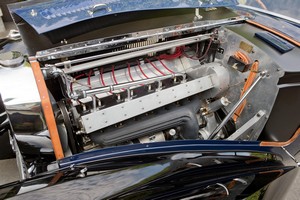
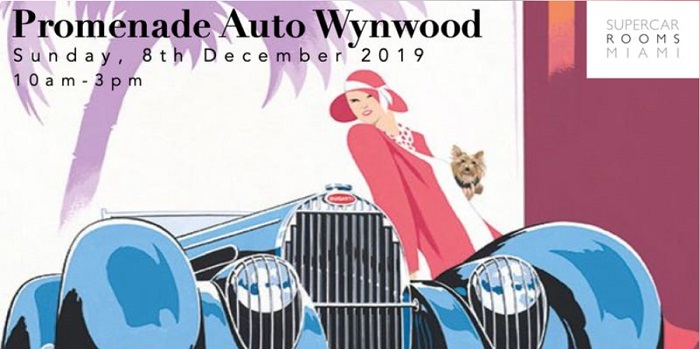
December 8, 2019 Promenade Auto Wynwood 2019 Miami, Florida, USA
Special Guests: Michel and Caroline Bugatti.
66 cars on display!
The event is free and open to the public.
Three blocks in Wynwood will be closed to traffic for South Florida’s Fifth Annual showcase of the region’s finest in “Road Art” collections. More than 66 of today’s automotive gems will be on display from across the state, ranging from classic and vintage antiques, to exotic sports and custom-built Supercars. Collectors and car enthusiasts alike will bring their prized possessions to line the streets in the heart of Wynwood’s arts and entertainment district for more than six hours of eye candy for auto enthusiasts of all ages.
At the end of the day, trophy presentations will be awarded to each exhibitor for ‘Best Art Car,’ ‘Best Supercar,’ ‘Best Classic Car,’ ‘Overall Auto Promenade Champion,’ and “Elo’s Choice’ as part of the annual awards ceremony.


June 19 - November 3, 2019 Exposition: Incomparables Bugatti Cité de l'Automobile, Collection Schlumpf, Mulhouse, France
Exposition including not just the classic and modern Bugatti Automobiles, but also sculptures and furniture.
Thus
Ettore Bugatti, Carlo Bugatti, Rembrandt Bugatti, Jean Bugatti, Roland Bugatti, Romano Artioli and Ferdinand Piëch will be represented.


October 27, 2019 Artcurial "Automobiles sur les Champs" auction Paris, France
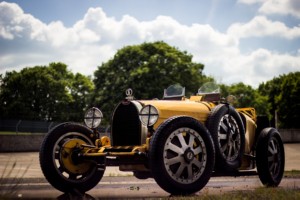
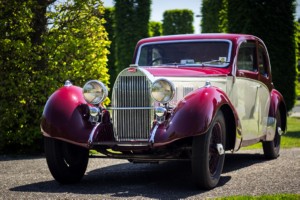
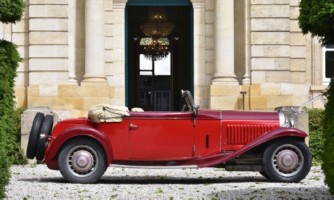
June 22, 2019
Osenat Auction: Automobiles de Collection, June 15, 2019
Arturial Auction: Vente Automobiles en Scène, June 17, 2019
Two out of 3 not sold, at estimates which do not seem to be extremely high. Apparently the reduction in prices of classic Bugattis continues!
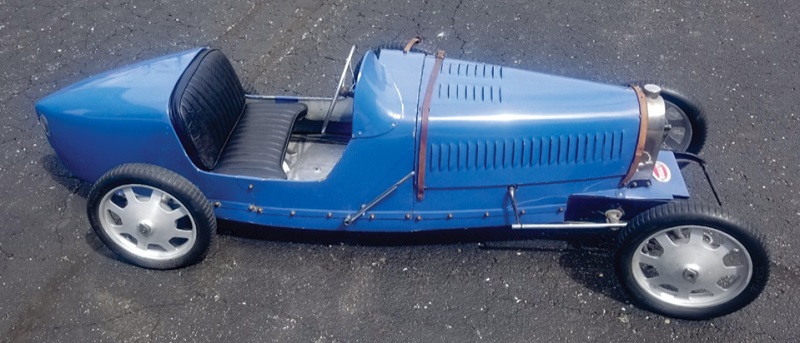
June 8, 2019
RM Auctions - Auburn Spring, May 29 - June 1, 2019
Bugatti 'Baby', c. 1929, Chassis no. 355A
Estimate $18,000 - $25,000: Sold For $31,625 (Inclusive buyer's fee)
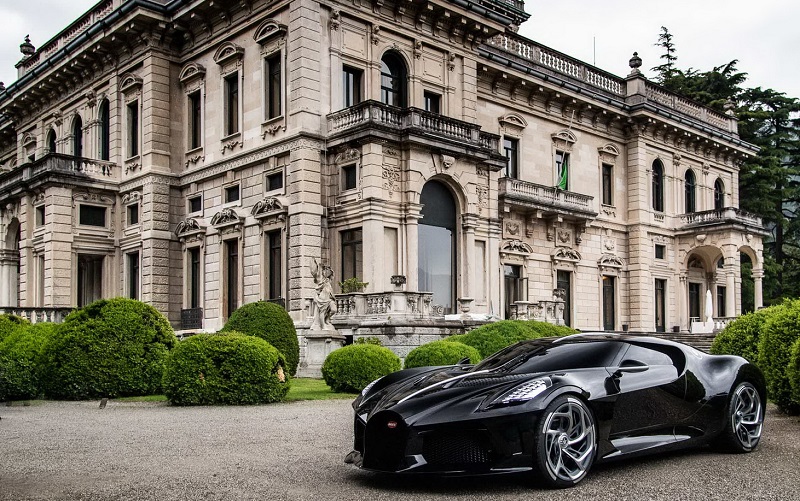
June 8, 2019
|
Bugatti has received the Design Award for the striking La Voiture Noire during its exhibition at the Concorso d’Eleganza event that was held at the shores of Lake Como in Italy. Unveiled at the Geneva Motor Show this year, the La Voiture Noire was created as an one-off to celebrate the brand’s 110th anniversary and pay homage to the legendary Type 57SC Atlantic. Underneath the bespoke bodywork, Bugatti’s latest bespoke creation uses the same underpinnings with the Divo and Chiron, including the quad-turbo 8.0-liter W16 powertrain. Its output remains unchanged, at 1479hp (1500PS) and 1180lb-ft (1600Nm) of torque. ‘La Voiture Noire’ is French for ‘The Black Car’, a node to the second Type 57SC Atlantic that was owned by Jean Bugatti himself and simply vanished, without anyone knowing what exactly happened to it. Bugatti’s modern Black Car has also gained the title of the world’s most expensive new car of all time, as its owner has reportedly paid 16.7 million euros ($18.6 million in current exchange rates) for it. Speaking of its owner, it is believed to be ex-VW Group boss Ferdinand Piech, though that has neither been confirmed nor denied so far. However, the hypercar is far from finished, with the car in the pictures being a prototype powered by a small electric motor for exhibition purposes. The finished item is still two to two-and-a-half years away from delivery, according to Bugatti’s head of communications Tim Bravo, so Mr. Piech, if he is indeed the owner, should be patient. |
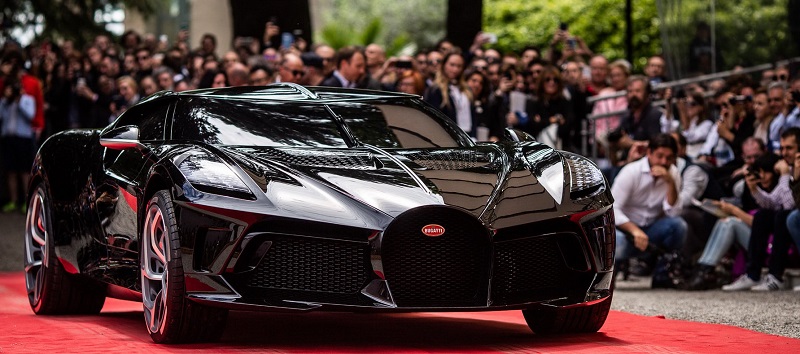

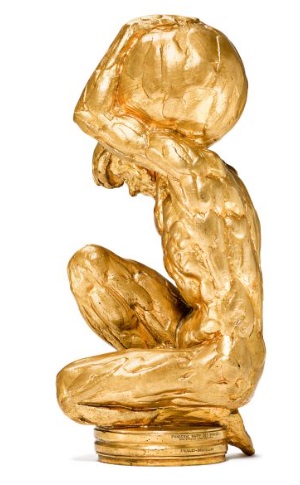
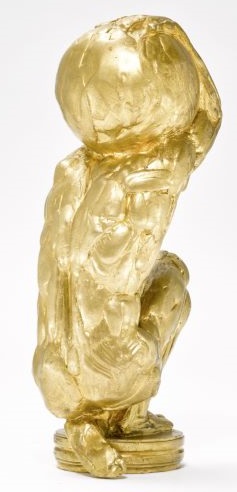
May 31, 2019
Everybody knows the "Elephant" which adornes the Royale's Radiator, and that it was based on a statue by Rembrandt.
However, this is something different, a radiator ornament actually made by Rembrandt as such, in 1913!.
Full description:
REMBRANDT
(1884-1916)
RADIATOR MASCOT "Atlas", ca. 1913.
Gilt bronze. Gilding, supplemented later.
The base inscribed: Fonderie Nationale des Bronzes, Ancienne Firme J. Petermann. St. Gilles-Bruxelles. H 30 cm.
Lit.: Rembrandt Bugatti, Catalogue raisonné, Jacques-Chalom Des Cordes, Véronique Fromanger Des Cordes, pp. 292, 293.
Acquired on 5 June 1984, Maitre Poulain, Ventes publiques.
Unluckily, at some stage the leg broke off, and was crudely repaired. That can be done better, I guess!
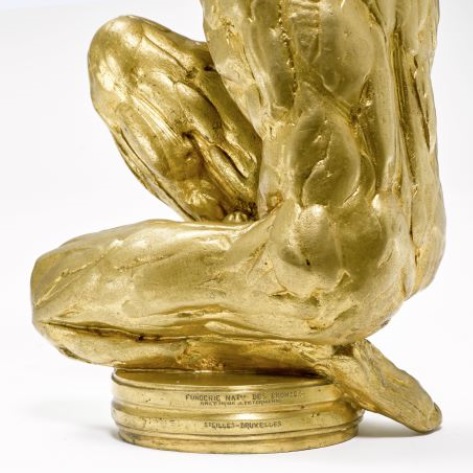
It will be auctioned on June 27, by Koller International Auctions in Switzerland, estimate CHF 10 000 / 15 000 or € 8 770 / 13 160
More info, there are more Rembrandt Bugatti sculptures in the same auction!
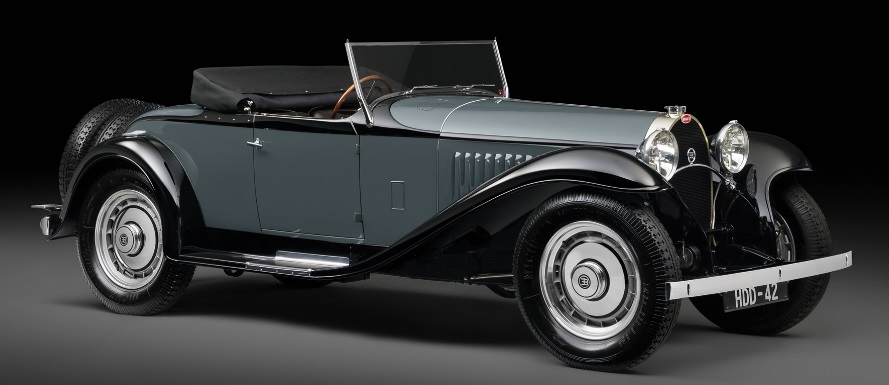
May 30, 2019
RM Sotheby's Villa Erba Auction, May 25, 2019
1931 Bugatti Type 50 Roadster, Chassis No. 50123, Engine No. 18. Estimate: €1.400.000 - €1.800.000, sold for €1.411.250 (including fee)
|
Bugatti is developing a second model to sell alongside the Chiron. While full details about the car remain under wraps, the company's chief executive recently hinted the yet-unnamed model will be completely different than its bigger sibling, and unlike anything else currently sold around the world. "It's clear that when you think about the second model, you always have to see what the body style could be. Believe me, we really looked into every detail of the body style, and I think that there is one that is very promising for a company like Bugatti. It's a body style which is not today on the market," company CEO Stephan Winkelmann told Motor1. He didn't provide additional details. However, his statement seemingly rules out a long-rumored SUV, a sedan in the vein of the 16C Galibier concept, and a Chiron-like coupe. Regardless of what it looks like, it will arrive as a smaller, more affordable, and more daily-drivable car than the Chiron. That doesn't mean Bugatti will go into Toyota Supra territory, though. Its second model will cost at least $1 million. The French automaker previously confirmed its quad-turbocharged, 16-cylinder engine has nearly reached the end of its life cycle. What will power the Chiron's successor remains to be seen, and Bugatti still has time to figure it out, but the second model could go in a completely different direction. "This could be, for example, a full electric car," Winkelmann said. He added a Bugatti-badged EV would need to be "the best of its kind." |
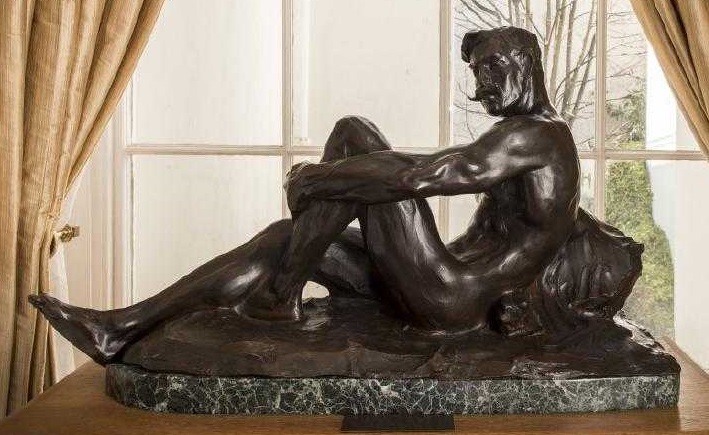
May 19, 2019
|
Rembrandt Bugatti, 'Athlete nu au repos' ('Naked athlete resting'), c. 1907. Bronze, brown patina on marble pedestal. 42.5 x 76.5 x 31 cm (including marble pedestal). Signed below the athlete: R Bugatti and dated: (1)907 (stamped), lower left of it foundry mark of A.A. Hebrard Cire Perdue and numbered: 1 (stamped). Originally it was intended to realise the 'Athlete nu au repos' three times. According to the catalogue reaisonne and the current research this is the only copy. Estimate €1,000,000 - €1,400,000
Quittenbaum Kunstauktionen GmbH, Munich, Germany |

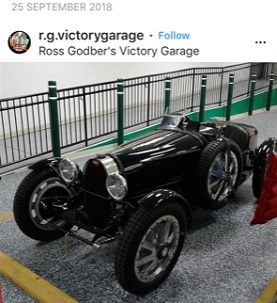
May 13 / 19, 2019
|
According to various reports, a fire on May 8 in a two-story self-storage building in Etna,
Pennsylvania, just north of Pittsburgh, reportedly destroyed more than 200 vehicles, many of them collector cars, including a 1920s-era Bugatti reportedly worth $2 million. According to the Allegheny County Department of Emergency Services, the fire started on the building’s first floor when a man was working on a motorcycle that caught fire. Ross Godber, owner of Ross Godber’s Victory Garage, said he "was working on a Bentley in his space on the first floor of the warehouse when he heard several loud bangs,” the newspaper reported. “Mr. Godber’s space was near an exit, so he got into a Ferrari and drove it out of the building. He ran back inside to try to save the three other vehicles he was working on – the Bentley, which he said was worth $325,000 when it was new; a 1947 Dodge sedan, which was in the middle of restoration; and a 1995 Ford F-250, which he was trying to convert into a monster truck – but the flames and smoke were too strong. Mr. Godber said he thinks the Ferrari might be the only vehicle that survived the fire. He said he has heard that the vehicles lost in the fire total around $60 million. From Hubert Lance Huet I received the photographs above of the Bugatti T35B which was probably the one destroyed in the fire. I have no further info on this car, and if it is (was...) original or not.
|
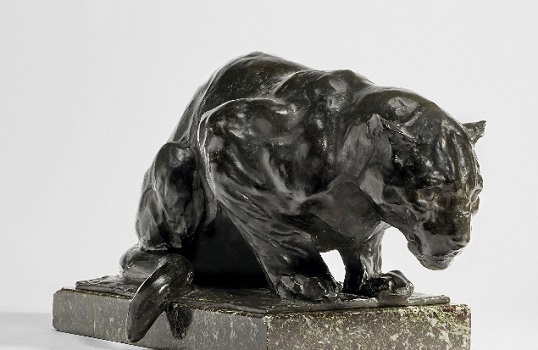
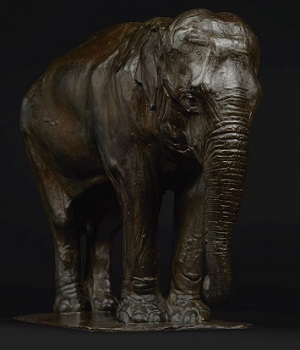
Now is you opportunity to acquire one of these Brilliant Rembrandt Bugatti sculptures!
On the left: 'JAGUAR ACCROUPI', GRAND MODÈLE, approx. 1907
Estimate: EUR 400,000 - EUR 600,000
On the right: ÉLÉPHANT AU REPOS, circa 1909-10
Estimate: 1,057,110 - 1,585,666 EUR
These are on auction by Christie's respectively Sotheby's.
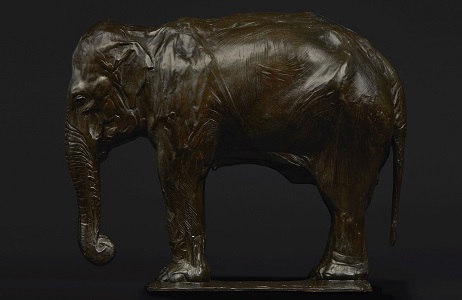
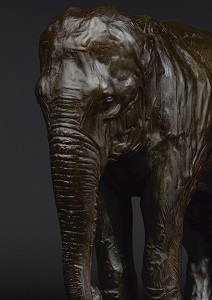
Christie's link
Sotheby's link
I believe this was the first time I instructed a Bugatti owner to buy a Jaguar.....
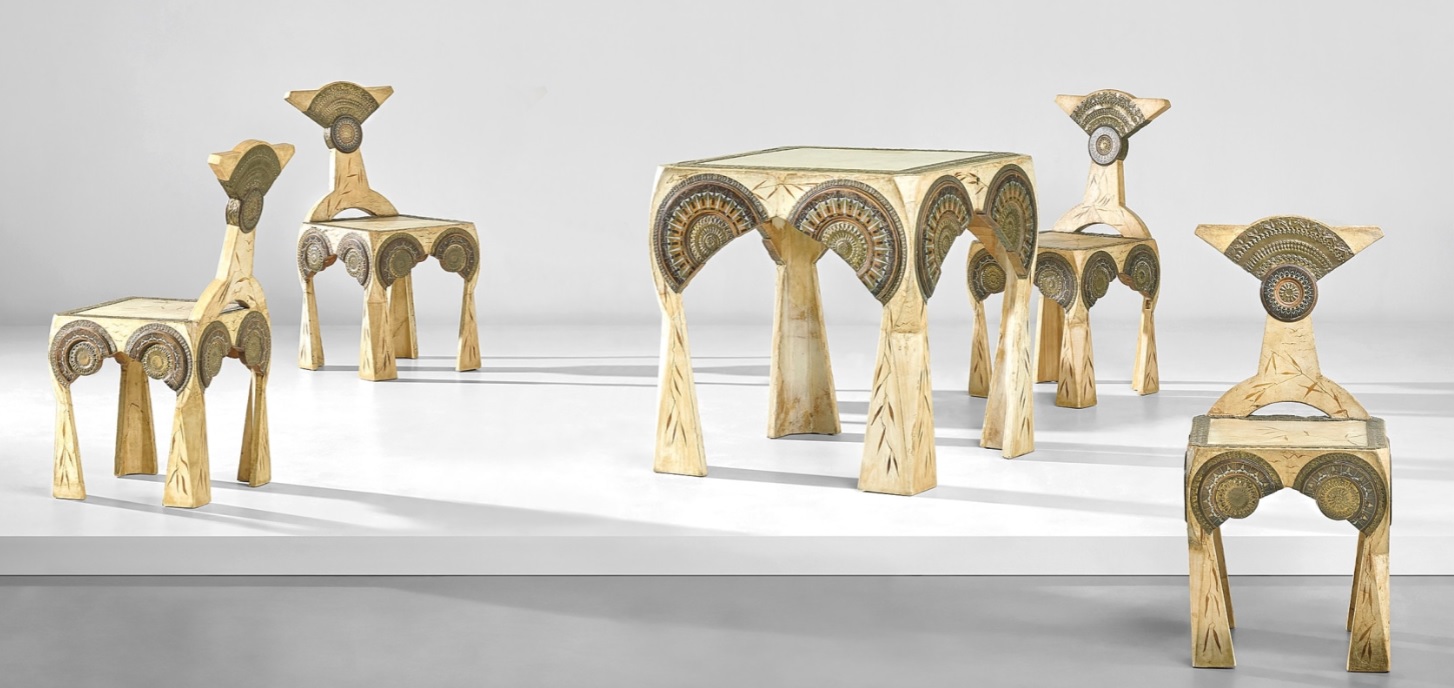
Phillips auction, London, March 21
Carlo Bugatti game table and chairs, 1902, Estimate £80,000 - 120,000, sold for: £93,750
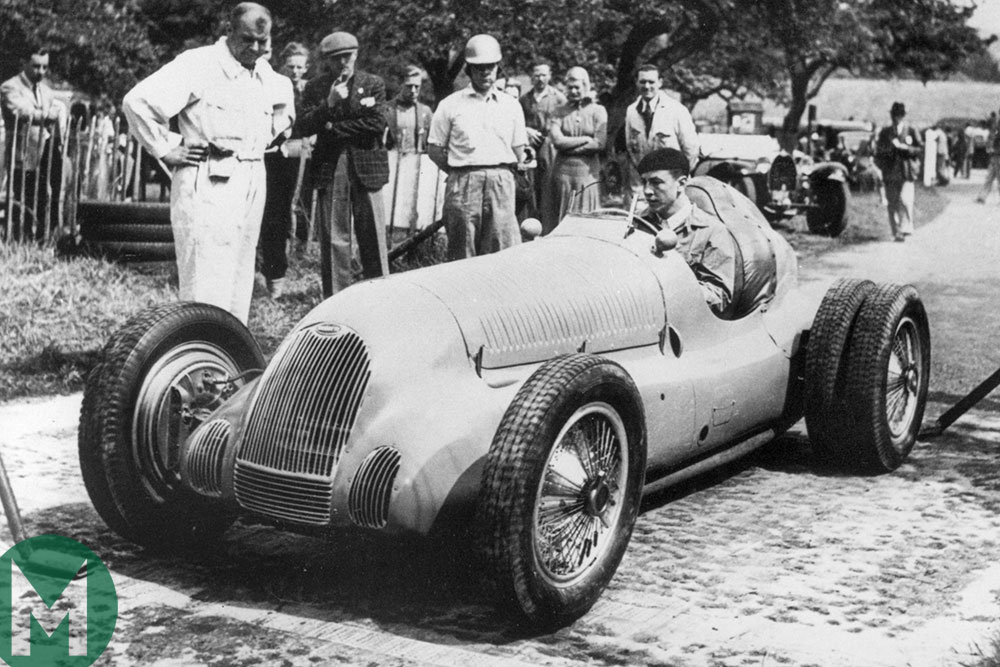
|
A world-famous Works 59/50B Bugatti is set to return to Prescott hillclimb for the first time in 80 years, as part of a special exhibition this summer that celebrates the Bugatti Owners' Club's 90th anniversary. The car will be on display at the Bugatti Trust as part of its summer exhibition 'Jean Bugatti and Jean-Pierre Wimille – Prescott 80 years ago', which will run until September this year. The exhibition is one of a number of festivities marking 90 years since the founding of the Bugatti Owners' Club, the oldest Bugatti club in the world. The club also owns and operates Prescott, as well as being based there. This year also marks the 80th anniversary of a remarkable part of Prescott's history. On Sunday July 30, 1939, it held its first ever international meeting, a Bugatti Owners' Club event, and this very returning Works monoposto Type 59 fitted with an 8-cylinder supercharged 4.7-litre type 50B engine Works 59/50B Bugatti not only took part, legendary grand prix driver Jean-Pierre Wimille was behind the wheel. Jean Bugatti accepted an invitation to attend the 1939 Prescott hillclimb meeting and he brought with him his famous works driver Wimille, who was fresh from winning the Le Mans 24 Hours for the second time. The 59/50B had without doubt the most powerful engine built by the factory and was fitted with twin rear wheels specially for the Gloucestershire hill climb's challenges.
Motor Sport's report from the event at the time called it "a truly beautiful car". "Afterwards, Wimille watched other climbs in company with Earl Howe and Jean Bugatti." Despite the unsuitability of his car Wimille still got the event's second fastest time, shy only of Raymond Mays' ERA which stopped the clock at 46.14sec. Afterwards Jean Bugatti wrote to apologise for using such an incompatible car for the course and promised to return the following year with one of his new 1-litre machines. The onset of the Second World War just five weeks later ensured this was not to be; further the 59/50B was only driven one more time, in 1945 again by Wimille at the Coupe des Prisonniers in the Bois de Boulogne in Paris. It was retained by the factory until it was acquired by the Schlumpf brothers for their Cité de l'Automobile museum in Mulhouse, France. It has now been loaned by that collection to Prescott. This year's anniversary events also include the Bugatti Trust joining the festivities of Prescott's popular annual French and Italian themed 'La Vie en Bleu' weekend, taking place on May 25-26. It is anticipated that over 90 Bugattis will be present at that. "We are delighted that the Works 59/50B Wimille Bugatti will make an historic return to Prescott," said general manager of the Bugatti Owners' Club, Chris Rogers. "The Bugatti Owner's Club and Prescott Hill Climb have played a significant role in the history of the car and its famous French driver Jean-Pierre Wimille."
Photographs:
Jean-Pierre Wimille at the 1939 Prescott hill climb in his Works 59/50B Bugatti |
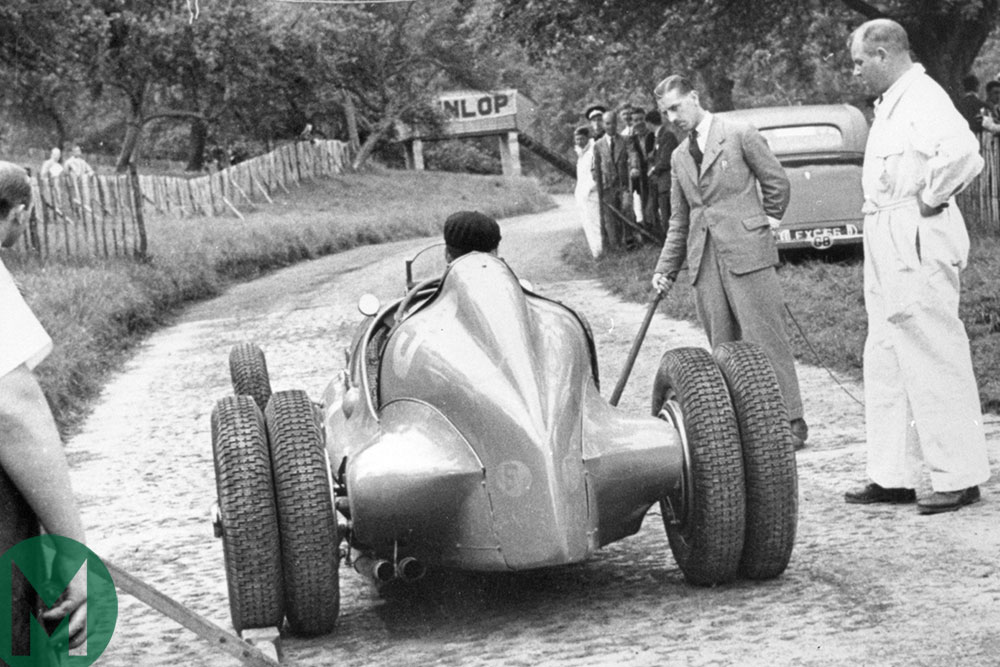
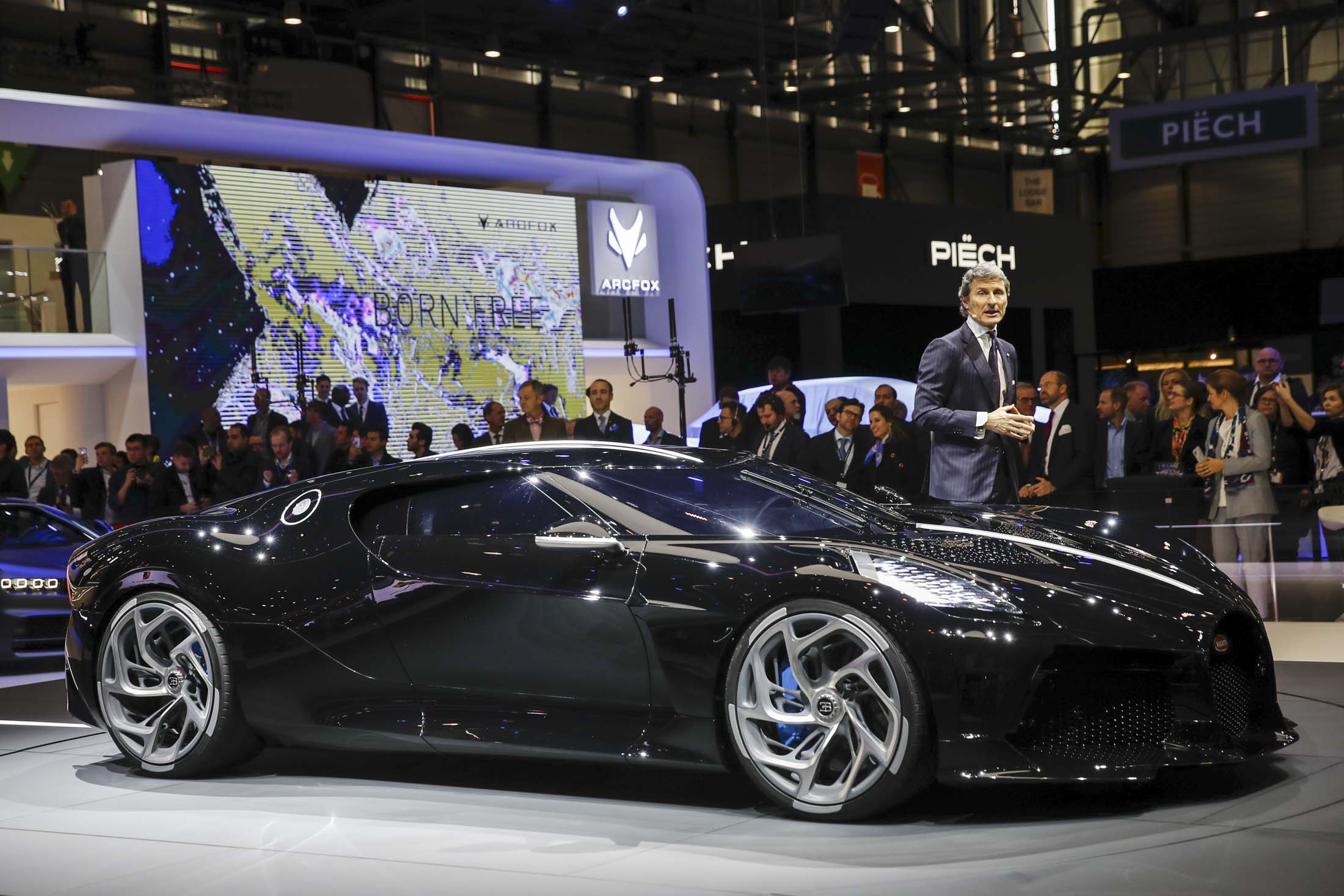
|
According to brand President Stephan Winkelmann, an electric car you can drive every day may soon be in the works. Bugatti is looking to introduce a second, more affordable model of car to its current multimillion-dollar lineup, Bugatti President Stephan Winkelmann revealed in an interview. Winkelmann characterized it not as a mere halo car but as a best-in-segment daily driver with a top-line price to match—and it would be at least partially electric. “There I would see us doing a battery electric vehicle,” he said of the proposed new car. “There, the balance between performance and comfort is much more important, and it’s about daily usability. This is what I see.” Face-melting speed in this second car “will be far less important,” he said. Of course, these terms are all highly relative, considering the US$3-million Chiron comes with 1,500 horsepower and a top speed of 420 km/h. Any new Bugatti will still cost a lot: It stands to reason that even a far “lesser” creation could cost half a million dollars and pack an 800-hp punch. Winkelmann declined to give more specifics about the cost, chassis, and performance of the potential car but said the company has already begun analyzing the prospect. “Let’s see what we can do,” he said. “I’m hoping for the best.” There is room to expand, even with the beaucoup business million-dollar cars like the Bugatti Chiron and Divo already provide. The average Bugatti customer has 42 cars at home, according to a Bugatti spokeswoman, and often two of them are Bugattis. More than half of the 250 Chirons made were purchased sight-unseen—an astounding figure considering the astronomical price tag. In North America and Europe, billionaire populations are are growing by 17 percent and 18 percent respectively, according to Knight Frank’s 2019 Wealth Report. In Asia, there will be 1,003 billionaires by 2023, a 27-percent increase from 2018 and more than a third of the world’s 2,696 total billionaire population. Since 2009, sales of automobiles costing more than $180,000 has quadrupled, according to IHS Markit. “At the end of the day, the difference of the price in a car is the brand,” Winkelmann said of how the new model may be positioned within the Volkswagen Group. “And this I think will stay the same, fortunately for us. I’m convinced about this.” Bugatti would hardly be the first classic brand to attempt evolution and relevance via electric and/or halfway practical vehicles. Ferrari and Lamborghini had long eschewed deigning to make less-expensive sportscars and – gasp! – SUVs in volume plays that would bolster their tiny global outputs (formerly sub-5,000 units). But in the past few years Lamborghini incorporated the Urus SUV into its lineup, and Ferrari executives said last week in Geneva they are working on a hybrid supercar of their own. (Recall, Ferrari introduced the hybrid LaFerrari six years ago.) These moves effected no discernible impact in terms of “damaging” a storied brand. The real challenge will be to develop an electric vehicle with either significantly improved range or more exotic technology than the much-hyped Porsche Taycan, another sibling in the VW Group family and one that will be on the road before the end of 2019. Any new vehicle from Bugatti would likely borrow extensively from VW Group hardware such as the Premium Platform Electric architecture to be used by Porsche, Bentley and Audi—but with a badge like Bugatti’s, it better provide an amplified experience. In the meantime, a lot can happen. Even if Winkelmann gets the green light from Volkswagen AG, the prospect of an underling Bugatti remains far from reality. He doesn’t yet have approval from the Volkswagen board, which can be difficult to procure. It took years of lobbying from Bentley and Lamborghini to get the go-ahead to make an SUV. (For the record, Bentley “won” that battle: It got the okay to make its Bentayga before Lamborghini produced the Urus.) If and when Winkelmann gets a yes, it will take another four years of development before a second Bugatti family line hits the road. Might as well start saving money now.
|
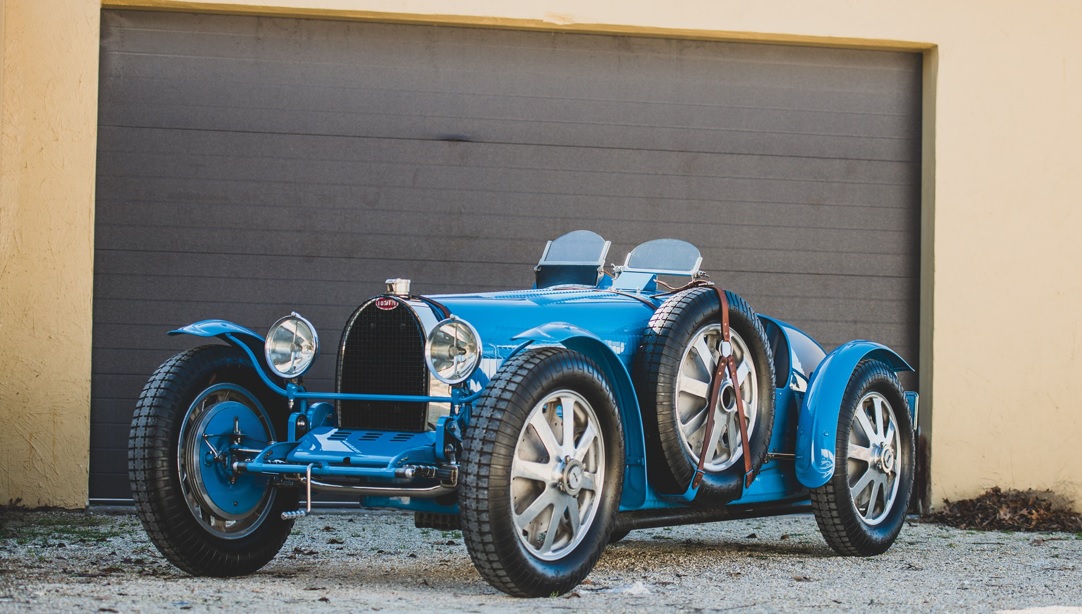
March 11, 2019
RM / Sotheby's Amelia Island auction, March 8-9, 2019
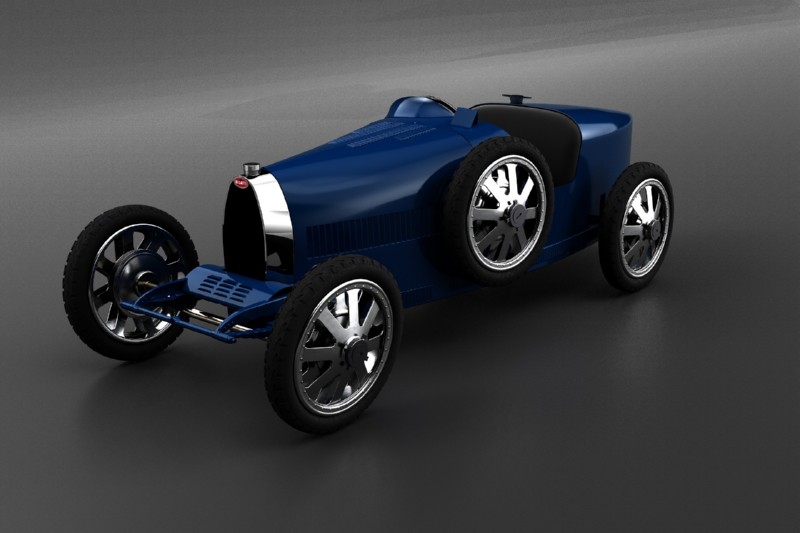
500 limited-edition junior Bugatti cars built to celebrate the brand’s 110th anniversary
Molsheim / Geneva, March 11, 2019. |
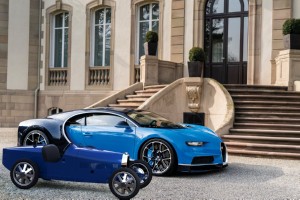
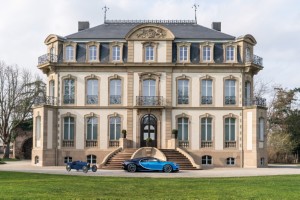
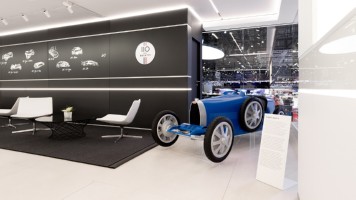
|
Well, this makes sense, the average owner of a Veyron or Chiron will have a bigger lawn than that of a Type 43 or 44 owner back in the 1920's, so a baby Bugatti which is 50% bigger than the original is probably needed. And, at 30000 and over it really is an expensive toy! Now I wonder, having this "unlimited speed" mode with sufficent power, we only have to wait for a special series of races to be organized, as was the case in the first half of the former century. |
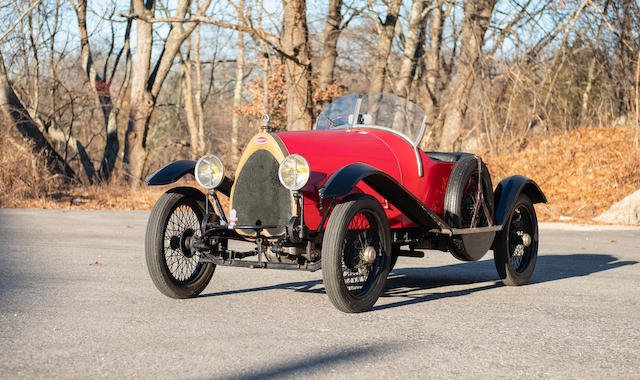
March 9, 2019
Bonhams' Amelia Island auction, March 7, 2019
1923 Bugatti Type 23 Brescia Three Seater Torpedo Sports
Chassis no. BC002, Engine no. 892 (ex-2526), Estimate: US$ 300,000 - 400,000, Sold for: US$ 200,000 (€ 178,221) inc. premium
Seems like someone got a bargain here, or are prices really going down?

|
Bugatti presented the one-off version at the Geneva motor show, which started with the press day today. Not that it came as a surprise, Bugatti had been feeding the hype on the hypercar for several weeks already, showing first the 4 versions of the T57SC Atlantic, and then a series of teasers, showing only a few details of the car.
This most expensive new Bugatti so far, at 11 million euro (before taxes), was specially built for Ferdinand Piëch, who of course was the initator for VW - Bugatti. There are no details given, but the car stands on the Chiron - platform, though it seems to have more visual similarities with the Divo, and thus is a quite expensive body conversion. Do I like it? I don't really know; I do prefer the original "Voiture Noire" T57SC Atlantic. They did go into the trouble to mount the Bugatti registration number 9219-NV2 on the replica Atlantic photographed alongside the new one. This number was used on this Atlantic, but also on a load of other cars, as it was a Factory registration number.
The car has only a few details which could link it with the Atlantic; of course the ridge over the roof which is like a shadow of the fin which the real Atlantic has. Bugatti itself will argue that the roof line is copied from the Atlantic, but one would need some imagination to see that. Furthermore the 6 exhaust pipes, and of course the colour. And yes... Bugatti continues in the error; 2019 is the 109th year of Bugatti. The company did not start before January 1, 1910. Of course Bugatti built his "type 10" earlier, but that was not the start of the company. |
Official Bugatti newsitem:
Bugatti: with our history at heart and our eyes on the future
Molsheim, 5 March 2019. |
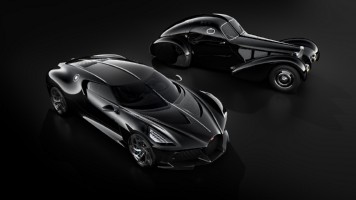
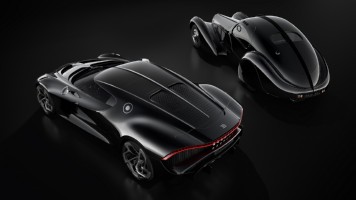
|
“In 2019, we are celebrating a special anniversary. Bugatti was established 110 years ago. These two models pay homage to our long tradition and to our French homeland,” says Bugatti president Stephan Winkelmann. The third model on the Bugatti stand is also in line with this approach: the Bugatti Divo2, is a hyper sports car which is being produced in a limited edition of 40 vehicles. With its modified aerodynamics, it is designed for even higher lateral acceleration than the Chiron3 and ensures extreme driving pleasure. With “La Voiture Noire“, the French luxury automobile brand has once again shown that it produces the world’s most precious and exclusive hyper sports cars. The two-door car with its breathtakingly sculpted bodywork is especially elegant thanks to the use of deep black carbon fibre. In the world of the automobile, “La Voiture Noire” is a name with a special resonance: Ettore Bugatti’s son Jean developed and drove one of only four Type 57 SC Atlantic coupés produced. He called his Atlantic “La Voiture Noire“ – the black car. This vehicle disappeared without trace before the Second World War. Nowadays, it is considered one of the great mysteries in the history of the automobile and it would be incredibly valuable.
|
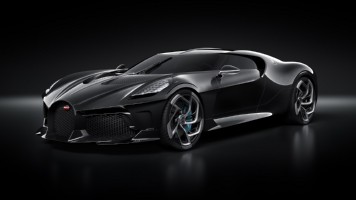
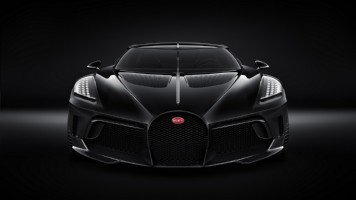
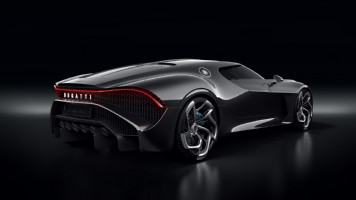
“For Bugatti, ‘La Voiture Noire’ is more than just a reminiscence of the Atlantic. We are paying tribute to a long tradition, to France and to the creative work of Jean Bugatti,” says Stephan Winkelmann. “At the same time, we are transferring extraordinary technology, aesthetics and extreme luxury to a new age.” The special hyper sports car was hand-crafted for a Bugatti enthusiast. “La Voiture Noire” is a collection of superlatives,” says Stephan Winkelmann. Apart from design, quality and materials, this also applies to the iconic power plant. The 16-cylinder engine with a displacement of 8 litres produces 1,103 kW/1,500 PS. A car collector purchased this unique vehicle for €11 million net, making it the world’s most expensive new car and continuing the long tradition of Bugatti. Since the company was first established in 1909, the French luxury brand has produced the world’s best and most powerful sports and luxury cars, true to Ettore Bugatti’s: motto: “if it is comparable, it is no longer Bugatti.”
|
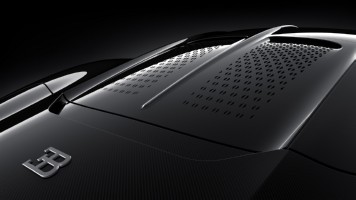
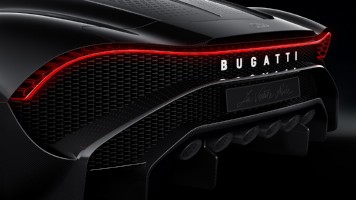
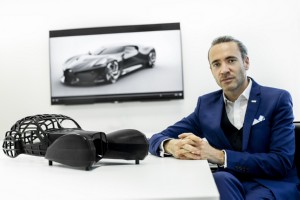
The Chiron Sport “110 ans Bugatti”, which is also being presented to the public for the first time in Geneva, is also in line with this tradition. In addition to all the benefits of a Chiron Sport, it not only includes the „Sky View“ option as standard equipment, but also several product features only offered for this model. This edition, limited to 20 units and with a net price of 3 million euros, has already sold out ahead of Geneva Motorshow. “The new edition of the Chiron is not only extremely exclusive but also a sincere tribute to France, says Stephan Winkelmann. The Chiron Sport “110 ans Bugatti” features the French tricolour “le Bleu-Blanc-Rouge”, with its colours of blue, white and red on several parts of the bodywork and in the interior. The body and the front end are made from carbon fibre, while aluminium features in the Bugatti line and the Bugatti radiator. The rear end of the hyper sports car and the typical Bugatti line, the dominant “C”, boast complex Steel Blue paintwork. The interior of the “110 ans Bugatti” features further French tricolours. “France is Bugatti’s home country. This is why it is an honour and an obligation for us to pay homage to our fantastic location in Alsace with these extraordinary vehicles,” says Stephan Winkelmann. Molsheim was and still is a key element in Bugatti’s brand history. It is here that Bugatti is planning its future and the celebrations of its 110th anniversary. This also includes a grand tour of places where company founder Ettore Bugatti was active. “This will be an exciting and thrilling year for us. It is only just starting with the new models on display at the Geneva Motor Show,” Bugatti President Stephan Winkelmann is pleased to report. |
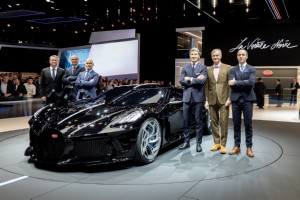
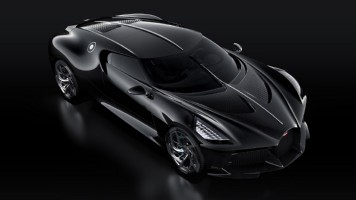
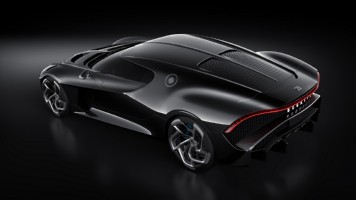

I have seen a lot of Carlo Bugatti furniture, this set has some of the typical characteristics, but the widening legs are new to me!
Carlo Bugatti - Rare games table and set of four chairs
circa 1902
Vellum-covered wood, repoussé brass, brass, pewter, ebonised veneered-wood, walnut-veneered wood.
Side of table and reverse of two chairs signed Bugatti.
Estimate
£80,000 - 120,000, Phillips auction, London, March 21
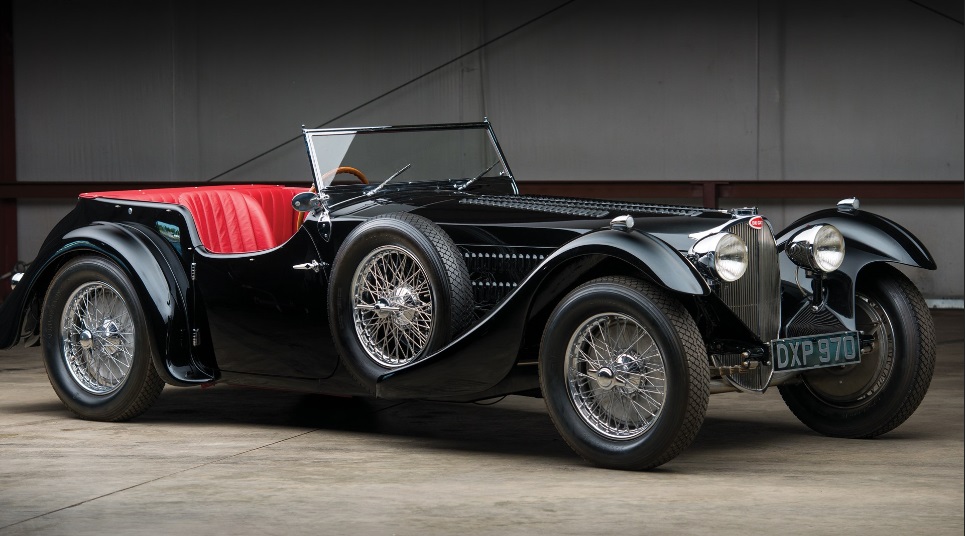
It is not often that a T57SC Bugatti is offered, so this is your chance at RM / Sotheby's Amelia Island auction on March 8 - 9, 2019
1937 Bugatti Type 57SC Tourer by Corsica
Chassis number: 57512
Estimate: $6,000,000 - $7,500,000
Also on offer will be a Bugatti T51, chassis 51153
More info in the Events section of this page.
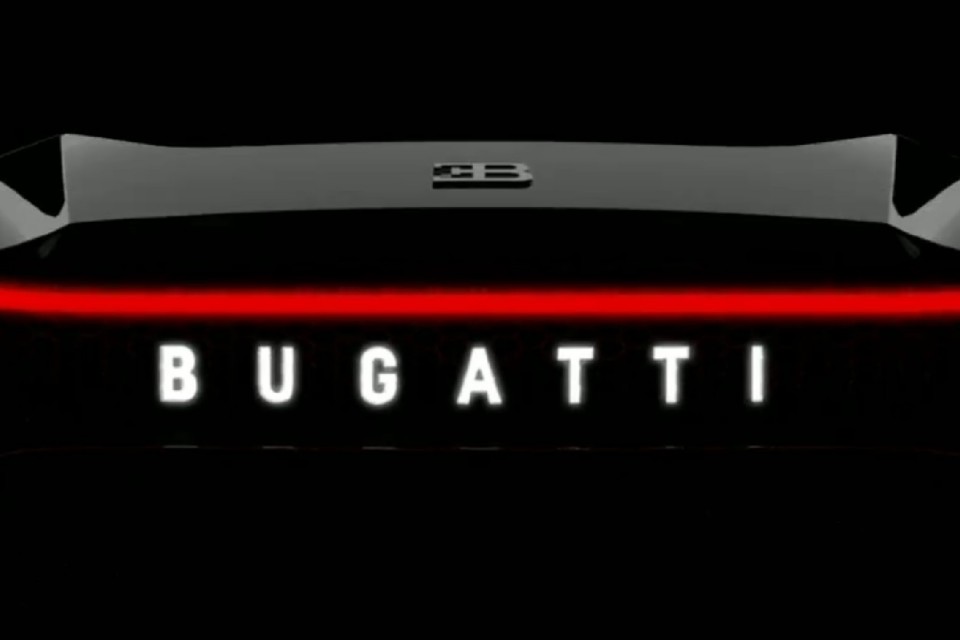
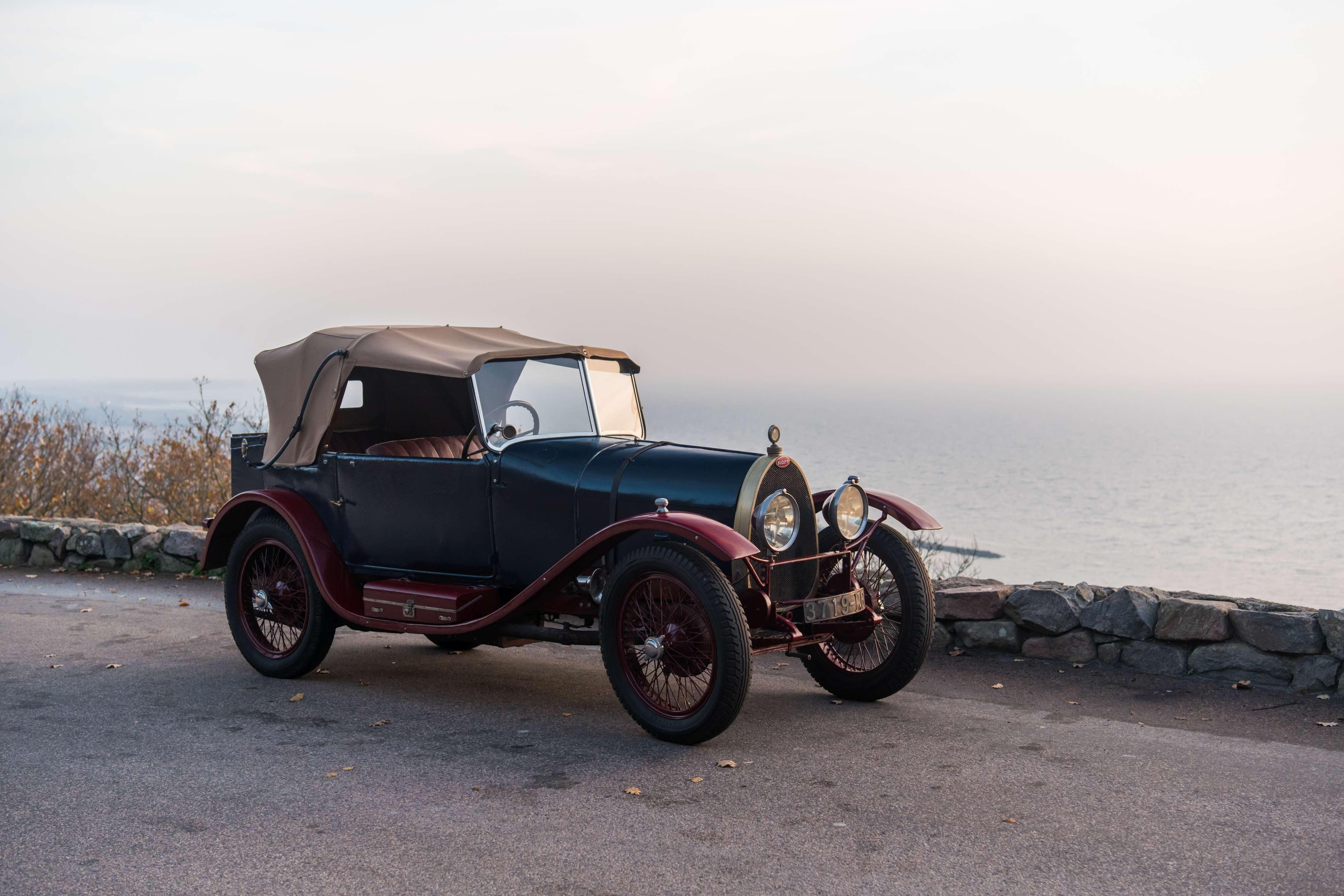
Artcurial Retromobile Auction, February 8, 2019
Bonhams' Les Grandes Marques du Monde au Grand Palais, Paris, February 7, 2019
RM - Sotheby's Paris auction, February 6, 2019
So what do we see: approximately half of the original Molsheim Bugattis were "Not sold", as well as the two Veyron's.
A surprise was the high price reached by the EB110 SS, maybe the highest so far for an EB110 at auction?
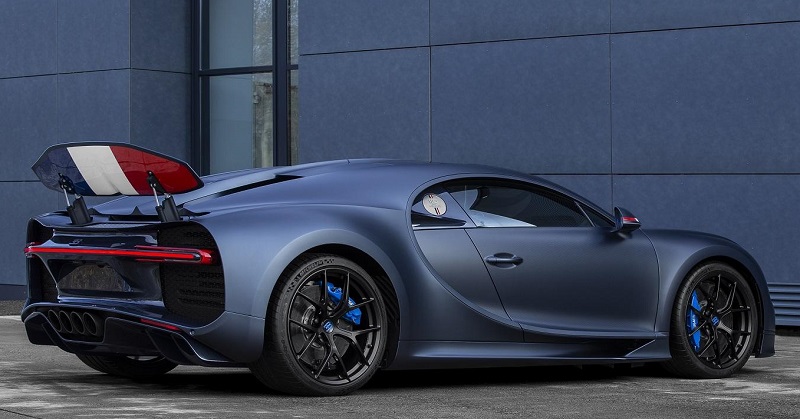
|
Limited edition of the Chiron celebrating the 110th anniversary of the brand Which will be in fact in 2020, as the real Bugattists know... 110 years. Scarcely any other luxury car brand can look back on as long a tradition as Bugatti. The French hyper sports car manufacturer is celebrating this fantastic anniversary with a special edition of the Chiron Sport limited to 20 cars. This new edition is not only extremely exclusive but also pays tribute to France. “With the limited Chiron Sport ‘110 ans Bugatti’, Bugatti is ushering in the 110th anniversary of its foundation. At the same time, we are underlining our origin and our French roots in Molsheim,” says Stephan Winkelmann, President of Bugatti Automobiles S.A.S. “Molsheim in the Alsace region of France is an essential element in Bugatti’s brand history and this is also where we are planning our future.” Tricolour decorates the “110 ans Bugatti” in tribute to France The new Chiron Sport “110 ans Bugatti” bears one of the most famous symbols of a proud nation. The French tricolour “Le Bleu-Blanc-Rouge”, with its colours of blue, white and red, decorates the body and interiors at several points and harmonizes perfectly with the extraordinary Chiron Sport. The flag originally symbolized the union between monarch and people in the phase of the constitutional monarchy. Since the end of the monarchy, it has represented the French Revolution with its famous ideals of liberty (blue), equality (white) and fraternity (red).
|
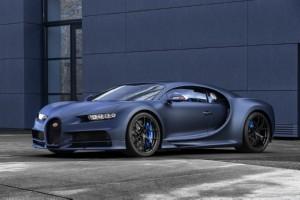
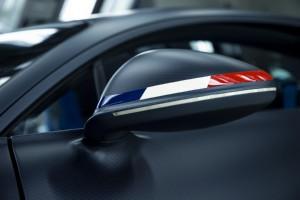
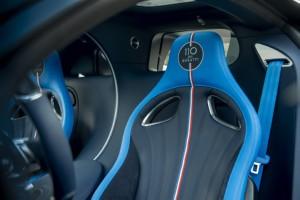
|
Taking a first look at the Chiron, you may be surprised to see that the colours of the French flag are shown as a mirror image on the right-hand side of the vehicle. This is also the arrangement adopted on French official vehicles, where the standard has the colour of liberty (blue) to the fore on both sides.
The body and the front end are made from carbon fibre and the Bugatti line and the typical Bugatti radiator from aluminium. The matt Steel Blue paintwork at the rear of the car, produced in a complex process, has a sheen like hot-rolled steel. The typical Bugatti line, the dominant “C” surrounding the passenger compartment, is also painted Steel Blue. The front end consists of exposed carbon fibre in Steel Blue Carbon, once again a matt colour suggestive of steel. The two-tone colour scheme is reminiscent of historic models: in the 1920s, this type of paintwork was a sign of luxury and exclusiveness, while it now signals a sporting character and high technological competence. In the case of the Chiron “110 ans Bugatti”, the colour scheme divides the bodywork into the monocoque and engine compartment. Behind the alloy wheels painted in “Nocturne” matt black, the bright blue (French Racing Blue) brake calipers are visible. To obtain an immaculate finish, the aluminium filler cap is sandblasted and hand-polished. The “110 ans Bugatti” emblem, with the French flag running vertically through the logo, features at the centre of the cap. If the customer so wishes, the base plate of the filler cap can also be painted blue or white. The rear end is dominated by the diffuser and bumper in glossy Steel Blue Carbon with the contrasting matt black exhaust system. The underside of the rear spoiler boasts the French flag over its entire width. The rear spoiler mechanism is anodized in matt black to harmonize with the matt black Ettore Bugatti logo on the centre of the rear, the matt black wheels and the matching sports exhaust system. The Sky View roof consisting of two fixed glass panels above the driver’s and passenger’s seats, available as an option on the Chiron, is a standard feature of the special edition. These panels have a newly developed laminated structure with thin glass and four intermediate layers. The French tricolour also features at several points in the interior of the “110 ans Bugatti” special edition. These include the two headrests and the back rests of the sports seats, decorated by high-quality embroidery with the French flag in a vertical position, and the 12 o’clock mark on the leather steering wheel. The sports steering wheel combines matt carbon fibre with a blue leather cover. Carbon fibre is also be found on the nacelle, steering wheel, steering column and seat trims. The interior is upholstered in soft Deep Blue leather. The door trims, sides and seat areas of the sports seats are covered in Alcantara. Bright French Racing Blue elements on the contours of the seats, stowage compartments, belt trims and the leather of the window buttons provide a sporting contrast. The key of the “110 ans Bugatti” is surrounded by three sewn leather patches in the colours of the tricolour. Another special feature bearing witness to the high level of craftsmanship is a specially crafted medallion in the central console stowage space, made of solid silver with enamel inserts, positioned on a carbon fibre plate.
|
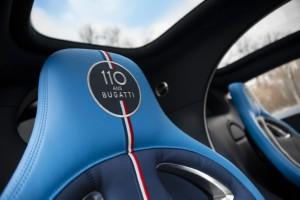
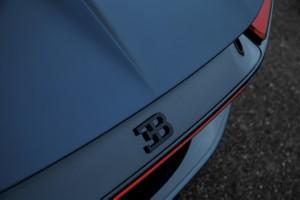
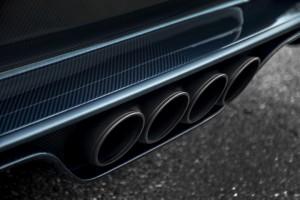
|
Both models feature a superlative powerplant: the 8.0-litre W16 engine with four turbochargers delivers 1,103 kW/1,500 PS and 1,600 Newton-meters of torque. The engine compartment cover of the “110 ans Bugatti” is resplendent in Steel Blue and Steel Blue Carbon. The inserts on the cylinder banks are made from aluminium with a clear anodized finish. The car can accelerate from 0 to 100 km/h in less than 2.4 seconds, reaching 200 km/h in 6.1 seconds and 300 km/h in 13.1 seconds. Even the magic figure of 400 km/h can be reached in only 32.6 seconds. The maximum speed is far higher, at 420 km/h. “The ultimate hyper sports car from France is still the most powerful, highest-quality, fastest and most comfortable gran turismo in existence – a blend of elegance, quality, unique character and power,” says Stephan Winkelmann. This is an industrial product of considerable artistic merit. Form follows Performance. This applies especially to the new edition. The famed Bugatti line, the brand’s graphic DNA, also adorns this exclusive model. Behind the C line, set off by a contrasting colour, the extraordinary engine receives sufficient air for combustion and cooling. “The design element also establishes a link to the historic Type 57 SC Atlantic, which is now one of the world’s most valuable cars,” says Achim Anscheidt, Chief Designer of Bugatti Automobiles S.A.S. The special model celebrating the 110th anniversary of the brand’s existence in France keeps up this tradition.
|
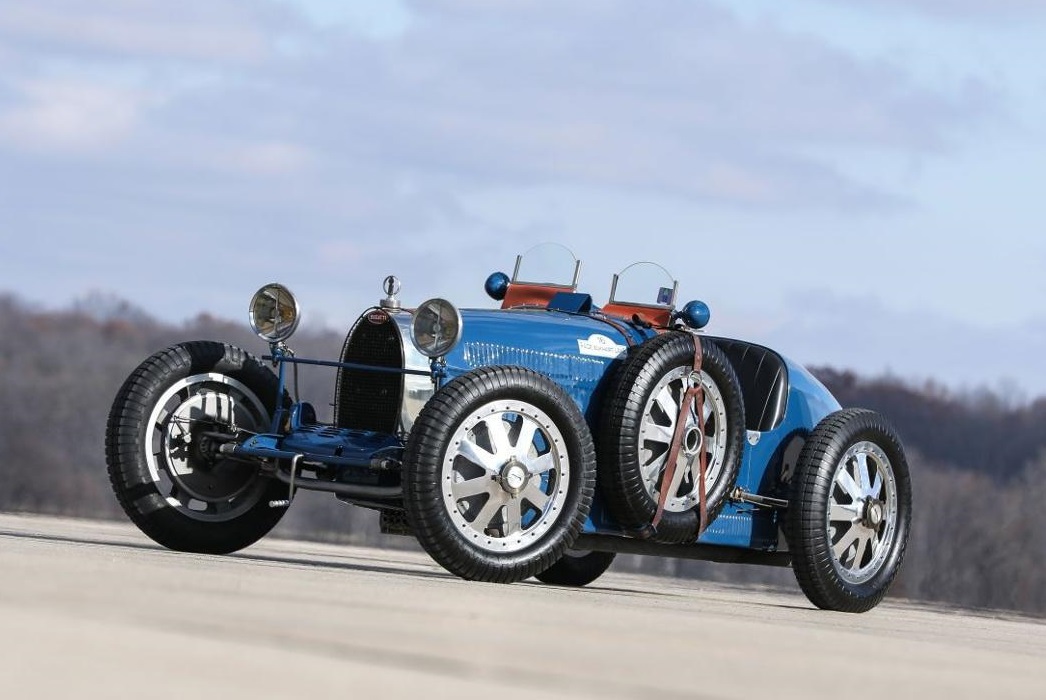
Worldwide Auctioneers Scottsdale auction, January 19, 2019
1925 Bugatti Type 35A: Estimate $1.8 - 2.4 M: Not sold
Expected to fetch up to $2.4 million at auction, a rare 1925 Bugatti Type 35A did not sell at Arizona Auction Week 2019.
The car, driven by racing legend Louis Chiron at the 1926 Provence Grand Prix at Miramas, received a bid of $1.3 million, which did not meet the reserve price of $1.8 million.
Worldwide Auctioneers had featured the Bugatti on their catalog cover prior to the Jan. 16 auction in Scottsdale, Ariz. Principal and Auctioneer Rod Egan said it was likely to be one of the most desirable cars offered by Worldwide this year because it was ready to "vintage race, show, tour and enjoy."
The car toured 4,600 miles through Europe in 2017, according to a news release issued prior to the auction.
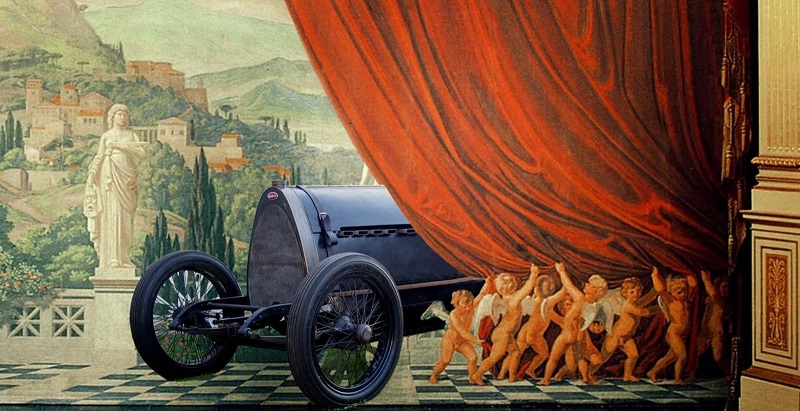
January 31, 2019
Revealed at Retromobile
|
The completion of a historical sensation 2019 marks the centenary for the final completion of the Bugatti Diatto AVIO which has lain dormant since 1919. In 1914 Bugatti told select clients that he was ready to create a luxury vehicle to surpass any known automobile. This coincided with Bugatti’s design of the AVIO 8C aero engine - his first experiment with a straight 8 engine. Historians see this WW1 aero-engine more as an automobile engine than solely for aviation. Indeed, they deduce that this massive 14.5 litre AVIO 8C engine may be regarded as the prototype for Ettore Bugatti’s Royale engine. In 1915-1925 Ettore Bugatti was actively working together with Diatto’s capable technical team and using Diatto’s factory as test facility for his new ideas. In 1919, following the First World War, attention turned to car production and development of the AVIO aero-engine ceased – but obviously was not forgotten. Later this 8-cylinder aero-engine, along with a big Diatto chassis, were discovered in a museum in Turin, Italy. The project had never been finished, and how it found its way to the museum was a mystery. It is this project that after a century has finally been completed – to be revealed at Retromobile 2019. HISTORY – the amazing chronology of Bugatti’s first 8-cylinder prototype:
1900: Ettore Bugatti established direct affiliations with Pietro Diatto. It is therefore with great pride that finally after 100 years we are able to present The Lost Bugatti: BUGATTI DIATTO AVIO 8C 1919
The unique and historically important prototype 8-cylinder Bugatti
 |
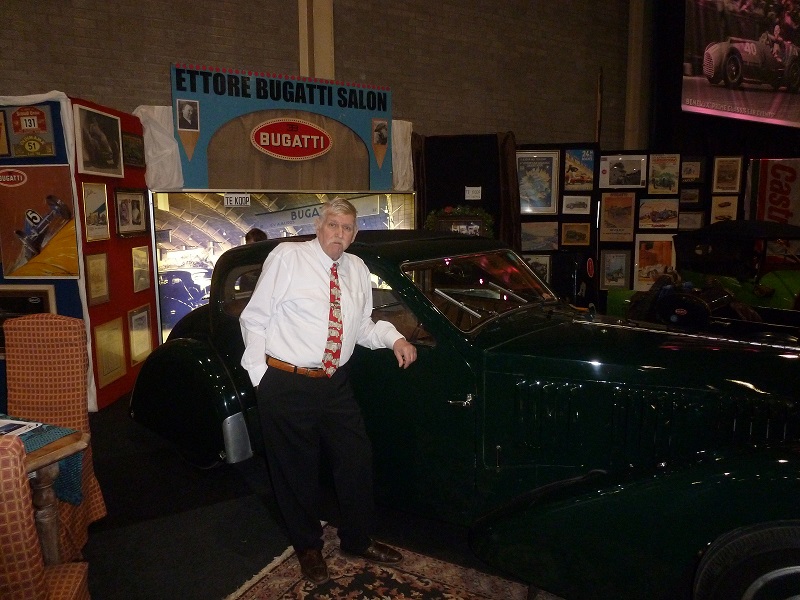
January 25, 2019
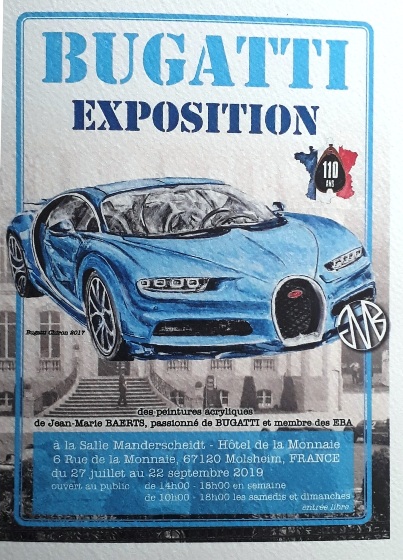
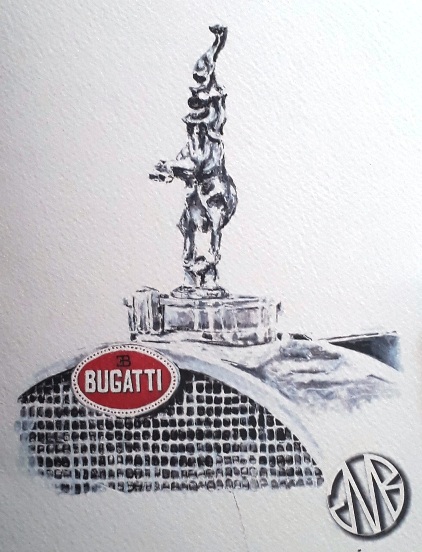

September 14, 2019 Bonhams Goodwood Revival Sale Chichester, Sussex, UK
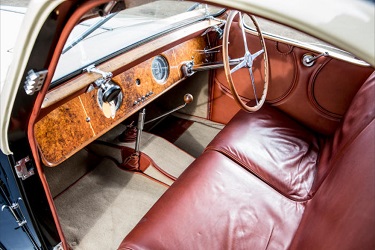
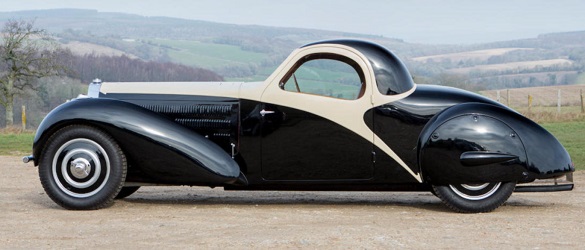
 September 22, 2019 Warren Classic Concours d'Elegance The Warren Golf and Country Club,
Woodham Walter,
Nr Maldon,
Essex, UK
September 22, 2019 Warren Classic Concours d'Elegance The Warren Golf and Country Club,
Woodham Walter,
Nr Maldon,
Essex, UK BUGATTI 110th ANNIVERSARY is one of the 14 concours classes for 2019
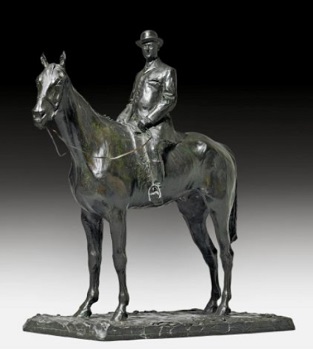

September 26, 2019 Koller Auction Zürich, Switzerland
PAUL TROUBETZKOY (1866-1938)
BRONZE SCULPTURE OF ETTORE BUGATTI ON HORSEBACK
Signed Paul Troubetzskoy and dated 1929 on the base. Bronze with dark brown patina. Foundry mark (front right): C VALSUANI CIRE PERDUE.
The Italian artist of Russian origin, Paul (Paolo) Troubetzkoy, was a friend of Carlo Bugatti's (1856-1940) and his family. The bronze shows his oldest son, Ettore Bugatti (1881-1947), founder of the famous Bugatti car brand, on his thoroughbred "Brouillard". The bronze bears witness to Troubetzkoy's talent as a portraitist as well as his skill and passion for depicting animals. Troubetzkoy may also have been a pioneer for the youngest son Carlos, Rembrandt Bugatti (1884-1916), as a sculptor of animal representations.
Estimate: CHF 8 000 / 12 000, € 7 020 / 10 530
 September 29, 2019 Bonhams Bonmont Sale Cheserex, Switzerland
September 29, 2019 Bonhams Bonmont Sale Cheserex, Switzerland 2010 Bugatti Veyron EB 16.4 Coupé
Chassis no. VF9SA25C18M795208
Estimate: CHF 700,000 - 900,000,
€ 640,000 - 820,000
To be sold without reserve

Scuderia Tazio Nuvolari Italia and Delightful Driving teamed up to organise a meeting that has not been seen before: Bugatti and Lotus owners and enthousiasts come together in La Fabbrica Blu (‘The Blue Factory’) in Campogalliano (IT) on 5th October 2019.
This special meeting revolves around Romano Artioli and the book he has recently published: Bugatti & Lotus Thriller. It tells the story of a man with a dream on four wheels. After being very succesful as an entrepeneur mr. Artioli was able to revive Bugatti and to buy Lotus Cars a few years later. In this period in the ninetees of last century both the Bugatti EB110 and the Lotus Elise were developed. Romano Artioli had La Fabricca Blu built which became a car factory role model. The path that has led to these achievements was rocky, to say the least.
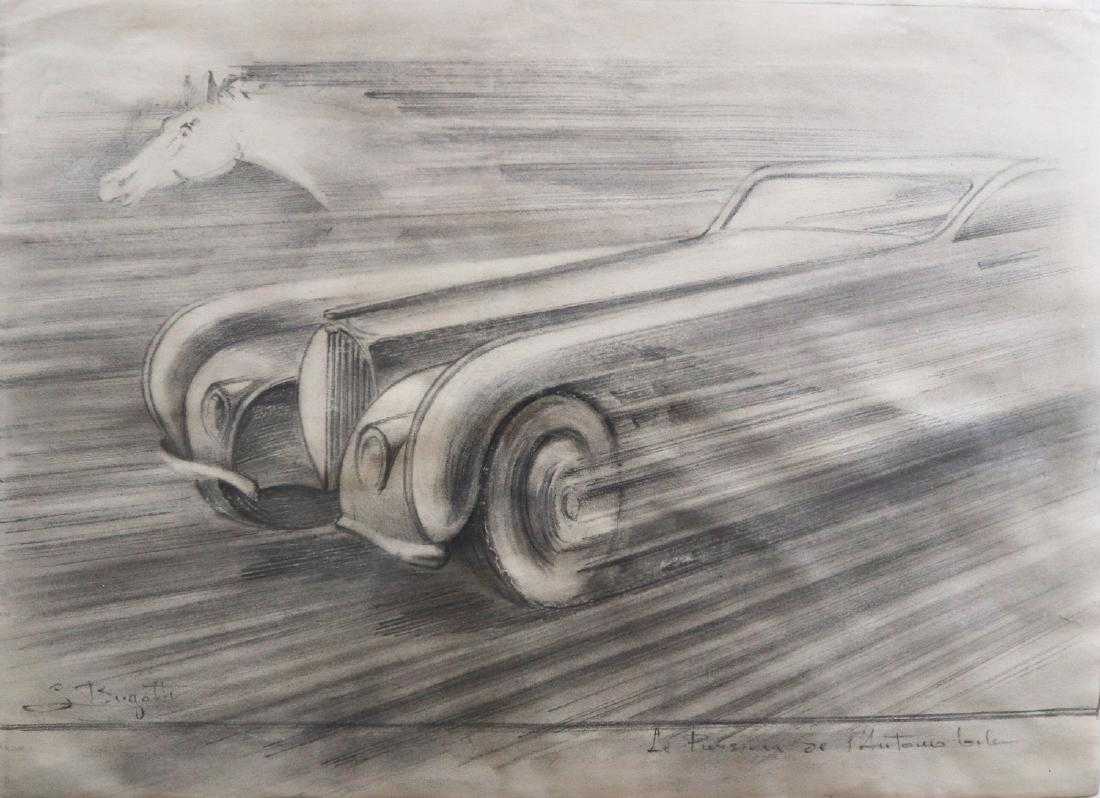
'Le Pursang de l'Automobile'
By Lidia Bugatti
Similar to other known work from her, see: this article in the Bugatti Revue
Bugatti will have a very special place during the event for the 110th anniversary.
The manufacturer will be there, they will present the famous “Voiture Noire” during the Concours d’Elegance.
Apart from the Veyron and the Chiron, they will organize a Bugatti parade with models designed by Mr. Ettore Bugatti.
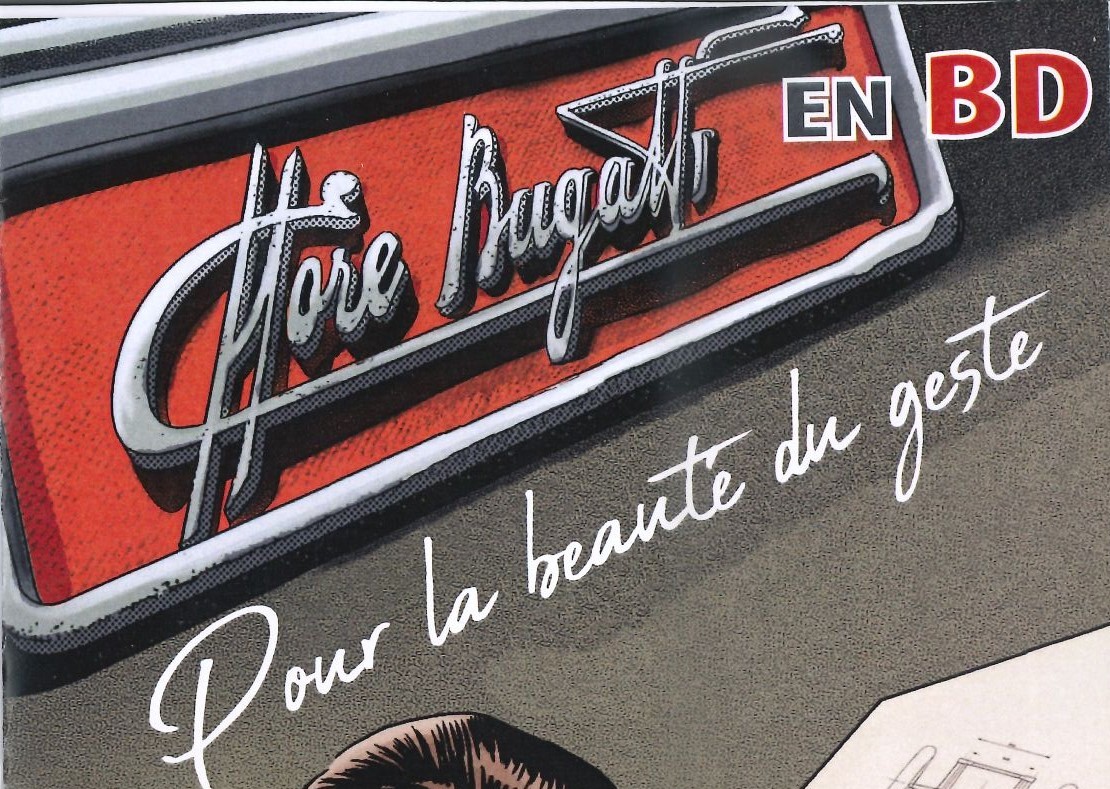
July 22 - August 22, 2019 Exhibition of original comic book pages Chartreuse, Molsheim, France
Presentation of the originals of the comic book by Franck Mézin (coloring by Tanja Wenisch), after a scénario by Monique and Paul Kestler, which is to appear in August 2019.
Opening times from 2 - 5 PM, entry free.
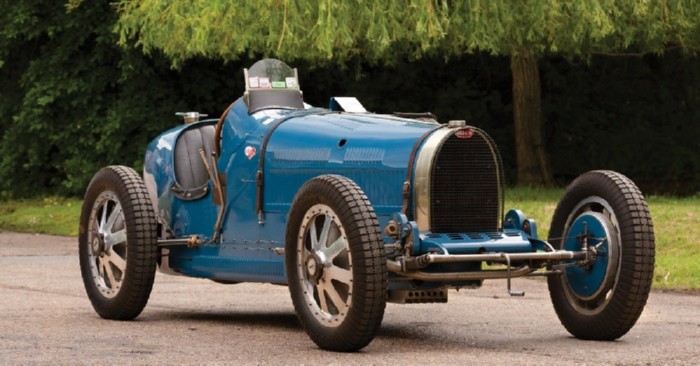
August 15 - 17, 2019 RM / Sotheby's Pebble Beach Auction Monterey, CA, USA
|
2008 Bugatti Veyron 16.4,
Chassis No.
VF9SA25C38M795081, Estimate
$1,100,000 - $1,300,000
1928 Bugatti Type 35B Replica by Crosthwaite & Gardener Bugatti’s final iteration of the Type 35 would be the Type 35B. This new model, which bore the same 2.3-liter, eight-cylinder motor as the earlier Type 35T, was outfitted with a supercharger that was similar to the one in the Type 35C, albeit slightly larger and more powerful. In its day, the Type 35B boasted incredible performance figures, and these figures are still respectable today. It was capable of accelerating from 0 to 60 mph in just six seconds, and it had a top speed of 125 mph. The Bugatti Type 35 is arguably one of the most successful and iconic vintage race cars. This Crosthwaite & Gardiner Type 35B re-creation is visually and dimensionally identical to the original cars, handcrafted and precision-built with over 3,000 components that are manufactured from scratch. Well-known and respected within classic motor racing circles, the Crosthwaite & Gardner Type 35 is regarded by many as the most authentic reproduction Bugatti in the world—as demonstrated by the outstanding example offered here. Built in 1999, this Type 35B is finished in the iconic shade of Bugatti Racing Blue. The car is powered by a 130 hp, 2.3-liter supercharged inline eight-cylinder engine with nine roller bearings. The engine is mated to a four-speed manual gearbox, which sends power to a live rear axle. The Bugatti rides on eight-spoke alloy wheels and features a side-mounted spare. |
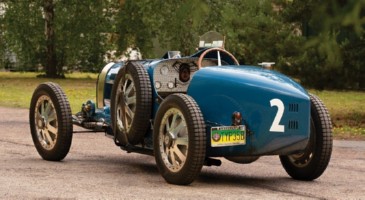
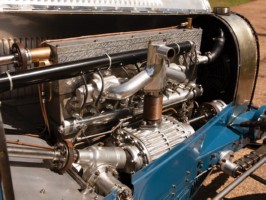
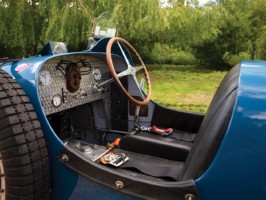
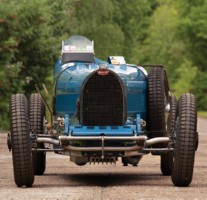
|
More recently the car has been enjoyed on and off the racetrack. This includes being campaigned during the Monterey Historics at Laguna Seca, Sonoma, Buttonwillow, Fontana, as well as on the California Mille. The car was displayed at the Riverside Auto Museum as well as presented at the Palm Springs Concours and at Quail Lodge. With a supercharged straight-eight engine that Ettore Bugatti would be proud to see and hear, this Type 35B re-creation exhibits all the expected characteristics of beauty, performance, and exquisite artisanship. It will be a wonderful addition to any collection or provide thrills in vintage motor-racing competition.
|

August 16, 2019 Bonhams Quail Lodge Auction California, USA
|
1935 Bugatti Type 57 Galibier,
Coachwork by Gangloff Chassis no. 57245 Estimate: US$ 325,000 - 375,000, € 290,000 - 340,000, No reserve. The Type 57 Bugatti, introduced in 1934, marked Jean Bugatti's emergence as Bugatti's leader and creative force. It was the first new model built under his direction and it incorporated many features new to Bugatti. Its dual overhead camshaft eight-cylinder engine had dimensions of 72x100mm, offering 3,257cc displacement. The crankshaft ran in five main bearings. The camshafts were driven by a train of helical-tooth gears at the engine's rear with a further crankshaft bearing behind them. Finger cam followers minimized side thrust on the valve stems. The Type 57 also marked Bugatti's first use of a transmission fixed to the engine crankcase and a single plate clutch. The top three gears in the four-speed gearbox were constant mesh. Jean created a novel independent front suspension system using transverse leaf springs for the first two examples of the Type 57 before Le Patron spied it and insisted it be replaced by a proper Bugatti hollow tubular live axle. Thenceforth suspension was traditional Bugatti semi-elliptical front and reversed quarter-elliptical rear leaf springs with cable-operated mechanical drum brakes. Much of the Type 57's commercial success may be attributed to Jean Bugatti's sensitive, flowing coachwork which graced the most famous of the chassis' examples. Atalante two-seat coupé, Ventoux four-seat coupé, Stelvio cabriolet and the Galibier sedan vied with the best of France's and Europe's formidable coachbuilders' creations and comprised the bulk of Type 57 production. Bugatti's clients could have the best, but overwhelmingly they chose Jean Bugatti's designs on the Type 57. Despite financial travail, development of the Type 57 continued with introduction of a stiffened frame and rubber-mounted engine along with the supercharged 160hp Type 57C in 1936. In 1938 the nearly unthinkable happened in Molsheim when Bugatti finally adopted Lockheed hydraulically actuated brakes and replaced the beautiful and lightweight but expensive aluminum-spoked wheels and brake drums with Rudge-Whitworth center-lock wire wheels and separate brake drums. THE MOTORCAR OFFERED
|
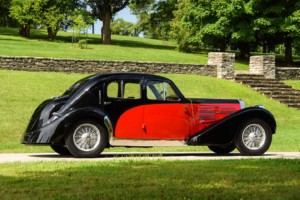
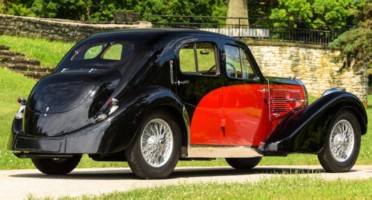
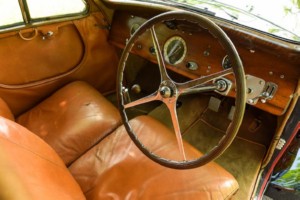
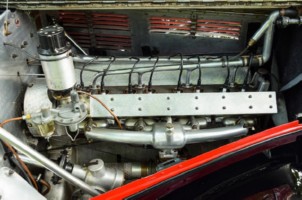
|
This 1935 Bugatti Galibier Saloon, is a handsome and usable example that is wonderfully suited for touring in the grand tradition of the Bugatti T57. It has been treated to recent mechanical care courtesy of a West Coast specialist and is presented with a charming patina that encourages enjoyment on the road. According to the car's history file and correspondence with American Bugatti specialists, it is based on an early Series 1 chassis and running gear, while the body originates from a later Series II car. Such combinations are not uncommon in the Bugatti world, as many cars were separated from their original coachwork during WWII or utilized for parts over the years. Little is known of this car's earliest history, though it is understood that this Galibier body came from a later chassis. In the 1970s, the Bugatti was in France, owned by Adrien Maeght. Mr. Maeght was part of a famous family of art dealers and patrons, who maintained a spectacular collection of artworks, held across galleries in Paris and Barcelona, and Nice. In addition to priceless works of art, Adrien collected automobiles, with a particular fondness for Bugattis. He maintained a private motoring museum, and he published Antoine Raffaelli's fabulous book, Memoirs of a Bugatti Hunter. A copy of a French registration in Maeght's name is included in the history file. It was sold from the Maeght collection in 1994, purchased by A. Arman, also of France, who preceded two additional short-term owners. By 2013, this Galibier Saloon was in the hands of the most recent owner on the West Coast of the USA. There, it received expert sorting and care at a specialist restoration shop. With its engine-turned alloy cam covers and firewall, the presentation of the engine is tidy, appearing well maintained and consistent with a great, usable road car. Cosmetically, the classic black and red livery, which has acquired a moderate patina through the course of time and careful use, is very appealing. The paint is in fine condition overall, with admirable body fit and doors that open and shut with satisfying precision. The coachwork features plenty of period-correct details including dual trumpet horns, Marchal Aerolux headlamps, and Klaxon semaphores. Brightwork is consistent and in good order, from the prominent horse-collar grille to the polished sills and fender stone guards. The style is understated yet handsome, riding on silver-painted wire wheels shod with appropriate black-wall Michelin rubber. The beautifully appointed cabin features natural tan leather on the seats and door cards. The upholstery remains supple and appealing, with the feel and character of a favorite pair of leather gloves. Tan carpets the wool broadcloth headlining are in good order. Jaeger instruments and switches are fitted to the wood dash, and the driver is treated to the iconic four-spoke, wood-rimmed steering wheel. This handsome Galibier Saloon is an excellent selection for touring with the always-enthusiastic American Bugatti Club. It is also an approved CCCA Full Classic and thereby eligible for CARavan events. A practical, comfortable, and exciting touring car, this Bugatti Type 57 is sure to reward its next owner with the kind of enjoyment that only the great motorcars from Molsheim can bring.
|
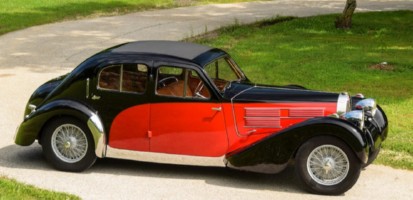

August 16-17, 2019 Gooding & Company Pebble Beach Auction Pebble Beach, California, USA

More info on 57386
More info on 57597
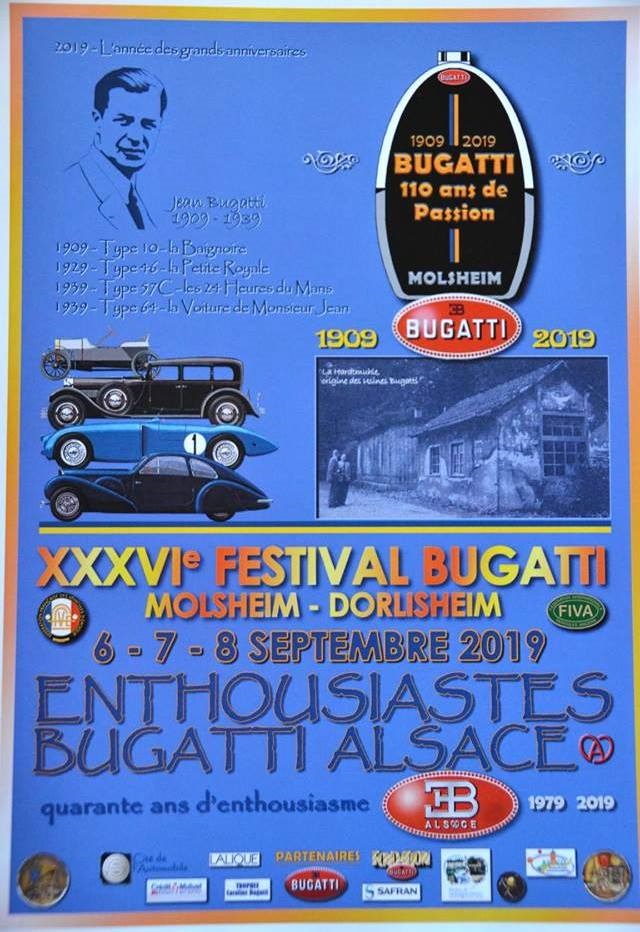

September 7, 2019 Bonhams The Beaulieu Sale Beaulieu National Motor Museum, UK
|
1929 Bugatti Type 44 Tourer,
Coachwork by Harrington Chassis No. 44923, Engine No. 636 Estimate: £ 200,000 - 300,000, € 220,000 - 330,000. |
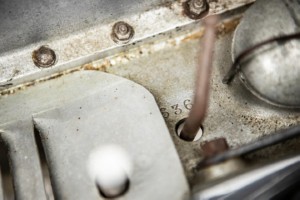
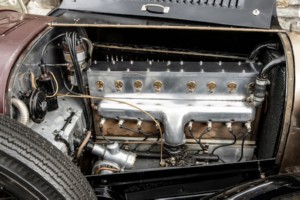
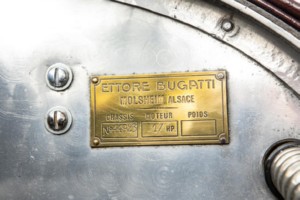
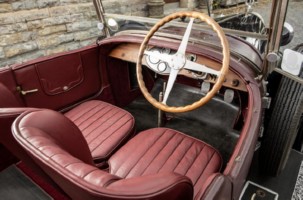
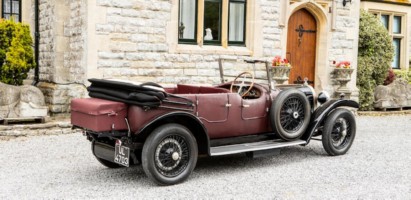
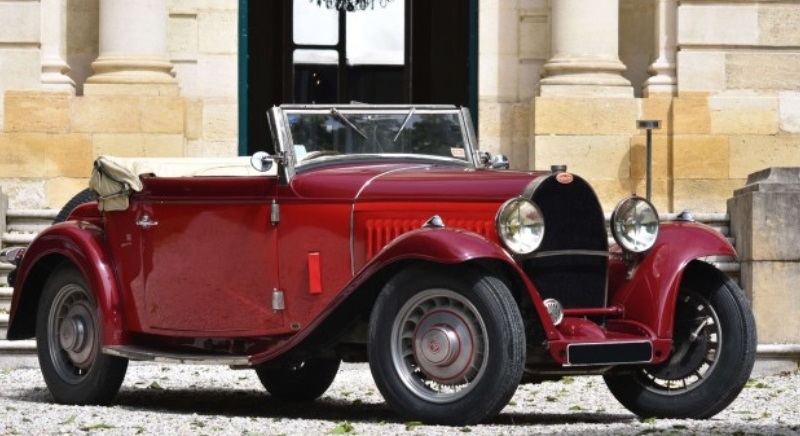
June 17, 2019 Arturial Auction: Vente Automobiles en Scène Paris, France
|
1933 Bugatti Type 49 Cabriolet 4 places
Chassis n°49558,
Engine n° 445 The chassis type 49 with engine 445 was assembled at the Bugatti factory in January 1933 with 5 other chassis of the same model.
|

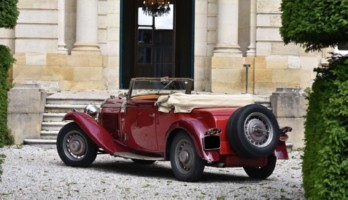
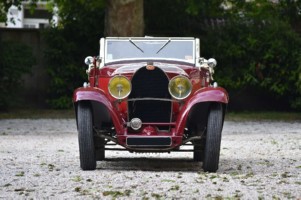
|
The Faux Cabriolet Gangloff 749G, Factory demonstration car in 1933. Chassis 49558 was transported to Gangloff, the coachbuilders in Colmar, around June 1933 to be fitted with a body described as " Faux cabriolet model 749 G, luxury roof and dark grey metallic paint. " Model 749.G relates to a reference dating from 1931 describing a " Faux Cabriolet two door, 4-seater with trunk on a type 49 long chassis " with a 3.22m wheelbase. The body was invoiced to Bugatti for the sum of 18,0000 ff plus extras of 1600ff. It was delivered to Molsheim on 25 July 1933.
A letter from the factory, dated 28 July, to Mr André Bouchard, the " Inspector of Bugatti automobiles " for the west of France, states:
" I am going to send the Faux-Cabriolet 749.G Spécial to Paris for La Baule, and it will be waiting for you in Montaigne. " A photo from the Bouchard family archives shows R.A. Bouchard's wife standing next to the vehicle in front of the Pergola in Saint-Jean-de-Luz. The coupé 49 was fitted with the factory plates NV1. The photo dates either from the start of August 1933, before it was delivered to La Baule, or during the autumn of 1933 before it was finally delivered to Nantes in October.
Roger-André Bouchard (1899-1954) set up a garage in Périgueux in 1926, and was the regional inspector for Bugatti from 1928 to 1939. There was confirmation on 18 August 1933 of the order placed by Henri Matile, 4, rue Racine, Nantes, and Matile was invoiced for the sum of 52.000.ff., on 26 October 1933.
Les Faux Cabriolets type 49 Gangloff of 1933 :
This car was a one-off creation, built by the coachbuilder Gangloff, and corresponds to an order that came from the Bugatti factory.
|
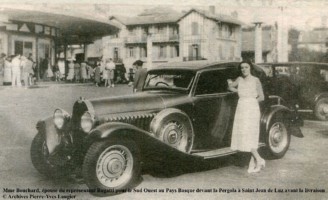
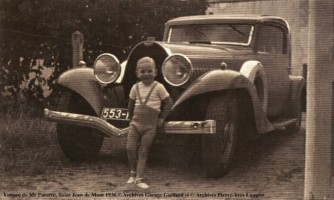
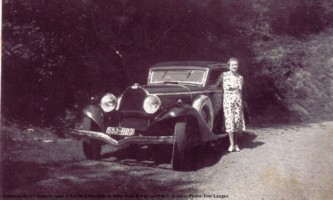
|
History in Pays de Loire 1933-1939. The car was registered new on 20 October 1933, with the number 50 JH 3 in the name of the first owner's company " Les transports Paland " in Basse-Indre, Loire Atlantique. Henri Paland (1906-1999) was 27 years old when he acquired his only Bugatti. He got married the same year and had a daughter in 1934 and a son in 1938. He was the founder of " Transports Paland ", and also had concerns in Cameroon. He was, also at that time, the President of Transporteurs de la Loire Atlantique and the Aéroclub. At the end of the 1950s he founded Europcar. Having owned this Bugatti, he later owned a Talbot and in 1945 a Hotchkiss. His Bugatti was sold on 26 July 1935 in the nearby department of Indre and Loire. It was registered with the number 553 HD 3, in the name the enthusiast Pierre Parâtre, rue de l'Alma in Tours. This type 49 was the first Bugatti he had acquired, and he took his cars to be maintained by the Bugatti dealer in Tours, Gaillard, at 7 rue George Sand. Roger Gaillard took over the Bugatti dealership in 1933, the year he got married. He remained an agent for the marque until 1950. The spacious 900m2 garage was situated in the heart of Tours, near the Hôtel de Ville.
Parâtre was the owner of a business called " Représentation Industrielle de l'Ouest " (R.I.O) whose offices were at 4 de la rue George Sand, opposite the Gaillard garage ! On 3 November 1938, the Bugatti 49558 was acquired by another enthusiast from Tours by the name of Jean de la Chesnaye, who lived at rue Roger Salengro.
Jean Hartford Martel de la Chesnaye (1905-1992) was born to an American mother and inherited a fortune from her. He enjoyed a comfortable pension.
On vacation on the Riviera 1939-1959.
On 28 April 1948, George LUTZ, who lived at 3 boulevard de la Madeleine in Nice, and a former Alsatian mechanic trained at Molsheim, became the new owner of the faux-cabriolet 49558.
On 13 January 1950, the Bugatti sold to Canadian billionaire Duncan Orr Lewis at his property " Villa Zéro ", 416 chemin de la mosquée au Cap d'Antibes.
In 1959, chassis 49558 was bought by a dealer in Limoges, Jean-Louis du MONTANT, as shown on a document dated 13 May 1959.
J-L du Montant was the last known French owner before this car was bought by the Bugatti specialist and dealer Bart LOYENS in Luxemberg. It was exported to Holland on 3 March 1978, acquired by Dr F.J.P SPULS.
Restoration of the vehicle 2002-2003.
The current owner repaired the bulkhead and made a start on the mechanical work.
|
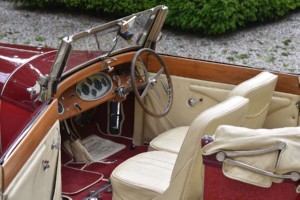
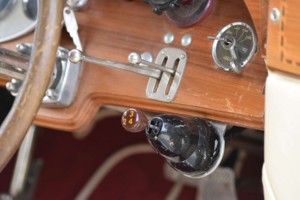
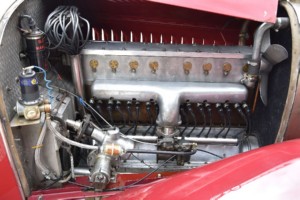
The vehicle presented :
Our opinion is that the bonnet, bulkhead and front wings come from 49238, which was a Gangloff cabriolet model 349 G sold in Marseille in April 1931, whose design is very similar to the current body of 49558. It is highly likely that the fold-down windscreen also came from this car and that Duncan Orr-Lewis was the source of the spare parts from 49558 that are fitted to the car today. The car presented in the sale is originally a rare Faux-Cabriolet Gangloff. It is equipped today with numerous parts from the coachwork of the Gangloff cabriolet 49238, and it is likely that it was restored in a configuration close to the original car.
|

May 25, 2019 RM Sotheby's Villa Erba Auction Villa Erba, Italy
1931 Bugatti Type 50 Roadster, Chassis No. 50123, Engine No. 18
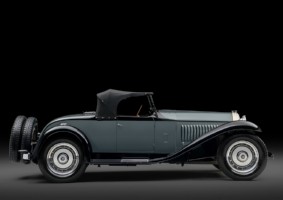
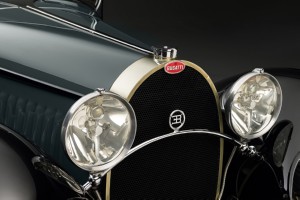
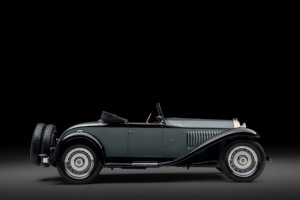
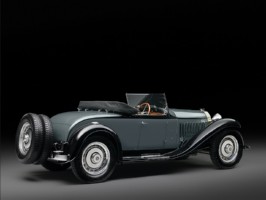
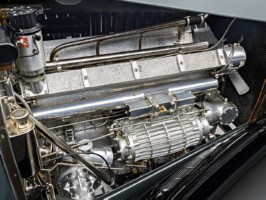
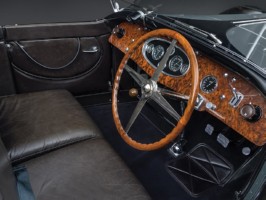
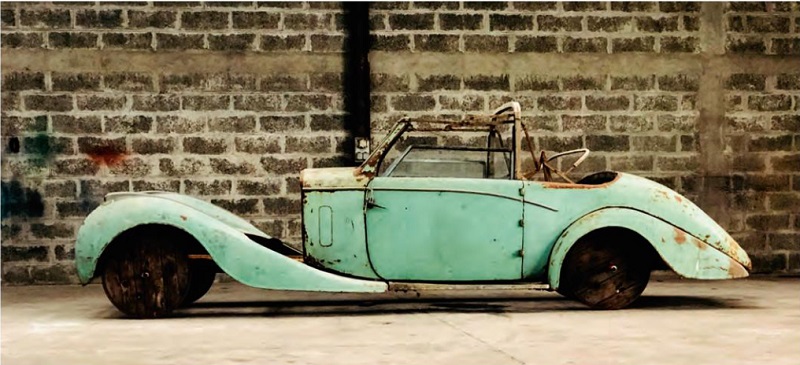
May 26, 2019 Hôtel des Ventes de la Seine Auction Paris, France
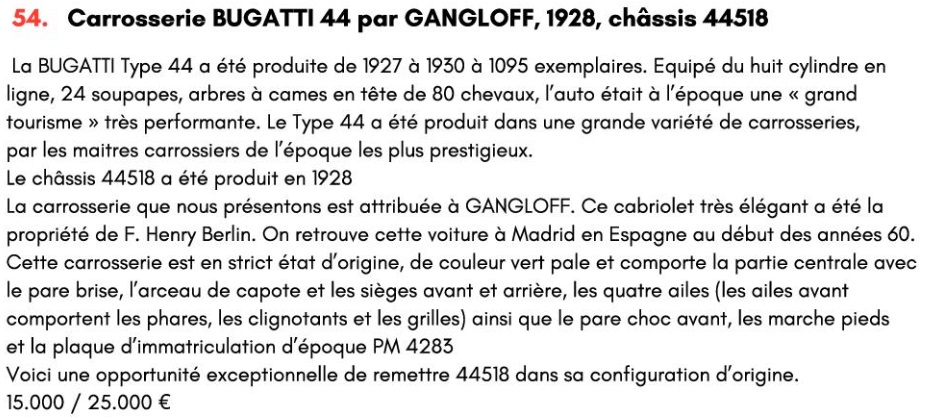
Apparently, according to BugattiRegister, the chassis 44518 to which this body belongs, is currently for sale in Spain.

May 29 - June 1, 2019 RM | Auctions - Auburn Spring Auburn, USA
Bugatti 'Baby', c. 1929, Chassis no. 355A
Estimate $18,000 - $25,000,
Offered without reserve
The first Bugatti of this type was manufactured for Ettore Bugatti's second son Roland. It was designed to look like a miniature version of the Bugatti Type 35 Grand Prix race car. Following exhibition at the Milan Salon, so much interest was shown in the diminutive Bugatti that the the decision was made to put the model into production as the "Baby".
Aimed at children between the ages of 6 and 8 years old, the car was driven by a rear-mounted 12-volt battery-powered electric motor giving it a maximum speed of 15-18 kph. A reverse gear was operated via a switch to reverse the polarity of the motor.
This example, numbered 355A, is believed to be an original Molsheim-built Baby. Currently unrestored, it is presented in traditional Bugatti blue with silver-painted brightwork. The wheels and spare are fitted with Dunlop 'juvenile' pneumatic tires and the car is powered by Paris-Rhone 12-volt electric motor.
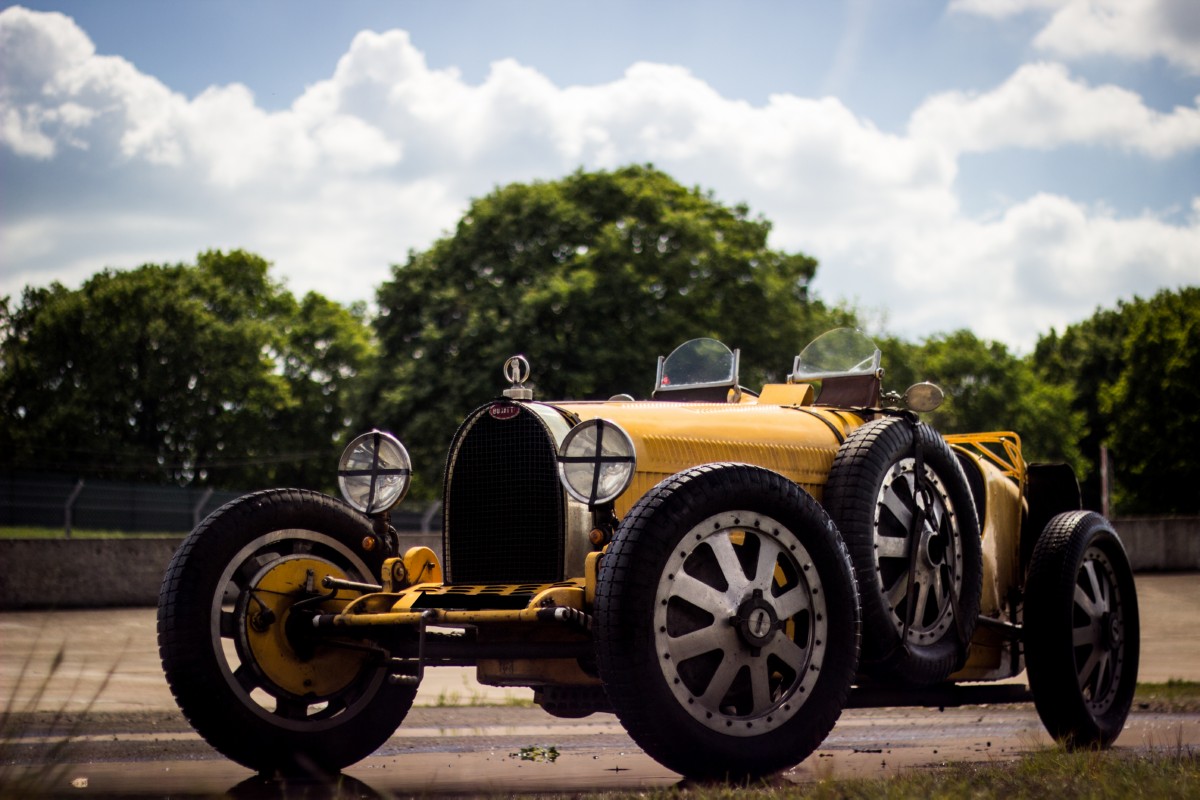
June 15, 2019 Osenat Auction: Automobiles de Collection Paris, France
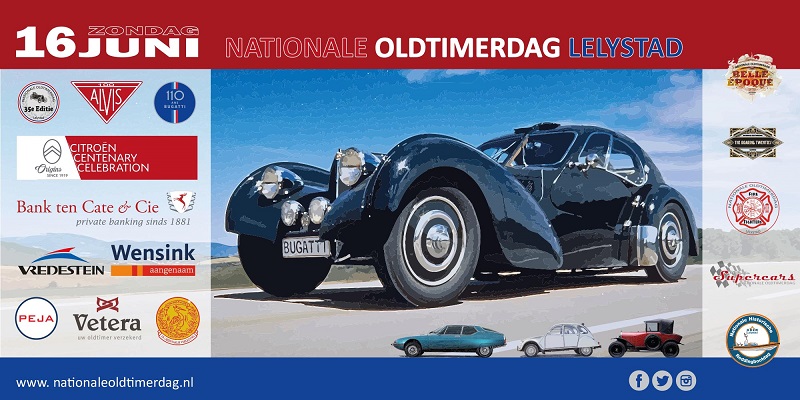
 June 16, 2019 35th Nationale Oldtimerdag Lelystad, Netherlands
June 16, 2019 35th Nationale Oldtimerdag Lelystad, Netherlands
Including a special Bugatti exhibition because of the "110 years" of Bugatti.
Rumours are there will be around 30 Bugattis there (no garantees!)
Charity classic and special car rally for Make-A-Wish Netherlands
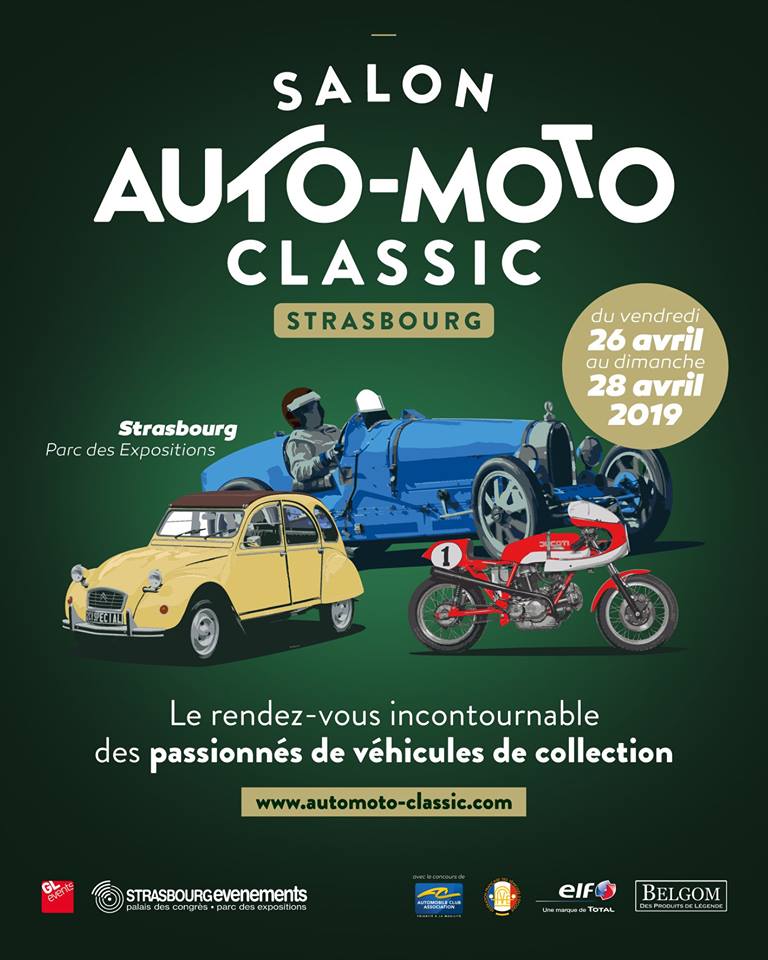
April 26 - 28, 2019 Salon Auto-moto Classic Strasbourg, France
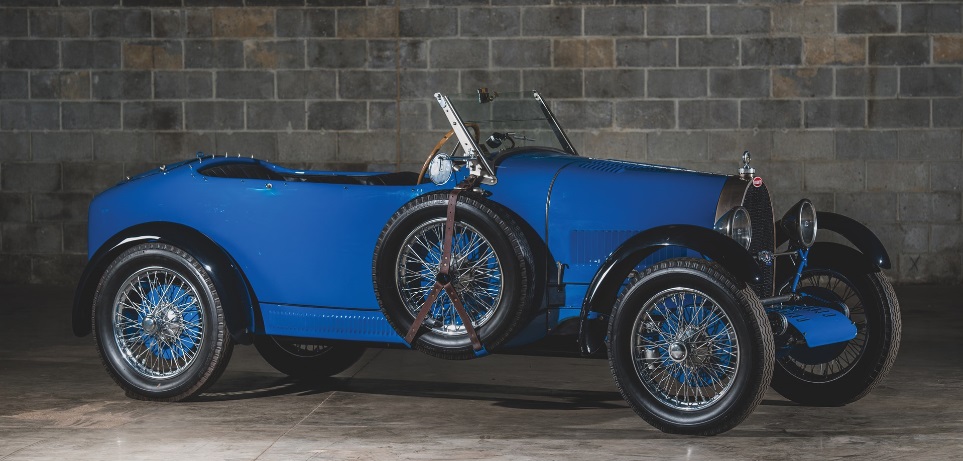
May 4 -5, 2019 RM Sotheby's The Guyton Collection Auction St. Louis, Missouri, USA
1927 Bugatti Type 40 Grand Sport
Chassis No., 40661
Engine No., 565
Gearbox No., 701
Offered without reserve
The current American Bugatti Club (ABC) Register notes that chassis no. 40661 was produced in January 1928, with engine no. 565 and a factory-made Grand Sport body. When an order was placed on 10 September of that year by Lyon agents Christy, Panguad and Monestier, this car was so-assigned, and was collected at Molsheim and driven to Lyon by Jean Tisseyre, believed to have been the first owner, on garage plates 1655 WW5.
By the early post-war era the car had made its way stateside and was owned by one Joe Dickey, who sold it to Carlton Coolidge of San Francisco. Mr. Coolidge, an avid sports car enthusiast, is a longtime member of the ABC, and this car was noted in his ownership in the Club’s second Register. While owned by Mr. Coolidge the Bugatti was restored to its present appearance, in iconic French Racing Blue with body-color front axle and springs, and chrome-finished wire wheels. The body conformed, as it does today, very near the original Grand Sport design, though much of the inner woodwork is new and it is obvious significant restoration was required; in addition, some of the gauges have been updated.
The Type 40 was eventually received by Mr. Coolidge’s ex-wife, Cynthia, in their divorce, and sold to the Blackhawk Collection, from which it passed to Fred Guyton in the same transaction that added the Rolls-Royce Piccadilly Roadster to the collection.
Over the years, this was a particular favorite of Mr. Guyton and his wife, Beverly, and was occasionally shown at Midwestern concours, including at the 2012 Celebration of Automobiles at the Indianapolis Motor Speedway, for which it was freshly painted and mechanically sorted by D&D Classic Automobile Restoration; receipts for this work are on file. Mrs. Guyton recalls that the opportunity to drive the Bugatti on the famous “Brickyard” was one of the great thrills of her husband’s life.
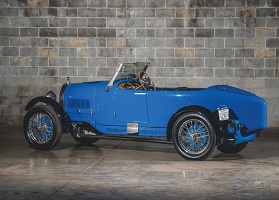
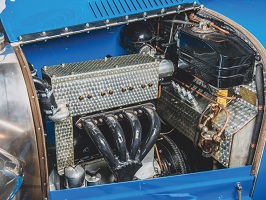
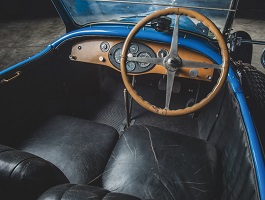
More info
Also a lot of Bugattiana in this auction, books, models, paintings.
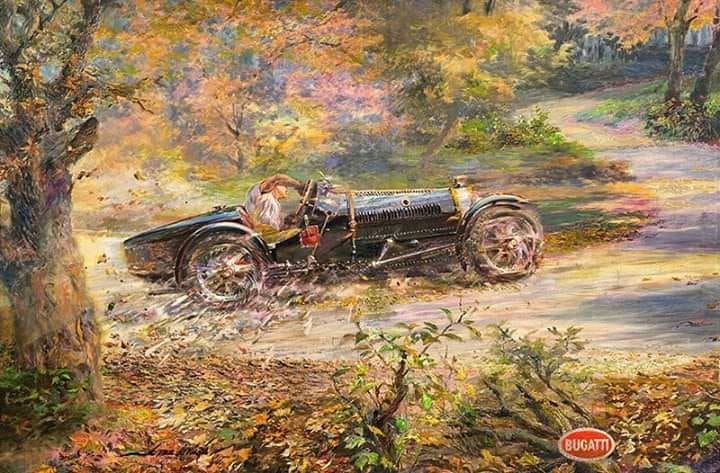
Road-equipped GP Bugatti in full action on what seems to be a hillclimb.
By Alfredo de la Maria from Uruguay.

March 7, 2019 Bonhams' Amelia Island auction Fernandina Beach Golf Club , Amelia Island, Florida, USA
|
1923 Bugatti Type 23 Brescia Three Seater Torpedo Sports
Chassis no. BC002,
Engine no. 892 (ex-2526) This well-known survivor of the original pear shape-radiatored Bugatti is charted in Bob King's excellent works "Bugattis in Australasia". It is this respected author that is responsible for the car's presence today. Dr. King acquired this original long wheel base chassis, which had been saved by Australian Gavin Campbell in 1960 and married it to a series of other components that he had amassed over the years with the help of David Roberts, many of which came from a crashed Brescia, no. 2569. Sadly, the frames of these early Bugattis are not numbered and so it was not possible to decipher which car it had originally belonged to, but since its rebuild and in line with Bugatti Owner's Club attributions to encourage people to restore these cars it has since been designated as BC002, being the first such car to have received their acceptance (BC001 being retained by Hugh Conway for a project himself). The engine used, number 892, had previously been fitted to chassis 2526, yet was renumbered at some point as 2566 for reasons unknown, with the opportunity to enhance its road going capabilities this was bored out to the 1,496cc specifications of the final cars. The Bugatti running gear was clothed by King with the present pretty boattail coachwork which was constructed by Harry Donders in Melbourne and is a copy of a period body that notably featured in the Autocar in October 1922. The car was completed in 1978 in time for the Australian Bugatti Rally in Canberra, in doing so it had enabled him to return another Bugatti to the road and to enjoy participation among other enthusiasts and would then be used by King for countless tours. The current custodian was a long-term friend of Bob King and a passionate enthusiast of the marque having previously owned five including the Atalante T57C 57557 purportedly Jean Bugatti's personal car and was able to negotiate this car's purchase in 1995. |
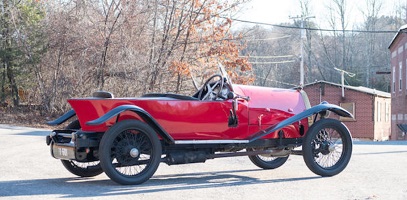
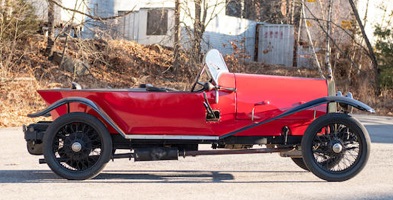
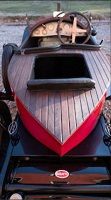
|
Over the course of the last 22 years, it has continued to be used on various events including the 2003 International Bugatti Meeting in Lenox, Massachusetts. Later it received a mechanical rebuild by John Schramm of Mechanical Restorations in Rockland, Maine. Most recently, at the custodian's invitation to Bob King, the Brescia was shown at the incredible gathering of 'La Marque' at Lime Rock and subsequent Bonhams-Sponsored International Bugatti Tour in Saratoga this past autumn covering several hundred miles. A minor damage to the gas tank while on tour, necessitated repair and a check over at a known Bugatti restorer. In preparation for the auction the car was driven by a Bonhams specialist and found to have lively performance and display all of the appealing features of these lightweight and nimble sportscars, specifically including their refined transmission. Accessing the esteemed Bugatti fraternity has a high entry point these days, and for a modest outlay in relative terms this offers the opportunity to experience all their lauded events as well, by definition, as hallowed events such as the Mille Miglia Storica.
|
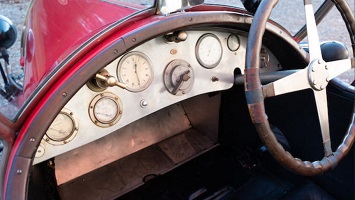
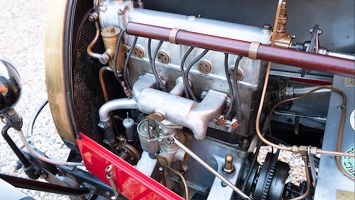

March 8 - 9, 2019 RM Sotheby's Auction: Amelia Island The Ritz-Carlton, Amelia Island, Florida, USA
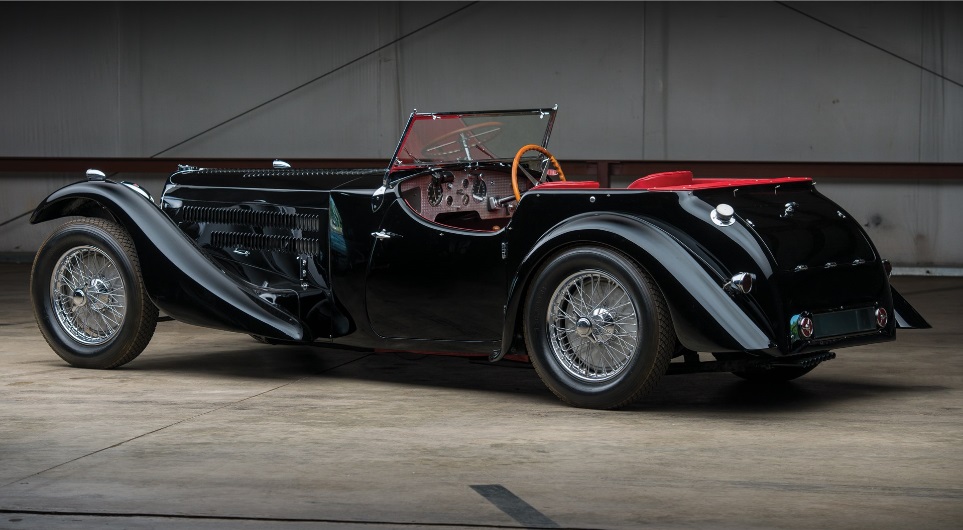
|
1937 Bugatti Type 57SC Tourer by Corsica
Chassis No., 57512,
Engine No., 19S
Gearbox No., 19S
THE ULTIMATE EXPRESSION: TYPE 57S The Type 57S was built upon a completely re-engineered chassis that was both shorter and lower (the S for surbaisse, French for “lowered”). The front axle was articulated in halves, and the rear axle passed through the frame rather than under it for a lower overall stance. A magneto-driven ignition was mated to the specially tuned engine featuring a higher compression ratio of 8.5:1 and positioned low in the frame. A dry sump oiling system was added to accommodate for the engine’s lower center of gravity to achieve proper road clearance. This low-slung chassis was then fitted with an equally low-mounted radiator that wore a handsome V-shaped grille in the classic Bugatti motif for, as might be presumed, its aerodynamic effect at high speed. This potent combination added up to a significant increase in both horsepower and overall performance over the typical Type 57 engine and chassis. The 57S now boasted 175 hp versus the standard Type 57 output of 135 hp, and when adding the available “C” specification Roots-type supercharger power output was raised to 200 hp. This enabled a top speed of some 120-mph, making Bugatti the fastest French production car of the period. The attributes of the Type 57S chassis were adapted for competition use, with an advertisement printed a year later in conjunction with the 1937 Paris Salon that demonstrated how successful the Type 57S was in racing in its first 12 months. Claiming three competition victories during 1936 (the French Grand Prix, La Marne Grand Prix, and the Commings Grand Prix), Bugatti’s greatest success on the track was soon to come when a groundbreaking aerodynamic version of the 57S called the 57G “Tank” won the 24 Hours of Le Mans in 1937. In addition to achieving victories at the Pau Grand Prix, Bone Grand Prix, and La Marne Grand Prix that same year, the 57S set records at some 14 different types of events, including a speed average of 85.07 mph at Le Mans. An overall victory at Le Mans was later repeated by a second incarnation of the Tank in 1939. These achievements in mechanical design, engineering, and performance that evolved from lowering and shortening the chassis led to an additional benefit – the 57S provided the perfect platform for some of the most stunning automotive shapes ever created. With the ability to lower the hood and roofline proportions on the S chassis, designers were able to dramatically change the entire profile of the coachwork when compared to the taller stance of the Type 57. Each example of the Type 57S built is a study in the art of coachbuilding, and chassis 57512 is no different.
|
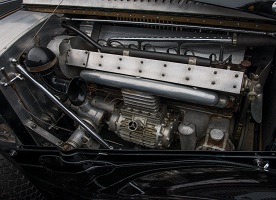
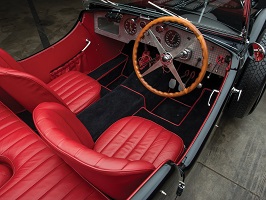
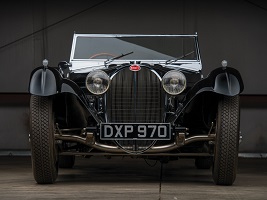
|
CORSICA COACHWORKS Corsica Coachworks was established at Kings Cross, London, in 1920 by Charles Stammers and his brothers-in-law, Joseph and Robert Lee. A relatively small operation, the firm claimed not to have employed designers, preferring instead to directly carry out its customers’ devices and desires. Because Corsica was small and could intimately cater to its customers’ whims, the workshop attracted many of the sporting crowd. While little is known of the early ’20s Corsica output, a good deal of it is believed to have involved Bentley. The early 1930s brought some of the best-known Corsica coachwork, including a low-slung sports body for the Double-Six 50 Daimler and an open two-seater for Donald Healey’s 1935 Triumph Dolomite, by which time the Works had moved to Cricklewood. For MG general manager Cecil Kimber, Corsica worked up a drophead coupe for a supercharged K-Type Magnette. In addition to traditional British marques Rolls-Royce, British Salmson, Frazer Nash, and Lea-Francis, Corsica also worked on Continental chassis, mainly Alfa Romeo and Mercedes-Benz. Later on, more than a dozen Type 57 Bugattis were bodied by Corsica, including a 57S roadster style body for Sir Malcolm Campbell, the Grand Prix driver and land-speed record holder – and the monumental 57S roadster created for Colonel Giles, who affectionately referred to this masterpiece as “La Petite Suzanne.” Like many of the bespoke builders, Corsica closed its doors during World War II, never to re-open.
BUGATTI CHASSIS NUMBER 57512 While most bodies were supplied by French coachbuilding firms such as Gangloff (a favorite for carrying out some of Jean’s best recognized designs), Vanvooren, or Bugatti’s own Works, British coachbuilders such as Vanden Plas and Corsica also applied their trade to the 57S with perhaps as many as 15 chassis slated for delivery to England. Corsica built a total of only eight bodies on the Type 57S chassis, including four two-seat roadster bodies (including the Sir Malcolm Campbell and La Petite Suzanne cars), two closed car bodies (of which one example no longer survives), and two four-seat tourer bodies. Chassis 57512 was the second four-seat tourer commissioned, with each being uniquely constructed to show obvious variations from one chassis to the other. The first chassis, no. 57503, abruptly ends the curve of the fenders just behind the wheels, while proudly displaying the oil tank just behind the left front wing. The example offered here extends the length of the fenders front and rear to gracefully hide the oil tank and visually lengthen the car for a dramatic finish to the rear profile. The configuration of the side-mounts was also treated differently for both examples, with the spare suspended mid-flank on 57503 rather than carefully crafting the side-mount into the extended driver side fender as is seen on this car. The history of this 57S begins with the delivery of its chassis on 8 March 1937 to Colonel Sorel at the Bugatti agency in London for Mr. Hubert Papworth, known for running a Bugatti tuning service in Fulham, London. The chassis was then taken to the Corsica Coachworks to have the open four-seater tourer body fitted. Soon after completion, 57512 was delivered to its first owner Mr. Maurice Fox-Pitt Lubbock, who registered the Bugatti in London with license DXP 970 in March 1937. Maurice Lubbock’s name was listed in the March issue of Bugantics when he joined the B.O.C. Club, which also congratulated him on the purchase of his new Type 57S Bugatti.
|
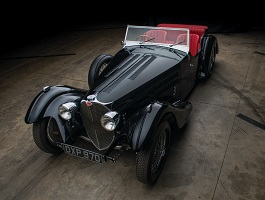
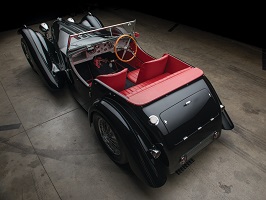
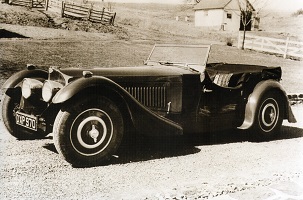
|
Mr. Maurice Fox-Pitt Lubbock was a close friend of Jean Bugatti, who frequently drove him along the tight vineyard roads in Alsace at a very high rate of speed each time Mr. Lubbock visited the factory. Perhaps due in part to Jean’s driving inspiration, Maurice also enjoyed exercising his new Bugatti in a spirited manner, even when carrying the family at speeds of 100 mph or better. One can imagine the heartbreak Maurice Lubbock experienced when he was forced to sell his prized Bugatti after being elected president of Rolls-Royce, approximately 10 years after he first took delivery. It is around this period that a photograph was taken of the car surrounded by eight other Bugattis including three additional 57S models in front of the Continental Cars Ltd. garage in Surrey. By the time 57512 was sold directly from Lubbock to its next owner, Leonard Potter, the car had been fitted with a factory Roots-type supercharger. Some historians, including Julius Kruta, have reported that the car was upgraded to 57SC specifications at the factory in 1939, while others, such as Pierre-Yves Laugier, suggest it may have been supercharged while in the service of Continental Cars. At any rate, 57512 was upgraded to the ultimate supercharged specification early in its life. With only two cars known to have been fitted from the factory during production with superchargers, rendering them 57SC examples. The vast majority of Type 57SCs were upgraded to supercharged specification sometime after their initial delivery, with a number of examples being retrofitted decades later. The car was sold once again by a London garage called “Speed Models,” as was reported by The Autocar magazine dated 24 February 1950. The car was shipped to a Mr. Thomson in New York, who administered the sale to an advertising executive named Walter Stocklin. While in the hands of Stocklin, 57512 was raced at Long Island, Bridgehampton, and Watkins Glen during the early 1950s. By 1955, Stocklin apparently decided he would like for his Bugatti to possess all of the characteristic of a Grand Prix race car and had the original Corsica coachwork removed and replaced with a simple two-seater racing-style body constructed by Hiram Hillegas. Stockton used the car sparingly after the modifications took place and the car was sold five years later in 1960 to the esteemed collector Judge John North of Easton, Maryland. Judge North discovered the car listed for $3,800 in a classified advertisement while reading the New York Times. Thankfully, the original Corsica four-seat Tourer coachwork was included in the purchase. Judge North recalled that the body still carried its original Corsica plates on the coachwork and under the doors. However, he owned a number of Bugattis and other classics and decided to keep the Hillegas Grand Prix-style coachwork on chassis 57512. North sold the Corsica coachwork in the mid-1960s to Allen Henderson, who intended to install the body on a much later Bugatti chassis with longer dimensions than what the Corsica body was designed to accommodate. As such, Henderson resold the coachwork to Walter Weimer after buying two more Bugattis from North. Weimer in turn sold the body to Ray Jones of Michigan, long known for collecting Bugatti chassis, bodies, and spare parts. Jones passed the body to Lynn Steele from North Carolina, who ultimately sold the body back to Judge North along with a modified Bugatti chassis and a spare 57SC engine, no. 23S. Judge North assembled a complete Bugatti 57SC using the original Corsica coachwork from 57512, the modified chassis and 57SC engine purchased from Lynn Steele, and a number of spare components sourced from Ray Jones. The “replica” was then sold to Count Hubertus von Donhoff of Germany in 1986. Judge North reacquired the assembled 57SC from Count Donhoff in 1998 and reunited chassis 57512 with its original Corsica coachwork after 43 years of being separated. North sold 57512 to General Lyons soon thereafter, who in turn passed the car on to the Blackhawk Collection. In the hands of the Blackhawk Collection, a restoration was performed, and the car was displayed on the lawn at Pebble Beach in 2003 to much fanfare, after being exhibited publicly for the first time in nearly 50 years with its stunning original Corsica coachwork.
THE ULTIMATE OPPORTUNITY Notably, the frontend design was modified by removing the inner fender structure that surrounded the signature V-shaped grille and concealed a portion of the front chassis. It appeared as such under Hillegas’ ownership, which included the installation of the custom multi-louvered hood that it carries to this day. The original Corsica hood design featured an impressive single row of elongated louvers on the hood sides and a solid non-louvered hood top. The original firewall and inner front cowl section under the hood were both replaced, though the outer cowl that the windshield is mounted to and leads up to the edge of the hood is believed original. The oversized “Stephen Grebel” headlamps and single spotlight that the car featured during Mr. Lubbock’s ownership were substituted with more modern and efficient exterior lights by around the time it was shown at Continental Cars in the late ’40s. The original set of wheel discs were eliminated in favor of exposed wire wheels that were chromed during restoration, and the convertible top was removed at some point. The Bugatti 57SC has long been recognized by enthusiasts as one of the ultimate expressions of pre-war motoring, with a cherished few chassis originally constructed, and each example appreciated as exceptional and unique. Some versions of the 57SC have achieved stratospheric desirability and value due to demand for a Bugatti that exemplifies the best in performance, styling, and recognition for the era – not to mention an extraordinary competition history that includes two overall victories at the 24 Hours of Le Mans. Chassis 57512 is part of an elite and exclusive group of world-class automobiles that can instantly define a collection. What makes this example even more special is that after being reunited with its original Corsica coachwork, it retains all of the most significant original components while enjoying a documented history from new. The opportunity to acquire an automobile of such importance is one that rarely presents itself, and one that quite simply should not be missed.
|
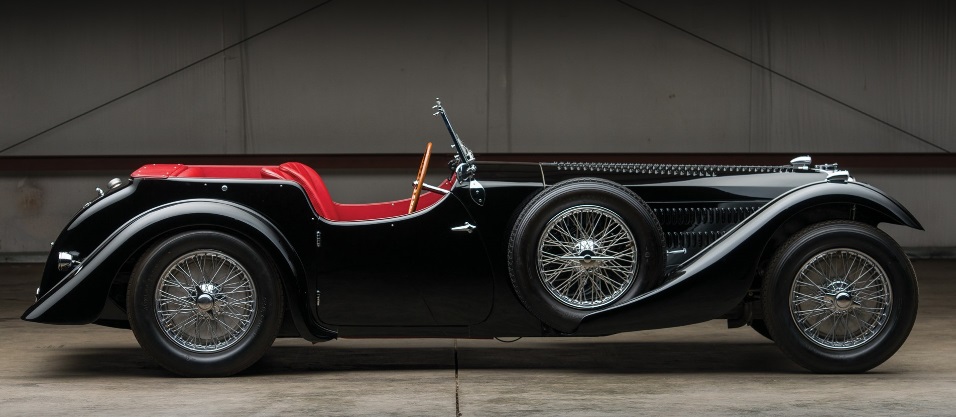
Your chance to see the Bugatti Chiron in the Netherlands.

Late series Bugatti Type 57 Stelvio
Probably factory photograph.
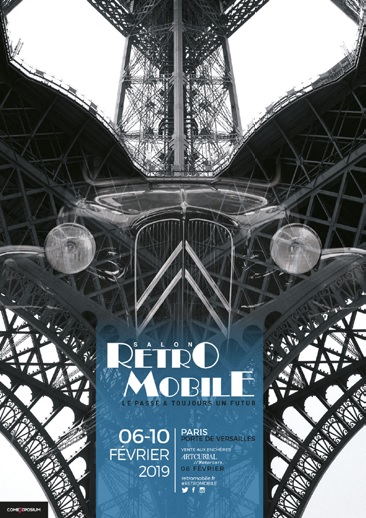
February 6 - 10, 2019 Retromobile Paris, France
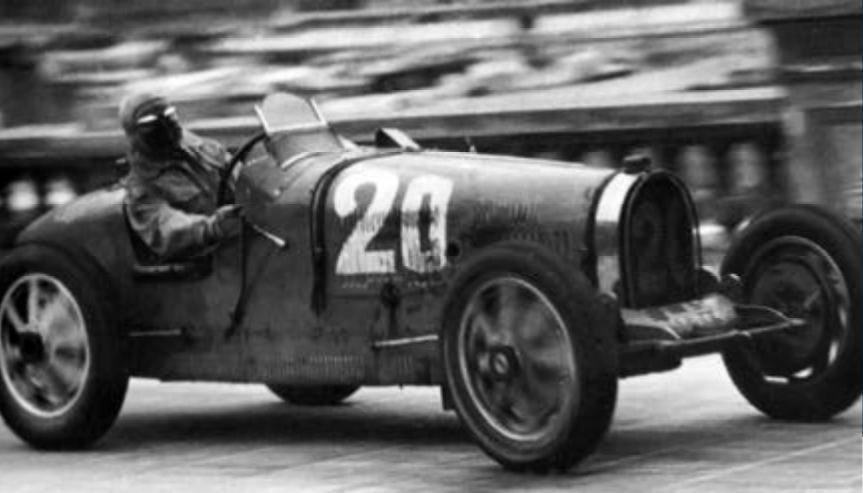
February 6 - 10, 2019 Artcurial Auction At Retromobile, Paris, France
A total of 9 Bugattis!
All cars are described in detail below!
Beware that there are several Artcurial auctions in Paris during Retromobile, also with Automobilia including some interesting Bugatti items!
1925 Bugatti Type 23 " Brescia " cabriolet par Michel Bigatti, Châssis n° 2615
Chassis 2615, equipped with engine 1013, was delivered to the Bugatti dealer in Nice, Ernest Friderich, on 5 August 1925 with three other chassis: 2613, 2614 and 2616. From there they were sent to local coachbuilders. 2615 headed to the Michel Bigatti (!) workshop in Nice. The Bigatti offices were at 7, Rue Cais-de-Pierlas in a superb late 19th century building and the factory was sited at two other addresses: in a parallel street, at 7bis rue Barla, and rue Scaliero. Michel Bigatti was a board member for the Nice Motor Show syndicate. His company had a stand at the Show which took place in January. There is a fantastic photograph of this coachbuilder's workshop showing another Bugatti Type 23 (chassis 2420), delivered to Louis Chiron in February 1925, having its bodywork painted.
Our Brescia was given a pretty cabriolet body in leatherette, considerably lighter than steel. The car was registered new on 18 November 1925 in the name of Christian Dietz, in Sainte Maxime, with the number 3719 M 6. This is the only French registration the car has had. Christian Dietz was one of the oldest garage owners in the town. In 1925, the directory for automobile professionals listed : " Auto Garage Dietz, Tél: 7 à Sainte Maxime ". He had built, before 1918, the beautiful " Villa La Pergola " at 83, boulevard Berthie Albrecht. The town census states that in 1921, Christian Dietz, French, born in Brussels in 1900 or 1901, garage owner, lived at 10 Boulevard du Littoral. In 1926, he was listed at 275 Boulevard de la Croisette, with his wife Aimée Dietz, born in Cavaillon in 1906. Dietz appeared to have a strong interest in Molsheim productions, as there were several other Bugatti registered in the name of the Garage Dietz after 1925: a Type 40 in the spring of 1927, a Type 35A in 1928, a new Type 38 in October 1929, a second-hand competition Type 35 at the start of 1931 and finally a Type 44 in 1932. On 4 July 1927, the vehicle was registered in Nice, with the same number, in the name of Paul Hust. It appears that Hust, an English-sounding name, with an address in a street full of hotels, bought the Bugatti simply to use while he was on vacation in Nice. He drove it during the summer of 1927 and sold it to Paul Kohler on 3 September 1927. Kohler was the finance director of the " Riviera Palace Hotel " in Nice. This hotel, situated halfway up the Boulevard de Cimiez, was built in 1889, in the grounds of a one-hectare park, by Compagnie Internationale des wagons-Lits. Kohler's role, in this immense palace, no doubt brought him into contact with the previous owner, enabling him to buy the two-year old Bugatti from him. The Riviera Palace Hotel later merged with the " Hôtel Moderne " at 8 place la République in Paris XI, and there is still a small brass plaque with Kohler's name at this address on the dashboard. A second brass plaque is engraved with the name " Poupette ".
It seems that Kohler was the last owner before the car was hidden away during the war. The Bugatti was discovered at the start of the 1960s by Jacques Vincent from Vidauban.
It doesn't appear in the Bugatti Register published by H. G. Conway in 1962, so was probably found after this date.
Jacques Vincent set up an automobile scrap yard around 1960. A lover of beautiful cars, he built several hangars to store the ones he felt were worth saving. The well-known classic car hunters, including Jean-Louis Dumontant and André Binda, soon discovered this address. Antoine Raffaeli, who had offered his services, remembers that around forty old cars were stored at his property by the side of the RN7, with several parked out in the field and used to pull the barge ! And so, in 1966, travelling through the Midi with a friend in his Alfa Romeo Spider, the Australian collector Bob King came across the site, having noticed a post-war Bentley with a French body by the side of the RN7! He spotted in the hangars two Type 44 Bugatti and the Brescia.
The Swedish collector Olof Godin, who lived in France at the time, finally acquired the car in 1968, still with its 1925 registration, in strictly original condition with light yellow coachwork, red wings and red leatherette interior. Photos taken by Raffaelli in front of Vincent's villa show the car looking complete, missing only its bonnet and windshield. It is possible to read the coachbuilder's plaque " Etablissements Michel Bigatti, 9 rue Cais- de- Pierlas Nice ", still present on the car.
Godin kept the car in this condition for thirty years. In 1974, during a trip to Stockholm, Bob King saw the car again in a museum, unaware of where the car had gone after Vidauban. There are photos in the file confirming that Godin only started the restoration in 1994. On 25 May 1996 the block was installed, the engine assembled on 8 June 1996 and started on 10 June, probably for the first time since the war. On 14 June the coachwork was fitted and the car took part in the International Rally in Denmark on 18 June 1996, missing only its windshield, which was made in 2000.
The car presented in the sale is a gem. In all likelihood, " Poupette " remained with Paul Kohler from 1927 until the end of the 1950s, and was then saved by Vincent and taken on by Olof Godin who devoted all his energy to restoring the car to its former glory.
Today, the car is presented in good working order, as we have been able to verify on Swedish roads. It is in strictly original condition, and still has its original 16-valve engine and gearbox, as well as the original coachwork by Michel Bigatti. Exceptionally, the superb red leatherette upholstery is also original, as is the lovely dashboard, complete with all its instruments. With transparent and documented history, " Poupette " offers an amazing opportunity to buy a genuine Bugatti Brescia, with an excellent performance for its day, thanks to the outstanding 16-valve engine and lightweight body.
1929 Bugatti Type 44 Roadster by Frugier, Châssis n° 441125
This car is distinguished by the fact that it is still equipped with all its original parts, which is not a common occurrence for a Bugatti! According to the factory archives, it was ordered at the start of 1929 by Léon Boucher, the Bugatti agent in Limoges. Boucher was well known in motoring circles in the area as he took part in several hillclimbs with his Type 35 and Type 43 Bugattis from 1928 onwards (and continued to do so until 1931). Fitted with "temporary two-seat bodywork" comprising a bonnet, two wooden seats and spare wheels, the car was dispatched from Molsheim to Limoges, where it arrived on 14 September. Boucher delivered it to its first owner, René Berthomier, who wished to have a roadster body fitted to it. An architect, he lived at 4, rue de Maupas; this Type 44 is believed to be the only Bugatti he owned.
To produce the bodywork, he turned to a workshop in the city run by René Frugier. The work took about six months, at the end of which the car was graced with attractive two-seat convertible bodywork featuring understated sporting looks and a "dickey seat" at the back with room for a third passenger. On 3 March 1930, Frugier submitted the application to register the car, including the factory report dated 2 September 1929 and signed by E. Pracht, the administrative manager at Molsheim. With the registration number "5401-ZL" and designated as a "2-seat sport torpedo with a rear dickey seat", the Bugatti could now take its place in Berthomier's garage. Together with his wife, the proud owner presented his new car at the concours d'élégance organised on the occasion of the Rallye Paris-Vichy in June 1930. Entered in the class for "open cars of 10CV and above", the Bugatti 44 was awarded first prize. Following this achievement, it appeared in the July 1930 issue of the magazine L'Équipement automobile.
Berthomier kept the car until April 1935, when it was sold in Paris and assigned the registration 9527 RJ6. After this, any trace of the car was lost and the vehicle registration archives - for the most part destroyed for the period 1900-1950 (the year in which the system was changed) - offer no clues. The car reappeared on 18 May 1955, when it was registered 5082 DX 75 to Emile Gautier, an engineer living at 49, rue de Rome in Paris.
Around 1960, the pretty Bugatti made its way to Henri Novo's new garage at Marolles-en-Hurepoix. His son Jean recalls the car, which had not been driven for several years, suggesting that Gautier may have owned it before 1955. In 1970, it was purchased by Monsieur Seydoux, who had a large collection including more than 20 Bugattis at the time. He kept the car for some 15 years before selling it through Edgar Bensoussan to John Mozart, a resident of Palo Alto, near San Francisco. On 26 January 1989, it was registered in the United States with the number 1 QDP 772. The followed year, it was offered at auction in Chicago and then, at the start of 1991, acquired by its current owner. This Bugatti 44 has therefore been in his ownership for more than 27 years! After purchasing the car, he had a comprehensive mechanical restoration carried out, as can be seen from a collection of photographs. The hood was restored and the leatherette upholstery refurbished using real leather.
Curiously, the name of Kellner is sometimes linked to this car. It was known for Bugatti to entrust some cars to this coachbuilder for repairs or service work, and this may be what happened in this case.
Today, the car is in excellent condition; in particular, it is complete with its bodywork and all its mechanical components and original accessories. A photo taken at the concours d'élégance in Vichy in 1930 and another showing it leaving Frugier's workshops in Limoges demonstrate that it remains identical in every way to its appearance at the time. Its owner confirms that it operates perfectly and starts in all weathers, thanks notably to its period Schebler carburettor. In short, this car with its unique bodywork combines a prestigious name and unquestionable authenticity. In this 8-cylinder 3-litre version, moreover, it exhibits the power, flexibility and performance of the best cars of its time.
1932 Bugatti Type 49 Cabriolet, Châssis n° 49469
This car, which left the factory in December 1931 with engine number 341, was ordered for 44,150.30 francs (plus an additional 1000 francs for the Bugatti alloy wheels) by Bariquand & Marre, a company based at 127, rue Oberkampf, in the 11th arrondissement of Paris. Its activities included the manufacture of the Smith-Bariquand carburettors which were fitted to the 5-litre Type 46 and 50 Bugattis, among others.
The bill of sale for this Type 49 was issued on 22 January 1931 and, fitted with a Parisian three-position cabriolet body which it still has today, it was delivered on 2 March 1932. On 1 August 1938, it was given the registration 9975-RL9, corresponding to the department of Paris in the pre-1950 system. Later, it turned up in the hands of Robert Cornière, who registered it in his name in August 1950, with the registration number 3107 L 75. Cornière, who died in 2001, was one of the very first collectors and, as a Bugatti enthusiast, was known for the enormous collection of documents he amassed, one of the largest in France. During the time he owned the car, for reasons which are unknown, but perhaps following a breakdown, he replaced engine number 341 with number 397 from another Type 49 Bugatti which he owned (chassis number 49505). It is believed that engine number 341 was later fitted to René Giordano's Bugatti, chassis number 48505. In any event, it was still a Type 49 3.3-litre in-line eight-cylinder engine with twin spark plugs.
In 1958, Cornière sold the car to Jean de Dobbeleer, another leading Bugatti enthusiast, who sold it in turn the following year to Wynant Dean, a resident of Louisville, Kentucky in the United States. Dean still owned it in 1962, but shortly afterwards it was bought by Paul Morgan, who lived at the time in Philadelphia and then in Westchester. He kept the car until his death in 1998, after which it passed to his children Paul and Mary. On 3 August 2002, it was offered for sale at the Meadow Brook auction but did not change hands after it failed to reach its reserve. At the end of 2002, however, its owners found a buyer: Mark Smith from Skippack in Pennsylvania. Smith had Ralph di Stefano from Pottstown (Pennsylvania) complete the restoration which Morgan had begun. He subsequently sold the Bugatti 49 cabriolet to Nick Harley, who in turn sold it to a magistrate in the south of France.
Today, the car is in very good original condition, with its well-preserved original bodywork, including the wooden structure. The leather upholstery is partly restored and partly original, with a snakeskin appearance, while the carpets and hood have been refurbished. It is fitted with Bugatti alloy wheels, including twin spare wheels. Although the car runs and the gears engage correctly, it is recommended that a complete mechanical overhaul be carried out before entering a rally or undertaking a long trip. The car comes with a very interesting history file, including some period photos and an old French title. It should also be noted that the Type 49 Bugattis are considerably cheaper than the Bugatti 57 Stelvios, whilst being lighter and rarer, and offer similar performance. In addition, this car presents several noteworthy qualities: it still has its original body (one of the most elegant to survive on a Type 49) and has belonged to a succession of well-known and discerning owners. All of these are points which will not go unnoticed by the keen enthusiast.
1929 Bugatti Type 40, Châssis n°40719
This car still has its original chassis and engine. The engine, number 633, was one of a series of twelve (numbers 632 to 643) assembled in December 1928, and the corresponding chassis for these engines were completed during January 1929.
An order was made by the garage Stand Auto of Paris on 5 December 1928, for chassis 40719, along with chassis 40716, 40717 and 40718, but the payment for these four orders of 31 025 francs each was later cancelled. However, the Bugatti sales register shows " 40719/633, 25 February 1929 " in the name of Stand Auto of Paris. This signified the date the chassis was delivered by the factory to the Parisian dealers, and so, even though the bill appears not to have been settled, the chassis was taken out of stock.
There is no other sign of the car until 11 November 1929 when it appears on a list of vehicles in storage at 15 rue du Débarcadère in Paris. Chassis 40719 and 40604 had just been brought back from Daste's business, the Vanvooren coachbuilders in Courbevoie, but hadn't been bodied. The original sales register also indicates, written in pen over the first mention of its delivery in pencil, on 25 February 1929 : " III Grand Prix Bugatti ". This refers to the chassis being one of the prizes for the " Third Bugatti Grand Prix ", held on 1 June 1930, won for the second time in a row by Juan Zanelli.
The manufacturer provided prestigious prizes for this circuit race at Le Mans. There is nothing in the press about what prizes were offered for the 1930 event but in June 1929, at the Second Bugatti Grand Prix, the first prize was either 165 000 francs or a car of an equivalent value (a supercharged Type 35), the second prize was 60 000 francs or a Type 44 chassis, and the third prize was 36 000 francs or a Type 40 chassis. The winners could also choose a number of 1 000 franc cheques that could be used at Bugatti repair workshops
We must assume that chassis 40719, third prize in the 1930 GP, was turned down by its winner, Mlle Hellé Nice, and put up for sale again by the Bugatti factory. In effect, the Type 40 chassis remained part of Bugatti's stock, and was subsequently sold as a new car to Victor Catteau, 8 bis rue François Cuvelle, in Douai, who registered it in his name on 6 August 1930 with the number 168 MB 4. The full company name was : " Victor Catteau Transports, coal, removals, road and rail, furniture storage ".
It is likely that the car was bodied in the north of France, around Lille, but we have no confirmation of this. Its " milord " cabriolet body was of a high quality but didn't have the stamp of a well-known Parisian coachbuilder. Victor Catteau used the Type 40, his only Bugatti, for some five years.
The car was sold in the spring of 1935 and registered in Paris on 9 April, with the number 6509 RJ 6. The second owner remains unknown, as the Seine police records for this period have been destroyed.
In 1937, the car changed hands again, acquired by Paul Bucher, an employee at the Bugatti factory who worked in Paris and Molsheim. His grandchildren have provided us with valuable information on the car, including a photograph, handwritten on the back " Bugatti Type 40, bought second-hand in Paris in 1937, departed for Holland in 1958 with unknown mileage. "
His grandchildren shared their memories of an unusual man : " Our grandfather was a truculent and independent character, who followed his own path. He worked at Bugatti on and off as a toolmaker. During the war, he was sent to Bordeaux by Bugatti. (...) He set up a repair workshop for butchers' machinery. But his vines on the Molsheim hillside, the mirabelles, the making of Schnaps, fishing in the Bruche or the Rhine, the smoked eels and saucisson (he had his own smokehouse) were just as important to him as anything mechanical ! Our grandmother Lucie and her daughter Marlène hated getting into the Bugatti and were embarrassed about that " old banger " which was always breaking down...Grandfather set off on every journey with a box of tools. One day, they all went to see their son Jean-Paul in Luc-sur-Mer, where he was working as a chef. What a trek! The Bugatti broke down, and our grandmother said she never wanted to hear the car mentioned again ! "
A photo from the Bucher family archives, taken around 1947, shows the daughter Marlène, aged just over a year, in front of the cabriolet which still had its Parisian plates " RJ 6 ". This tells us that Paul Bucher originally registered it in his name at an address in Paris, but had not got round to changing the plates !
After the war, the Bugatti was extracted from its hideaway in Alsace, and was registered on 21 March 1946 in Paul Bucher's name, listed as a " turner ", living at 18 rue des Étudiants, Molsheim, with the number 4921 NV 5. When the registration scheme changed, the Bugatti was re-registered on 24 August 1955, in his name at the same address, with the number 522 CZ 67.
The sale to the next owner comes with an amusing anecdote : " The Dutchman who bought the car (opinions vary, for 500 or 1 000 francs) had appeased our grandmother, very greedy, with boxes of chocolates. This Dutch buyer came to visit the Buchers several times in Molsheim, and our grandmother persuaded Paul to sell the car to this kind gentleman. "
The story wouldn't be complete without mentioning that Paul's brother, Emile Bucher, who lived in Molsheim at 9 de la rue de la Source, had been the owner of another Type 40 since 1946, with a totally original Grand Sport body.
And so in 1958, the cabriolet 40719 left Alsace for Holland, before taking up residence in Haute-Savoie. On 27 October 1972, the little brown landaulet was registered in the name of August Thomassen, at his second home in Haute-Savoie, with the number 950 PB 74. He used the car, after a first restoration in the 1960s, without making any notable modifications to it. It was repainted in blue and black, and Thomassen took part in various rallies in the Alps. This included a rally in Mont-Blanc in July 1984, when the car had a minor off which damaged the original body. As a consequence of this, August Thomassen decided to remove the coachwork and build a small four-seater torpedo body, a Grand Sport model. This remains unfinished to this day. At the time, he called on an ex-employee of the Gangloff Carrosserie, Albert Schneider, to help with this project. Schneider tracked down all the original plans, some of which will be passed on to the future owner, and the wooden body is perfectly constructed but not quite finished. The wooden framework has been built, and the wings and lights are in place. A large amount of original parts will come with the car. When the Type 40 was discovered, all the boxes of spare parts were taken with the car for the future owner.
Analysis of the components of the vehicle indicate that the original engine, number 630, is still fitted in the chassis, with the series number 40719 engraved on the engine crankcase. The original rear axle is numbered 630. This mechanically original Type 40 Grand Sport torpedo has only had two owners since 1937, Paul Bucher and August Thomassen. With such a pedigree, and the assurance that it was maintained by a mechanic from the factory between 1937 and 1958, this Type 40 will be highly desirable to all Bugatti enthusiasts. It is a wonderful project that has been largely completed.
1937 Bugatti Type 57 Cabriolet par Graber, Châssis n° 57500
This Bugatti Type 57 started life in January 1937, when chassis 57500 was fitted with engine 373, at the same time as seven other chassis of the same model. On 9 February 1937, chassis 57500 was the subject of an order by the Bugatti agent in Geneva, Jean Sechaud, and the build sheet states a planned delivery date of 12 February. For once, the factory kept to time, and the chassis was delivered on 15 February 1937.
It was transported, in all likelihood by road, from Molsheim to the coachbuilder Herman Graber, in Wichtrach, Switzerland. Between 1926 and 1940, Graber, a highly regarded coachbuilder, built some 751 bodies for the most prestigious marques, including Bentley, Bugatti, Delage, Delahaye, Duesenberg, Lagonda, Lancia, Maybach, Mercedes, Packard and Voisin.
Graber's records indicate contract numbers (which possibly refer to the body numbers), starting with 300 in September 1934. And thus, car no. 300 was a 4-seater Bugatti cabriolet, chassis 57161, and the first of nine Bugatti 57 cabriolets built by Graber between 1934 and 1937. The others built in 1936 were chassis numbers 57394-57444-57448-57483 and in 1937, chassis 57446-57447-57500 and 57539. For these cabriolets, the reference numbers of the Graber bodies ranged between 300 for chassis 57161 to 372 for the final chassis 57539. These Graber Type 57s have all survived. Their bodies all differ in particular details. Chassis 57444-57448-57483-57446, in the order they were built, had a bonnet with three rows of three vertical louvers. The coachwork of chassis 57447 had five rows of five louvers placed at an angle, and 57500 was the only one to have five rows of vertical louvers. Moreover, the bodies of 57171-57394 and 57539 were unique in their design and styling.
Graber's original register entry for 57500 was " Ch 15.2.37. Bugatti N° 363. Ch 57500.Mot 373. J. Sechaud. M. Barbey " The coachbuilder's archives contain three 24x36 mm negatives showing the 4-seater cabriolet 57500 in the Bernese countryside, on the day it was delivered. Painted one colour, probably midnight blue or black, the car was equipped with wheel flanges, standard accessories during this era. The headlights, two horns and the special bumpers, fitted new by Graber, are still on the car today.
The Graber register also records that the first buyer of this elegant 57 cabriolet 57 was Raymond Barbey, CEO of the Banque Lombard-Odier between 1941 and 1973 and grandson of the banker Gustave Ador.
The archives of a collector, containing research on many of the fine cars circulating in Geneva during the 1940s, provides specific information on the car : " Bugatti registered GE 18787. Still in circulation in 1940. M. R. Barbey, authorised signatory in Chambesy. " We believe that Mr Barbey kept his Bugatti during the war and sold it afterwards. The Bugatti Register of H.G. Conway written in 1962 states that the banker only used his Bugatti during the summer, and that the car would have spent the period between 1939 - 1947 in the showroom of the Sechaud garage. However, the record for the 1940 entry appears to partially invalidate this, as the car was still in circulation at this point. Either way, the cabriolet was taken in by Jean Sechaud for a service, before being sold to the client and Bugatti enthusiast, George Pertuiset. The Swiss police archives state: " Bugatti type 57 châssis 57500, registration GE 31319 24 May 1951. Georges Pertuiset, born in 1883, Industrialist, 3 rue du Marché in Geneva. " At that time Mr. Pertuiset was the head of " G. Pertuiset, Biscuits Chocolats et Pains d'Epice ", an established and thriving family business that sold confectionery all over the country.
There is a photograph of the Graber cabriolet with the registration GE 31319, in Jean Sechaud's garage on rue du Stand, next to a Ferrari 195 Inter from 1950 or 1951, probably before the Geneva Motor Show. If this was the spring of 1951, it is possible the car had just been bought by Pertuiset. In 1954, according to H.G.Conway's records, the Bugatti was serviced by Sechaud and, after nearly ten years of use by the biscuit maker from Geneva, it was sold on 3 December 1960. The new owner was a Dutch sculptor, August Thomassen, who was living at the Hôtel des Rives du Rhône in Vernier, an area of Geneva. Newly serviced prior to being bought, the vehicle was registered and given the number GE 1737.
Born in Maastricht on 24 August 1923, August Thomassen combined his passion for sculpture with his love of Bugatti when he produced a splendid bust in bronze of Ettore Bugatti, still on display at the Schlumpf museum in Mulhouse. It seems he didn't drive his Bugatti 57 very much, but nevertheless ordered new upholstery that was probably not fitted. The two-tone paintwork, blue with black wings, dates from the period the car was serviced for Pertuiset. The Bugatti was subsequently registered in Holland with the number BX 65-64 in the name of A. Thomassen from Maastricht.
Inspection of the vehicle reveals a car retaining all of its original mechanical components. The front axle is engraved with the number 373. The original chassis plate bears the number 57500-19CV. The left rear engine mount has the chassis and engine numbers recorded on it, 57500-373. The cover and body of the gearbox are marked 373. The rear axle is engraved with the ratio 11x46 and the number 373. The dashboard retains its original face displaying two large instruments : a Jaeger clock and a speedometer graduated up to 160 km/h. The chassis is fitted with cable operated brakes.
The Graber 4-seater cabriolet body fitted on chassis 57500 is unique. It is without a doubt one of the two most elegant bodies built by this coachbuilder in 1937, on a Bugatti Type 57 chassis.
1932 Bugatti Type 49 Berline 2/4 portes Vanvooren, Châssis n° 49487
Chassis 49487 was finished in January 1932 and the coachwork was fitted several months later. It was the longer version, with a wheelbase of 3.22m. The engine (n°348), the first of 18 versions, was assembled at the factory in December 1931. The body was built by Vanvooren, in Courbevoie, as recorded in the Bugatti coachwork register : " The 2/4-door saloon coachwork by Vanvooren, Courbevoie, on chassis 49487, was billed to the factory on 7 June 1932, for the sum of 21,500 fr. " This body was number 2316 in the list of Vanvooren creations, and an identical car, chassis 49488, body 2317, left the workshop in Courbevoie on 27 June 1932.
Three months later, on 1 October 1932, the Vanvooren saloon 49487 was transported by road to the Motor Show at the Grand Palais, where it served as a demonstration car for the marque. Once back at the factory, it was used by Bugatti representatives during 1933 and 1934.
On 3 November 1933, the car was invoiced to an agent by the name of Dumont, based in Nantes, for the sum of 39 000 francs. We discover from an exchange of letters in February and March 1934 between the factory and the dealer in Niort, J-B Arnaud, that vehicle " Type 3-litre 300 ex-Dumont, chassis 49487 " required the engine to be dismantled in the Arnaud garage, put in a crate and transported to the workshop in Levallois. During February 1934, the chassis was cleaned and the engine re-fitted in the car. There is letter dated 5 March 1934, addressed to J-B Arnaud by the factory, concerning " The engine belonging to chassis 49487 ex-demonstration Mr Bouchard. " This tells us that having been bought by the agent Dumont in Nantes, it was used as a demonstration car by Mr Bouchard, a travelling Bugatti representative, and driven throughout the Charentes, Deux-Sèvres and Vendée departments.
A letter dated 25 May 1935, from Molsheim to Robert Benoist, at his showroom on avenue Montaigne in Paris, tells us that the car was sold to a private buyer : " I have received your message of 23 May and have taken note of the conditions under which you have negotiated the sale of the Vanvooren 4-seater saloon N° 49487 to Monsieur Marcel Baillier. " An invoice followed, dated 28 May 1935 and addressed to " M. Marcel Baillier, 53 boulevard Saint Germain à Paris " which described the car as follows : " 1 second-hand car, fully serviced, Type 49, 3 litres 300… N° 49487, Schebler carburettor, battery ignition, 6 aluminium Bugatti wheels with 5.25 X 18 used tyres, electric lights and start. Vanvooren 2/4 door saloon coachwork. Price net : Frs 30.000. " This was less than half its price new, explained by the fact that it was over three years old. It is worth noting that at the 1931 Motor Show, a bare Type 49 chassis sold for 63 000 francs, with a 3 000 francs supplement for six aluminium wheels.
The Bugatti was registered on 25 May 1935 with the number 9747 AF 3, in the name of " Baillier father and son, Coucy-les-Eppes, Aisne. " This was changed to Marcel Baillier on 28 May 1936. Marcel Baillier's parents earned a good living, running a hotel and a business trading in grain and coal in Coucy-les-Eppes. Marcel Baillier enjoyed a comfortable life, studying law and living on the Boulevard St Germain in Paris. In 1935 he met Simone Beaudier, a pharmacy student, and they got married on 4 April 1936. Coming from the Parisian bourgeoisie, Simone Baillier could have found it difficult adapting to rural life in a small village in Aisne, a long way from her huge apartment on the avenue Henri Martin. However, the couple took over the family business and Simone Baillier founded the " Coopérative Agricole de Coucy les Eppes " which she continued to run until the age of 75. Marcel Baillier died in Courcy on 26 June 1992, and there is now a street named after him in the village.
In the meantime, the Bugatti left the Baillier family after three years to be acquired by Monsieur Marcel Leclerq, believed to be a doctor, who lived at 6 Passe Demoiselle, in Reims. On 18 July 1938, he registered the car in his name under the number 772 KJ 5. Less than a year later, on 1 July 1939, the Bugatti was registered in the name of Georges Ponsart, a farmer's son from Germigny, while retaining its 1938 plate in the Marne. The register of H.G. Conway, published in 1962, shows that Georges Ponsart bought the car from a Parisian doctor. This must have been Marcel Leclerq, who was not originally from Reims. George Ponsart's grandson recalls : " The Ponsart farm grew wheat and beet on an area of around twenty hectares. Georges hunted partridge three times a week and stood out for being the only Bugatti owner in the region. Georges removed the wheels during the war, so that the Germans couldn't take it. After the war, the car wasn't driven much and as children, we used to go into the barn to play in it. When it was sold to Thomassen, it had to be pulled out, in order to be taken to Holland. Georges then bought a Peugeot 203. "
Around 1955, Georges Ponsart re-registered the Bugatti in the new system, and it was given the number 333 CB 51. One of his daughters-in-law, who married in 1950, has confirmed that the Bugatti was used around this time before being sold to August Thomassen on 18 November 1957. He was a sculptor living at Wilhelmina Singel 105, Maastricht, in Holland. He had to use two carthorses to pull the car out of the barn, as seen in photos taken on the day the car was removed.
During the 1980s, a son of Georges Ponsart, on holiday with his family in Holland, made a journey to Maastricht. There he discovered the Bugatti at the back of a garage, where it had not moved for over 20 years. Thus, for over 60 years, the Bugatti Vanvooren Type 49 saloon would remain in Thomassen's garage alongside a Type 57 Graber cabriolet that had been bought in Geneva in 1960.
A current inspection of the vehicle has revealed that the mechanical elements of the car are totally original. The chassis plate, number " 49487-19cv " is original and has never been removed from the bulkhead. The engine case is engraved with chassis number 49487 and has the correct engine number " L 348 " on the front bracket. The bonnet, engraved with the engine number, and the rest of the bodywork are original. The four pillarless doors with vertical locking (Vanvooren pillarless patent), offer optimal access to the passenger compartment.
The dashboard features the large oval display, completely original, containing six gauges including a clock and speedometer, on a black background. The vehicle still has its two spare wheels on the wings and when it was discovered in Germigny in 1957, it still had its original bumpers. The two-tone yellow and black livery is likely to be the original choice of colours from when it was sold to Mr Baillier. The small owner's brass plaque, engraved with " G.Ponsart. Germigny (Marne) " is still on the dashboard.
The Type 49 was the final evolution of the " single cam " Bugatti touring cars, with twin-spark ignition, 9-bearing crankshaft and aluminium Bugatti wheels. It was a powerful and reliable car, with greater flexibility at low revs than the Type 44 and a cruising speed of between 105 and 120 km/h. A test-drive published in the September 1931 issue of La Vie Automobile, written by Henri Petit, concluded with these words : " The 3L 300 Bugatti is, in my opinion, one of the best cars currently available, one of the quickest, probably the most enjoyable to drive and certainly the safest. It enjoys these qualities from new, without requiring any special development by the client. "
The example on offer has been remarkably well protected from new from any modifications. Having had just two private owners before the war, and only two since 1939, during which time it was stored for nearly 60 years, this Bugatti has been biding its time, waiting to be re-commissioned and put back on the road, complete with a special history and enormous potential.
1938 Bugatti Type 57 C cabriolet Gangloff, Châssis n°57596
It was in December 1937 that this car's chassis (n°57596) was assembled and fitted with engine n°19C at the Bugatti factory. It was for an order dated 27 October 1937, issued by Hendricus Van Ramshorst of the "Garage Albatros", the Bugatti dealer in Amsterdam. This garage opened in 1930 and remained in operation until 1976. According to an entry in the garage records on 20 November 1937, the price was set at 8 860 Florins, which was settled on 21 January 1938.
The factory order book states that the delivery of " Chassis 57596 engine 19C, Order number 1002, ordered by Ramshorst for his client Homan " was planned for the start of January 1938. The actual delivery was made on 18 January 1938.
The Dutch dealer's son recalls that his father often had cars transported to Amsterdam. However, a factory note indicates that 57596 went by road from Molsheim to Amsterdam, with temporary plates 1243 W5 and driven by Schwoerer, a Bugatti employee.
The Bugatti factory charged 66 500 francs for the Gangloff cabriolet, describing it as a: " Grey coloured cabriolet, light tan leather trim, black hood. Car equipped with De Ram shock absorbers front and rear, and special front wings. " The Bugatti coachwork register states that the body itself cost 26 350 francs, of which 1 350 francs was for the special front wings. The total bill came to 93 670 francs.
The Type 57C cabriolet was exhibited in the spring of 1938 on the Albatros stand at the Amsterdam Motor Show. It was then bought by its first owner,
J. Homan van der Heide, following a test-drive by Williams, the racing driver and representative of the Bugatti store in Paris.
Homan was born in Indonesia where his father, a Dutch senior civil servant was working. Trained as a chemical engineer, he managed a drug production plant during the 1930s, near Utrecht, before moving to the US where he bought a chemical plant in New Jersey. He was a gifted technician who appreciated beautiful cars that he often repaired himself. He bought his first Bugatti, a Type 55 cabriolet Vanvooren in 1935 and developed an interest in the marque. After acquiring the cabriolet 57C Gangloff, he registered it L 16975, the same as his other Bugatti, as this number referred to the owner and the letter L stood for Utrecht. The garage at his property in Maarssen was heated and big enough for four cars. According to his son, Homan's cars were all maintained by the small garage Broedelet, the Citroën agent in Maarssen. It was Homan himself who introduced Broedelet to working on Bugatti.
In November 1938, Homan exchanged his Atalante 57SC (chassis 57373) for a Ventoux coach (chassis 57720) intended for his wife. The 57C cabriolet was reserved for him. We must presume that when he left for the US, around 1950, the cabriolet 57C Gangloff chassis 57596 was taken in by the Garage Albatros. We do know that during the war, this cabriolet was one of a dozen Bugatti shut away in a church by Hendricus Van Ramshorst, hidden from the Germans. In a photo taken in this building, we can make out the 57596 at the back on the right. It still has Homan van der Heide's registration plate L 16975. It is likely that once the war ended, the cabriolet remained in the Garage Albatros for a long time, as in those days it would not have been easy to sell such a vehicle.
In 1952, the supercharged Stelvio cabriolet was still for sale in the Albatros garage. It sold a few months later to Tibor de Machula, who lived at Brouwerstraat 12, Amsterdam. A talented cellist originally from Hungary, de Machula played with the Berlin Philharmonic Orchestra, conducted by W. Furtwängler. He had tested the cabriolet in 1952 with Arie Van Ramhorst, from the Garage Albatros, and his friend Eggly de Flines. They appear, alongside the latter's mother, in photos taken on this occasion. The car was still in its original colours, grey with blue hood, and the registration G 26142 visible in the photos corresponds to an area of Amsterdam and dates from Van Ramshorst's ownership when the car was recovered after the war. De Machula bought the car in May 1953 and registered it NX 94 23. It kept this number until it was exported to France in 1983.
In the Bugatti Register published in 1962 by H.-G Conway, the Bugatti already belonged to another Dutch enthusiast, Karel Hendrick Sauerbier, of Oostvlietweg 35, in Leidschendam, who had bought the car on 14 September 1961. He ran the printers Stadtler & Sauerbier with his brother in Rotterdam. The two of them collected old cars including several Bugatti : Type 23, Type 35 from 1925, roadster Type 43, Type 44 and three Type 57. At this time, the 57C Gangloff still had a front axle modified with independent suspension, installed by Homan, having been equipped from new with hydraulic brakes. During the same period Karel Hendrick Sauerbier acquired a 1925 Type 35 and the ex-King Leopold of Belgium roadster Type 43A. These last two cars were sold by him in December 1977, in exchange for a farm with outbuildings near Buis-les-Baronnies, in the south of France where he had always dreamed of settling down.
On 22 November 1975, he sold the cabriolet 57C to one of his friends, Gerrit Blokhuis, a longstanding Bugattist (whose four children inherited and continue to share his passion today), who had helped him to rebuild the engine of his Type 43. At this point, the 57C wasn't driving and had to be towed to Blokhuis's home in Hummelo, in the east of the Netherlands. The hood was in very bad conditions but everything else was correct. It took two years of work and a full chassis-up restoration to return the 57C cabriolet to its former glory. The two-tone blue colour scheme was kept but the independent front suspension was removed.
Work to the body was entrusted to a coachbuilder by the name of Anton Siebelink, from Doetinchem, who had already worked for Blokhuis, building a Grand Sport body for his Type 44. Displaying a rare mastery, he carried out every aspect of the bodywork on the cabriolet Type 57 C. The original leathers were conserved, and treated liberally with oil to restore their sheen. The restored car's first outing was in the International Bugatti Rally in Denmark in 1977. It later took part in the International Bugatti Rally in Holland in 1980, and the Bugatti Centenary in 1981.
In March 1983, the car sold to Daniel Roggwiller, a French collector and enthusiast of 1930s classics. Trading in exotic leathers and connected to Hermès, he already owned elegant Delahayes, Rolls-Royces and Hispano Suiza, all maintained by the Hispano Suiza specialist Éric Limpalaer in Calvados. He registered the vehicle with the number 981 EJC 75 and carried out a top-level restoration. The car lost its two-tone livery and was repainted dark blue. Éric Limpalaer carried out work to the clutch, the cam gears, the Stromberg carburettor and he secured the front axle with a push rod. Roggwiller told us that he used the car for nearly 20 years without any mechanical problems. He took part in numerous events including the Munster International rally in 1987 and various Bugatti meetings held every March at Montlhéry. The car then was sold on 18 March 1991 to the present owner.
The car offered in the sale is one of the first supercharged Type 57 cabriolets. Following the launch of the 57C at the Paris Motor Show in October 1936, with the presentation of a Ventoux coach and a black Atlantic 57 SC, production of the 57C began in February 1937. That year, Gangloff built five four-seater 57C cabriolets and in 1938, a new series was launched, with 57596 being the first example.
This Gangloff cabriolet is unique, fitted new with four DeRam shock absorbers at the first owner's request, who also insisted that Gangloff make special enveloping wings. It was also one of the first 57s to be equipped from new with hydraulic brakes. Regularly maintained by the Van Ramshorst garage in Amsterdam during its early days in Holland, then fully restored by Gerrit Blokhuis, the car was subsequently cared for by its Parisian owner for nearly two decades.
1931 Bugatti 51 Grand Prix, Châssis n° 51128
Following the delivery of the first Bugatti Type 51 at the end of April 1931 to Count Stanislas Czaykowski in France, the factory prepared two more cars for the French market in May. They were intended for the two most experienced and successful amateur Bugatti drivers in the country: Jean Gaupillat and Marcel Lehoux.
The Bugatti Type 51 with engine number 9 was for Gaupillat, and Lehoux was assigned the car with engine number 10, that, according to the list of orders, was chassis number 51128. It was built to the client's order and not one of the factory cars prepared for the 1931 season. It had therefore not taken part in any racing when it was delivered to Paris, on 1 June 1931, to Marcel Lehoux, who owned a large mechanics workshop at 13 rue Auber in Algiers. The Bugatti was sold to him for the significant sum of 140 000 Frs.
On 3 June 1931, the Bugatti 51128 was registered in the Seine department, with the number 7958 RE 9. Lehoux must have had a pied à terre in the capital. His 35B - chassis 4935 - was also registered in Paris in 1929 : 2938 RD 2. Of the two type 51s built in May 1931, 51128 - engine 10 - was the first to leave the factory on 1 June, and Gaupillat's: 51130 - engine 9, was not delivered until 13 June.
And so Lehoux was able to line up his new Pur-Sang at the start of the Geneva Grand Prix on 7 June. At the end of a wonderful 150km race, which he led from start to finish, Lehoux claimed victory in 1h 47 min, ahead of A. Lumacchi in a Type 35B. The other Bugatti Type 51 (chassis 51126) entered in the race, driven by S. Czaykowski, went off the circuit and didn't finish.
On 21 June, in the 25th ACF Grand Prix in Montlhéry, Lehoux shared the wheel of 51128, race number 52, with his great friend from Rouen, Philippe Etancelin. In the 15th of 100 laps, they were forced to retire with mechanical problems having been in 6th position during the first hour of the race. During the practice session, Lehoux confided to C. Faroux : "Etancelin and I thought 10 hours was far too long for a fast race, five hours seemed more than enough."
Two weeks later, on 5 July, Lehoux secured a second victory in 51128, in the 7th Grand Prix de la Marne at the Gueux circuit. The early retirements of Chiron in the factory Type 51, and Count d'Arnoux in another Type 51, meant the battle of the twin-cam Bugatti was between Czaykowski and Lehoux. At the finish line, the Maserati Type 26 of Dreyfus split the two. Lehoux won on this fast circuit having driven at an average speed of 143km/h, without beating Chiron's 1928 record of 146km/h in a Type 35B. "The very fine driver from Algeria has just shown us what a great talent he is, and with luck on his side, he may go on to succeed in splendid style. He led the race in a remarkable fashion, increasing his average speed every lap. The winner was decorated and complimented by Mr Paul Marchandeau (the mayor of Reims), the Viscount of Rohan and the prefect of Marne. "
In the German Grand Prix, on 19 July, at the Nürburgring, Lehoux was with five Type 51 factory cars and the private entries of Von Morgen-51123 and Wimille-51130. Just after halfway through the race, Lehoux went off the track. " A lack of grip on the Bugatti means they have never been able to push hard in the wet...we only had to lament the retirement of Lehoux, who was working very hard and luckily the car was hardly touched. ".
After a break of six months, 51128 returned to the track in Lehoux's hands. It was in Monaco, for the 4th Grand Prix, on 17 April, that the Type 51 resumed service to finish 6th overall. Lehoux finished ahead of the three official Type 51s of Williams, Bouriat and Divo !
At the Grand Prix d'Oranie, on 24 avril, Lehoux retired a third of the way through the race with a mechanical problem. After another retirement caused by an issue with the connecting rod in the first few laps of the Italian Grand Prix at Monza, on 5 June, Lehoux brought 51128 home in second place in the Grand Prix de Lorraine on 26 June.
A problem with the differential forced him to retire at the German Grand Prix on 17 July, and he suffered the same problem before he'd even started the race on 24 July in Dieppe.
During testing at Dieppe on 21 July, Lehoux filled in the entry form for the Klausen race, to take place on 6 and 7 August. Lehoux recorded the address of his workshop in Algiers and his membership of the A.C.F.
The rest of the season was marked by a series of poor results for 51128.
But from August or September 1932, 51128 was joined in the Lehoux team by his new Bugatti (51144), a secondhand car, with bodywork already bearing the scars of competition.
In February 1933, the first Type 51 belonging to M. Lehoux - 51128 was officially registered, following its sale, in the name of "Louis TRINTIGNANT, wine producer in Châteauneuf-du-Pape."
Louis Trintignant competed throughout the 1932 season in his supercharged 2-litre car. During these races, various improvements were made by his mechanic Paul Sauret (1908 - 2001), known as " Paulus ", who would continue to work for the Trintignant family until 1947. He deserves a mention here as he supported Louis in his first foray into racing until the fatal accident in Peronne in 1933, and Sauret was also the first person to offer support to the young Maurice when he took his first laps round the Mirimas motor racing track in 1938.
1932 was an active year with many victories, local and national, for Louis Trintigant in his Type 35C.
With such good results and experience under his belt, Louis Trintignant was able to approach the 1933 season confidently, especially with such a formidable machine at his disposal, Lehoux's old Type 51.
The Bugatti 51128 was registered in the name of "Trintignant Louis, Châteauneuf-du-Pape", with the number 3652 ZA 2, on 9 February 1933. It is possible that Lehoux sold the car to Trintignant in September 1932, and that the latter had no need to change the registration before the start of the 1933 racing season. Ten days after it was registered, the Bugatti lined up for the start of the Grand Prix de Pau, on 19 February. It was on the grid with eight other Bugatti Type 51s ! The result of the first race was encouraging : Trintignant finished 4th behind the Alfa Romeo Monza of Etancelin and the Bugatti Type 51s of Dreyfus and Bouriat, all pretty much factory cars.
In the spring of 1933, Louis Trintignant entered several regional events, with decent results matching the other Bugatti Type 51s driven by Falchetto, Braillard and Lehoux in 51144.
Trintignant finished 5th in la Turbie on 6 April, in 4min 1sec 3/5, behind Braillard in 3min 59sec 4/5, but in front of Villoresi's Alfa Romeo Monza. A few days later in Nice, after a 500m rolling start, he finished 4th, behind Braillard and Canin in a Type 35B.
On 14 May, in the hillclimb des Alpilles, Lehoux set a new record in 51144 while Trintignant and Braillard matched the previous record.
With no photos available of these three races, it is difficult for us to attribute these laurels to Trintignant's Type 51, rather than his Type 35C (4941). However, the results appear to indicate that the power of the car used in the Turbie and at Les Alpilles was comparable to that of the Type 51s driven by Braillard and Lehoux.
Paul Sauret told the author in 1992 that he had put the engine from the 51 in the 35C chassis, at the request of his driver. It is logical to assume this happened in April 1933. There is every chance that in the Alpilles hillclimb on 14 May, the twincam engine, offset bulkhead and twin opening fuel tank had already been fitted ; the car matched the pace of Braillard's 51 and was in the same configuration, with a Type 51 engine in a 35C chassis, as it was four days later at the start in Péronne. It seems that L.Trintignant had been disappointed with the handling of his Type 51 chassis and found his old 35C more manageable.
During the transformation, the side exhaust, with modified bonnet, and possibly the whole bodywork was retained on chassis 4941, which was now fitted with the engine from 51128. Thus prepared the car was loaded onto the Studebaker lorry duly driven by Paul Sauret, who left Sainte-Cécile for Péronne on 18 May.
Destiny lay in wait for the valiant driver from Provence :
"On 20 May in the morning, during the first test session, Louis Trintignant regained confidence in the car that he had often steered to victory. The twin cam engine was pushing hard and would probably have set a good time. But then a policeman crossed the road, the driver swerved to avoid him and hit a milestone marker causing the car to barrel roll for 50 metres. The Bugatti finally landed on its wheels, the driver was thrown out, with his throat slit by the glass windshield. His body lay there by the side of the road, with blood gushing from the wound, and was covered with newspapers. " (Extract from the Archives d'une Passion.A.R.)
The local press reported on the tragedy : "At 7 o'clock in the morning on 20 May, an explosion shook the village of Mesnil-Bruntel. The Bugatti of Trintignant left the road at full speed, on the long straight. Perhaps a tyre had burst. Had he been blinded by the sun ? The car left the track and barrel rolled, skimming the righthand side of the road by number 15 on the Grande-Rue. The car was thrown to the left and crashed into the wall of another house. The driver was thrown out and was hurled onto Mme Polleux's doorstep. A few hours later, Louis-Aimé Trintignant died in hospital in Péronne. He was 30 years old." Paul Sauret would have been the first on the scene to attend to his unfortunate friend.
The next day, during the race, the young Guy Bouriat, sales director at Bugatti Paris, was killed at the wheel of his own Type 51. Following the tragedy that claimed the lives of two of the bravest Bugatti drivers of the day, the Automobile Club of Picardie and l'Aisne set up a fund to raise money for a monument, erected in 1934 commemorating Guy Bouriat (1902-1933) and Louis Trintigan (1903-1933). On the righthand side of the monument, engraved in stone : "Louis-Aimé TRINTIGNANT, born in St Esprit (Gard) on 17 May 1903. Killed during testing at the Grand Prix de Picardie on 20 May 1933."
The poor, damaged Bugatti was quickly retrieved from the village of Mesnil-Bruntel and taken back to the garage in Chateauneuf du Pape by Paul Sauret. The chassis, the original type 35C chassis 4941, was so badly damaged that a new one was ordered from the Bugatti factory. This fact has been confirmed to us by P.Sauret. The original 51128 chassis, in the garage since April 1933, stood next to the 35C engine from chassis 4941, both elements considered to be less effective than the 35 chassis - 51 engine combination.
While waiting for the new Type 35 chassis they had ordered from Molsheim, it made sense for Louis's mechanic to fit the Type 51 engine back in its original chassis, with the holes there ready for everything to slot back in.
A current examination of the two chassis confirms the following : the chassis with engine 51128 has the original frame, from June 1931, that was delivered to Lehoux. It bears number 705. As for the current chassis of the car with engine 4941, it was discovered by Antoine Raffaelli at Gros in Robion : its frame had been built at the factory in the spring of 1933 and carries the number 730. The destroyed 1929 35C chassis, must have had a frame number of around 630.
A little over three months after the tragedy, Louis Trintignant's widow sold the Bugatti Type 51, reunited after the event with its original engine, to the former Terrot factory driver, Jules Rolland. The vehicle was registered at his home address 3 place Jules Gasquet in Avignon, with the number 3784 CA6, on 26 August 1933.
Jules Rolland (1900-1996) was a well-known figure in motorcycle racing. Between 1924 and 1928 he was the most successful champion in the sport, as official rider for Terrot.
Rolland's brilliant career came to a halt on 27 April 1928, with a serious accident during testing for the hillclimb, la Côte des 17 Tournants, in Saint Forget, near Versailles. His injuries prevented him from racing properly again until 1934.
His return to competition in the ex-Louis Trintignant Bugatti Type 51, represented a physical challenge for Rolland and an opportunity to realise his ambition to be a racing driver. And so, from 26 August 1933, the Bugatti was stored in the garage, biding its time.
On his first trip out in the car, Rolland won the Course du boulevard Michelet, in Marseille, on 25 March 1934. He set the fastest time of the day by 30 seconds on the kilometre sprint, with an average speed of 118.421 km/h. Rolland was congratulated by the previous recordholder, the Bugatti driver from Marseille, Aristide Lumacchi.
On 6 May, at the Val de Cuech, near the Salon de Provence, Rolland set the quickest time of 2 min 51 sec on this 4.25km hillclimb. On 18 June, he took part in the Mazamet hillclimb, followed by Saffres, near Cavaillon on 15 July. On 19 July, he retired on the 7th lap of the Grand Prix d'Albi.
On 26 September, he competed at Mont Ventoux, the scene of some of his past triumphs, and achieved 6th in the over 2-litre category, behind Delmo and in front of Delorme, both in Bugatti 51s.
The local press applauded his performance : "Among the entrants, we find, after a seven year absence and a terrible accident, the motorcycle champion, former motorcycle record holder at Ventoux and overall winner in 1927, J. Rolland, driving a Bugatti 51."
In 1935, he took part in several races in his Bugatti 51128 : we find him on 27 May in the Alpilles, on 2 June in the Val de Cuech and finally on 4 August in Valréas.
Maurice TRINTIGNANT, born in Sainte-Cécile in Vaucluse, grew up with a view of Mont Ventoux behind the vineyards that lay stretched out towards the horizon. Born in 1917, he was the last of Fernand Trintignant's six children. At the age of ten, he spent time at his brother René's garage in Avignon, that housed several Bugatti. From 1930, he would have seen the Grand Prix cars turn up in Sainte-Cécile : the Type 35A, the 35C and the 51 belonging to his brother Louis. "I drove my first car at the age of seven, in the courtyard on my parents' estate at Sainte-Cécile les Vignes.
For Maurice, 1938 was the year that everything changed. In February, he decided to buy his brother Louis's old Bugatti Type 51, waiting for him at Rolland's in Aix.
The car was registered in his name on 15 February 1938, with the number 932 ZA 4, at his address 1 rue Henri Fabre in Avignon.
Maurice was not yet an adult, and in order to buy the Bugatti, he had to borrow from a money lender. He then persuaded Paul Sauret, the mechanic of his late brother Louis, to teach him to drive the Type 51, on the race track at Miramas. He also needed his older brother Raoul to apply for the special dispensation needed for him to enter the Pau Grand Prix taking place on 10 April. Sauret was not very keen, but the test session at Miramas convinced him : " You are up there with the fastest.". Maurice has written on the back of a photograph "Testing the car at Miramas, 173 average lap speed" and on the back of another photo taken in March 1938 at Miramas are the following notes in Maurice's handwriting : "3rd test session after rebuilding the engine. Worn left rear tyre burst on the way into the corner opposite the righthand stand, 200 km/h. Best lap average speed 204." The Trintignant's mechanic, galvanised by the youngest brother's performances, agreed to help fend off bad luck. "I didn't want another brother to die in my arms."
Maurice Trintignant used a garage, with P.Sauret, in the centre of the village of Châteauneuf-du-Pape. For his first participation in a Grand Prix, on 10 April 1938 at Pau, Maurice wore his brother Louis's old racesuit and white cap. He finished a respectable 5th, where his brother had finished 6th in the same car in 1933, and took home his first winnings, a prize of 3 000frs.
On 5 June, M. Trintignant won his first race at the Grand Prix des Frontières de Chimay (Belgium). "Lap after lap, Trintignant ran in the 4th row, then, picking up speed, he passed Tremoulet's Delahaye and caught up with the Bugatti 57S of Mathieson, setting record times: 5'11' on the 6th lap and 5'8' the lap after, which equated to 127, 052 kms/h. The public got behind Trintignant's fight back, as he improved on the best time of the day, lap after lap. On the 10th lap he was just 15 seconds behind Mazaud, and this came down to 8 seconds behind the leader on the 11th lap. At the Salles corner, Trintignant succeeded in passing Mazaud and completed his final lap in the lead, recording a time of 5'3' (129.148 kms/h), the best time of the day."
In September, the young winner took part in the 12 heures de Paris à Montlhéry, in the sport category. The Bugatti Type 51 was duly equipped with wings and lights for the occasion. After a good start, Trintignant was running in 2nd behind the Talbot of the eventual winner Lebègue. However, after 4 hours racing, the Bugatti's rear left wheel came off and he was forced to retire.
For the start of the 1939 season, the Type 51 was equipped with wire wheels to replace the aluminium ones. The mechanic Paul Sauret must have taken advantage of the winter break to fit a Cotal gearbox, before racing started again in 1939. He remembers installing it after two or three races.
The season began with a retirement at Pau on 2 April. Maurice Trintignant hadn't taken part in testing, and started last on the grid. He eventually retired on the 13th lap.
He then won the hillclimb at Saint-Europe (Orange) where Louis had also distinguished himself. Maurice recorded the best time and overall record time for the event. On 28 May, he won, for the second consecutive time, the Grand Prix des Frontières in Chimay. On 30 July, he finished 5th in the Circuit des Remparts in Angoulême, run in formula libre.
The war brought the young Bugattist's racing ventures to an abrupt halt. It was at the Mas d'Arnaud, the lovely 17th century property belonging to his step-father, that Maurice was arrested by the Germans and deported, first to Mathausen, and later to a work camp in Austria. On his return from captivity, Maurice rediscovered his Bugatti 51, which had spent the whole war hidden in bits in hay bales in Vergèze. Paul Sauret was still there ; the Trintignant team reunited to compete in Grand Prix racing once more.
In symbolic fashion, the Bugatti was brought out of the hangars at Vergèze to take part on 9 September 1945 in the Grand Prix des Prisonniers, at Bois de Boulogne. The entire Trintignant team travelled there, in the family Buick : Paul Sauret and his wife Laure, Maurice and his first wife's two daughters, as well as Fernand-Pierre, Raoul's son. The race was organised by the A.G.A.C.I. on the 2.8km circuit.
The race was won by the best and most popular driver of the day : J.P.Wimille, in the most powerful machine on the grid, a 4.7-litre Bugatti Type 50B single seater. Maurice was forced to retire, as during the car's period of inactivity, rats had made a nest in the fuel tank of the Bugatti 51 and, although it had been cleaned, the fuel pipes became blocked with rat droppings, constraining the talented driver's enthusiasm. At the end of the race, the winner, Wimille, gave Maurice the nickname "Pétoulet" (pétoules = rat's droppings).
Following the armistice, M.Trinignant had rented M. Roumestan's motor car garage in Vauvert, near Vergèze. He duly installed the faithful Sauret, and their collaboration continued until 1948. Sauret and his wife moved in next to the garage, on rue de la République, in Vauvert.
The Grand Prix de Nice 1946 was the first international race after the war. It took place on 22 April over a distance of 65 laps. Trintignant started mid-grid having set a respectable time in qualifying, but he retired on the 30th lap with a fuel problem.
In the Grand Prix de Marseille, on 13 May, M. Trintignant started on the front row in the first round, but retired with magneto problems.
The following week, at the Grand Prix du Forez, on the Andrézieux circuit, Trintignant started in last position, and drew attention for his remarkable recovery. Although he was hoping for a podium finish, he had a fuel leak and had to make do with 4th place.
On 30 June, M. Trintignant lined up once more for the start of the Grand Prix du Roussillon in Perpignan. The Bugatti finished in 5th place, despite ignition problems, and recorded a quicker lap time than the winner, Wimille, in his Alfa Romeo 308.
At the start of July, M.Trintignant retired with a fuel leak at the end of the Grand Prix de Bourgogne which took place in Dijon. He also failed to finish in the Prix des 24 heures du Mans which was contested in Nantes on 28 July, due to a problem with the spark plugs.
The 1947 season saw Trintignant take part in the Grand Prix de Marseille, on 18 May, in a Bugatti Type 51 in the 1500cc class. Maurice Trintignant and Paul Sauret told us the story of this other Bugatti Type 51A, bought in 1947 from the mechanic and racing driver from Bordeaux, Charles Huc. This was Louis Villeneuve's old Type 51A, chassis 51157-engine 31.
At the end of 1946 or the start of 1947, the 51A 51157 had been bought by Huc. Sauret recalls that the latter "lent it to M. Trintignant, for one race, as Huc had a health issue , […]. His car was a twin-cam 1500cc, with mechanical gearbox, a large supercharger and a narrow radiator that got really hot." It is possible that the race Sauret was referring to was Marseille on 18 May 1947.
Trintignant subsequently agreed to sell 51128 to Huc. Maurice remembers : " I sold my 51 to Huc from Bordeaux. He owned a 51A single seater, but he never paid me. My car (51128) stayed with me, equipped with the engine from Huc's 51A single seater (51157). " And so there was an exchange or mix of the two engines 51128/51157. Sauret adds to the puzzle : " Huc's mechanic and his wife came to our garage. We had put the 2300cc engine from 51128 in the 1500cc single seater, then after the race, the 1500cc engine was put back ". Sauret recalls also having gone to Bordeaux to fetch the 51128 that Huc hadn't paid for. It had been taken from the garage in Vauvert, and was found in bits at Huc's.
After 1947, 51128 remained in Trintignant's hands, still with the 1500cc engine. Huc's single seater 51157, equipped with the 2300cc engine, left for North Africa shortly afterwards and disappeared. Maurice Trintignant held onto his Bugatti Type 51 which was on display in his livingroom in Mas d'Arnaud until 1974.
The car was then acquired by the collector Jacques LEFRANC who owned a small automobile museum in Surry le Comtal in the Loire. His mechanic Marc Defour was given the task of restoring the car with the aim of preserving its originality as much as possible and retaining the exterior appearance of a Grand Prix Bugatti marked by history.
An intial inspection revealed that the chassis was slightly warped, probably twisted by a violent shock to the wheel against a kerb. It was decided not to straighten the frame as it would not have been possible to replace the body. Defour adjusted the arc of the springs, diagonally, so that the car was balanced on the four wheels. The hollow front axle was not damaged. The steel bulkhead was out of shape, as if it had been crushed, to such an extent that the magneto was no longer in line with the camshaft. There were small pieces of wood used to wedge the axle into position.
The 1500 engine had lost the upper crankcase, and a wooden model, made by Pierre Dellières replaced the missing piece. Through the assistance of Geoffrey Saint John, Lefranc had an upper crankcase sent over from England, complete with crankshaft and pistons. During the reassembly, it was discovered that the 1500cc crankshaft had the number 31 engraved at one end and on a bearing, the number that was also on the lower crankcase of engine 51128. According to Marc Defour, this engine part almost certainly came from Trintignant's car. Maurice admitted to having lent a bugattist friend the crankcase and shaft that was in 51128 at the time it was in the 1500cc configuration ; and these parts were never returned to him. It is worth noting that an old case, probably the pre-war factory replacement, stamped 51128, was then fitted.
The engine work by Defour allowed the original crankshaft and pistons, with the correct dimentions, to be kept. He installed new piston rings and pins, and had to remachine the bearing face of the cam shaft case. The ignition set-up was the same as for the 2.3 litre.
The car hadn't had an original Bugatti gearbox since before the Cotal box was fitted at the end of 1938. However, Trintignant had installed a wooden copy of a Bugatti gearbox, fixed with wood screws, which had an original cover fitted onto it. Defour had to change the gearbox support rails that had been modified for the Cotal box. He found an old case and fitted it with new ratios. Concerning the original gearbox, Trintignant apparently told A. Chomienne : " I lent it to a guy from Marseille who never returned it. I must get it back. "
It has the original rear axle housing and a new differential, 14X54 was fitted. The enormous fuel tank of over 150 litres was completely corroded. Its bulky shape impinged on the passenger compartment. This hadn't bothered Trintignant, who was small, but Lefranc couldn't get into the cockpit, so a standard tank was fitted. New Bugatti patented aluminium wheels were fitted for safety reasons.
There had been no alterations to the period coachwork ! It conformed to the car as seen in photos of Louis Trintignant at Péronne in 1933. It is likely that following the accident that made the chassis of the 35 (4941) unusable but didn't affect the bodywork, the body was refitted by Sauret to 51128. The paintwork shows traces of a dozen successive layers, including one white and three different shades of blue, one fairly light. Today the car retains the dark blue paintwork, in superb original condition. An old upholsterer from Surry le Comtal restored the original seats, while probably renewing the padding. The dashboard was re-turned, the dynamo with its old mounting, was kept. On the lefthand side, the missing auxiliary lubrication pump was replaced. The radiator core, no longer in honeycomb form, was redone. The restoration was finished in a few months and Defour decided to run the car in on the 7km road between the garage and his home. To his surprise, the 1500cc engine had good torque at low revs. In first gear on tight bends, he thought the clutch was slipping, so he adjusted it and set off again. The two rear wheels had been slipping. Before and after the restoration, the car was exhibited at the Musée de Surry le Comtal. Jacques Lefranc never used it.
Many years later, the Bugatti was bought by Christian Pellerin, before being sold at auction on 14 December 1992, in a sale held by l'Etude Poulain-Le Fur at the Palais des Congrès de la Porte Maillot, in Paris. Since that date, the car has belonged to Jean-Claude Miloé. It has been maintained by the garage Novo, the Bugatti specialist in Marolles en Hurepoix (Essonne).
During the commemoration of the Grand Prix de Péronne in 1993, the current owner had the honour of allowing Maurice Trintignant to drive the car, at the exact spot where his brother Louis had died some sixty years earlier. At this occasion, Maurice inspected the car closely and passed on the following information to J.C. Miloé : " I got Sauret to carry out several modifications to the car. The holes in the bulkhead show the low setting I had for the steering, as I was short. I had this opening made to the right of the steering wheel, to get a little air in the car as, being small, I was too enclosed. The hump on the lefthand side of the bonnet, near the fixing for the holding strap, was there to help with cooling the dynamo which gave me a problem in some of the races. The sleeve visible on the front right arm of the chassis was added to provide reinforcement after an accident. The foot on the rear brake flanges prevented the brake cable from jumping out. I had a rearview mirror fitted on the right and the fixing holes are still there. "
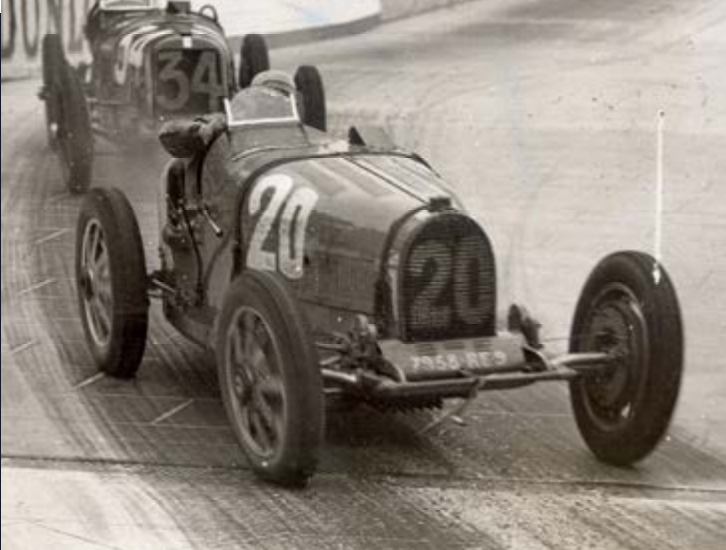
1936 Bugatti 57 Atlantic modifiée Erik Koux, Châssis n° 57654
Authentic Bugatti Atlantic cars are nowadays in possession of collectors who are not willing to be separated from them and they are among the most expensive automobiles in the world. Therefore, the enthusiast wishing to enjoy this fabulous creation from Jean Bugatti (based on the brilliant chassis 57S) had no choice but to turn to a recreation where the best mixed with the worst. In this case, we are delighted to offer one of the most beautiful and accurate Bugatti Atlantic replicas still in existence. It has indeed the particularity of relying on an authentic Bugatti 57 (chassis No 57654) with its saloon 57 bodywork done by Gangloff; it was also pretty complete from what recalls Hans Matti, a swiss specialist of the brand. This car was registered in Paris in 1954, it was then purchased around 1986 by a serious French collector who owned a dozen Bugatti automobiles. During that period however, he was not satisfied with the four-door 57 and considered it only as a base, since he was dreaming of the ultimate when it comes to Bugatti: the Atlantic.
It turns out that during the same period, a Danish engineer living in the South of France named Erik Koux began to think about making Bugatti Atlantic replicas. As a true lover of the brand and a creative genius, Erik Koux would embark himself into this crazy venture of rebuilding this mythical car. In 1989, both men began an exchange of correspondence in order to initiate a project to build an Atlantic as close as possible to the original, based on a 57 654 version. In November 1991, the chassis of the car is shipped to Erik Koux's workshop in order to start its transformation. Differences between a 57 and a 57S are mainly concentrated around the engine (dry crankcase for the 57 S), the chassis (lower for the 57 S) and of course the bodywork. Consequently, Koux provided a 57S type chassis from his factory, as well as the engine crankcase which was especially made since the original part was untraceable. He customised it using the camshafts from the 57 654, number 9G (left) and 28D (right). The engine-transmission assembly was then handed over for a complete restoration to Laurent Rondoni, the world renowned specialist from Ventoux Moteurs in Carpentras.
The car is then transported to Lausanne at the Fernandez workshop in 1993, one of the most reputable swiss experts when it comes to bodywork development. This specialist has worked on fantastic projects, such as the bodywork restoration of a Talbot "Teardrop" which won the Pebble Beach concours d'elegance and, also the realisation of its first aluminium Bugatti Atlantic by Koux in 1992 for an important Dutch collector (57302). They consequently gained a deeper knowledge of this model and on that basis, all detailed dimensions and plans of the bodywork were provided to them by Erik Koux (from the original car). That's how they ask to Ebenisterie G.Clavel to built the entire wooden structure before converting it into a brilliant and successful aluminium body. Once finished, the bodywork is then sent for painting at the Margairaz workshop based around the same town in Lausanne. The car is finally polished and completed at Guifrida and Fernandez in 1995, before successfully passing its technical tests and getting registered for the road in France in 1996. This unconventional car goes hand in hand with a large folder which allows to track its elaboration and fabrication, with tons of correspondence with Erik Koux and numerous invoices. One of the things to remember is that this Atlantic is very much based on an authentic Bugatti 57; Hans Matti, who conducted his inspection, consequently identified all the numbers taken from original Bugatti parts. This car has rarely been on the road since its completion and remains in superb condition today.
Let's not forget that the Atlantic had a 180 hp Bugatti 3.3 litres dual-camshafts engine which could reach 200km/h, an extremely rare privilege at a time when even the most amazing touring automobiles could reach up to 130km/h only. With this kind of performance, the Atlantic was in a league of its own, consequently being perceived as an extraterrestrial machine in a world of high and traditional cars. Erik Koux's achievements were made with great seriousness, loyalty and love of the brand. This Atlantic is a tribute to what many consider to be the most extraordinary car of all time.
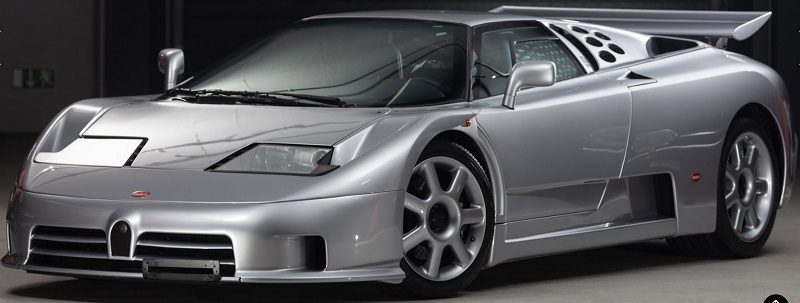
February 6, 2019 RM / Sotheby's Auction Place Vauban, Paris, France
1994 Bugatti EB110 Super Sport, Chassis No. ZA9BB02E0RCD39012, Engine No. 086, Estimate: €1.3M - €1.8M
2012 Bugatti Veyron 16.4 Super Sport, Chassis No. VF9SG25243M795038, Estimate: €1.5M - €1.7M
2014 Bugatti Veyron 16.4 Grand Sport Vitesse, Chassis No. VF9SV25274M795073, Estimate: €1.575M - €1.8M
2018 Bugatti Chiron, Chassis No. VF9SP3V33JM795060, Estimate: €2.36M - €2.75M
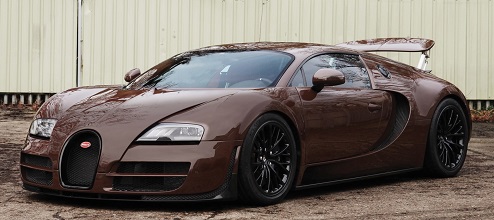
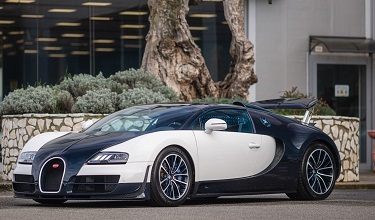
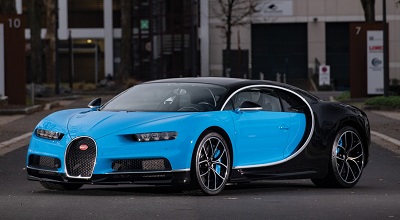
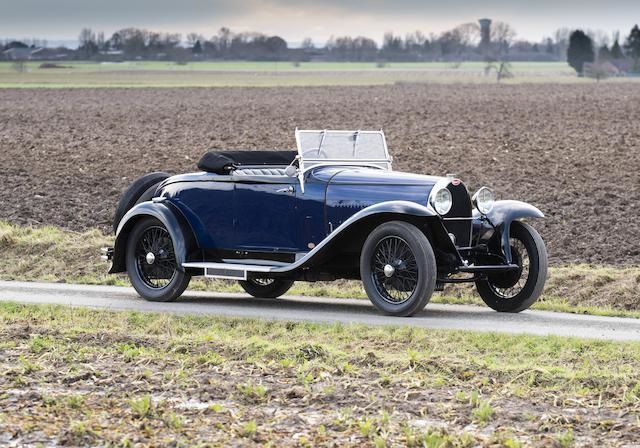
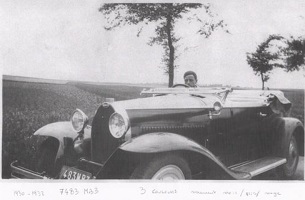 February 7, 2019 Bonhams Auction: Les Grandes Marques du Monde au Grand Palais Le Grand Palais, Paris, France
February 7, 2019 Bonhams Auction: Les Grandes Marques du Monde au Grand Palais Le Grand Palais, Paris, France
1930 Bugatti Type 40, Chassis no. 40852 Engine no. 770, Estimate: € 380,000 - 460,000 (£ 340,000 - 410,000)
1928 Bugatti Type 43 Grand Sport Tourer, Chassis no. 43258 (43291) Engine no. 132, Estimate:
€ 1,250,000 - 1,450,000 (£ 1,100,000 - 1,300,000)
First owned by Crown Prince Leopold of Belgium
2018 Bugatti Type 35 Child's Car, Estimate € 4,000 - 7,000 (£ 3,600 - 6,300) no reserve.
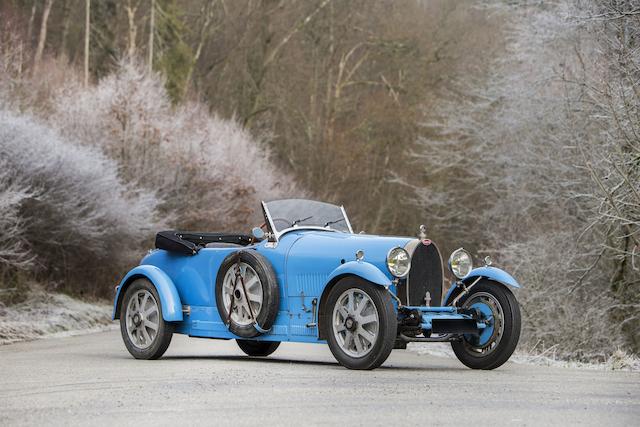
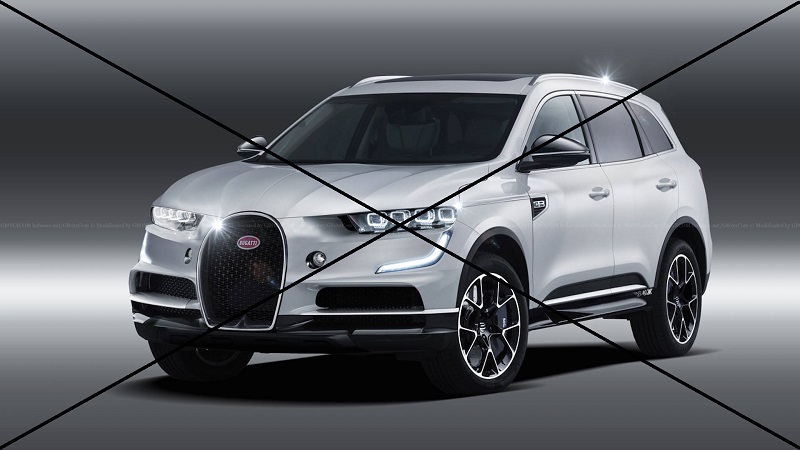
January 25, 2019
|
Very few automakers have resisted the temptation of not adding an SUV to their lineups, and you probably only need just the fingers from one hand to count them all. Much like McLaren has reiterated it won’t be going down the SUV road, Bugatti is now confirming there are no plans to come out with a high-riding model. The reveal was made by company president Stephan Winkelmann in an article published on the official Bugatti site.
While the said article talks about what Bugatti was able to accomplish in 2018 and what lies ahead for 2019 when the Molsheim brand is celebrating its 110th anniversary, at the very end of the article, Stephan Winkelmann briefly mentions SUVs. Here is what the former Lamborghini and Audi Sport boss had to say: Although the man in charge at Bugatti has made it crystal clear there won’t be an SUV, it doesn’t necessarily mean the hypercar luxury marque won’t launch a four-door model in the following years. The very same Stephan Winkelmann has strongly hinted about eventually adding a second model to join the Chiron, so we’re keeping our fingers crossed for a long overdue production version of the magnificent 16C Galibier concept. Technically, that was a five-door hatchback, which rumors had suggested would go by the name of Royale (as a nod to the Type 41) in production guise, but it never happened. As you may recall, what looked like a Bugatti with rear doors was spotted from afar hiding underneath a car cover back in late August 2018, but we haven’t heard anything about the mysterious vehicle since then. It looked quite promising, to be honest. More practical Bugatti aside, Stephan Winkelmann announced the company assembled 78 Chirons last year and that production is booked until the end of 2021. As a refresher, the slightly lighter Chiron Sport and the extreme Divo were introduced in 2018, and more derivatives could be in the works according to the rumor mill. A report published by Automobile Magazine last September talked about a lighter Superleggera variant, an open-top Aperta, and a hardcore SS.
|
Source: Motor1.com
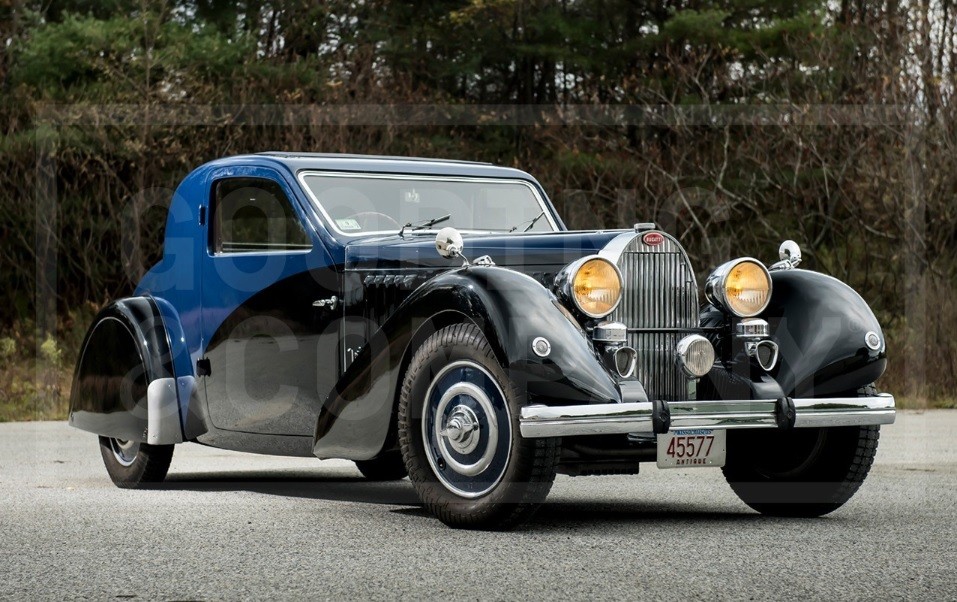
Gooding Scottsdale auction, January 18-19, 2019
1936 Bugatti Type 57 Two-Light Ventoux, Chassis 57469: Sold for 792,700 euro
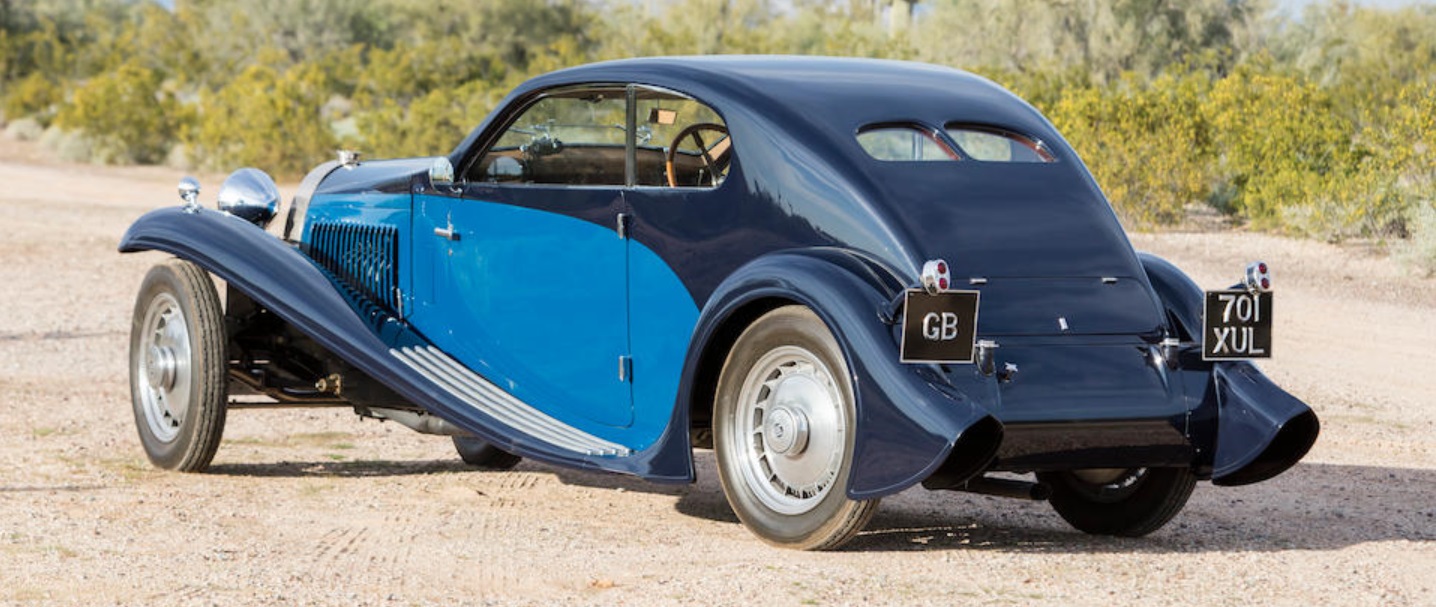
Bonhams' Scottsdale auction, January 17, 2019
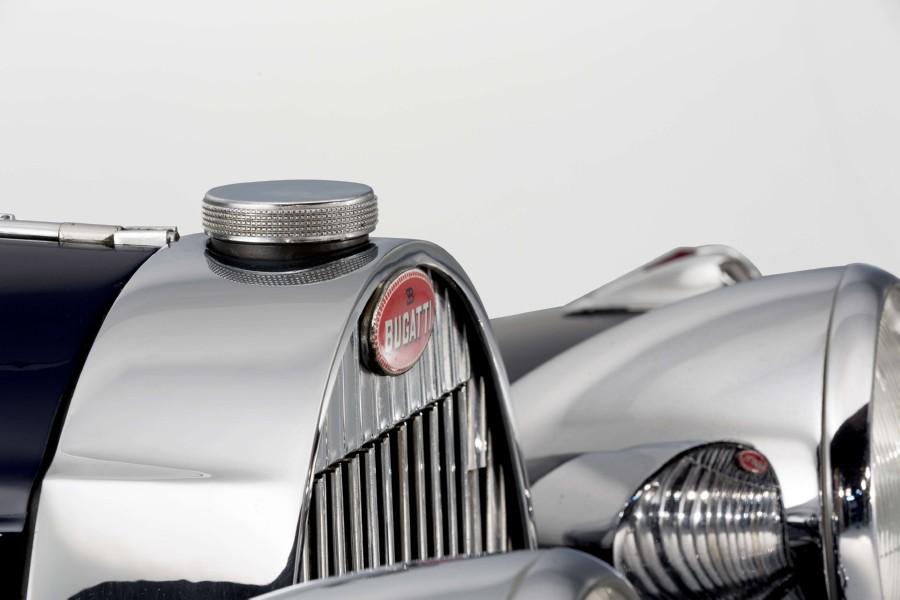
Interested in expanding your collection of Bugattis, and couldn't find what you were looking for in Scottsdale?
In that case, you have to go to Paris in early February, where you can score a dozen Bugattis or more!
Bugattis range from the "humble" Brescia, to several T49's, T57's, an EB110SS and even a couple of 1001 or 1500 HP VW-Bugattis!
The list is long and impressive, and includes three from a recent barnfind in Belgium, which was all over the media. Those three are the only ones without reserve, so maybe this is your chance to get lucky!
More info and description of the cars, including estimates in the Events section of this page.
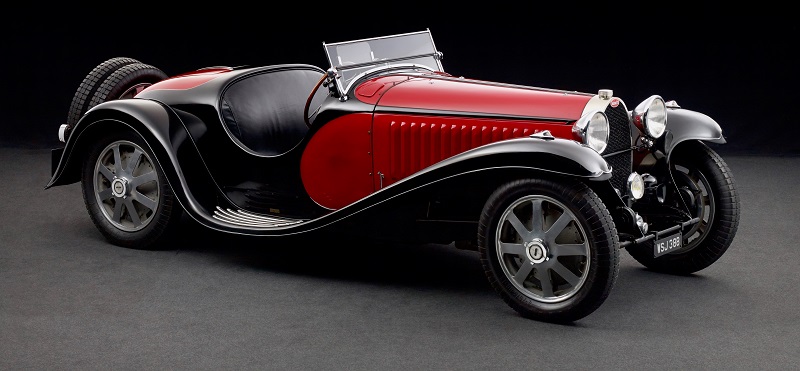
|
Eight Best of Show winners from major 2018 concours d’elegance events are finalists for The Peninsula Classics Best of the Best Award. The winner is to be announced February 7, 2019, at The Peninsula Paris during Retromobile. Two of the eight finalists are owned by David and Ginny Sydorick, who won at the Cavallino Classic with their 1956 Ferrari 250 GT coupe by Zagato and at Pebble Bech with their 1937 Alfa Romeo 8C 2900B Berlinetta by Touring. The nominees are:
Among the other judges are car designers Chris Bangle, Peter Brock and Ian Callum, auto executives Henry Ford III and Ratan Tata, and collectors that include Ralph Lauren, Jay Leno, Nick Mason, Rana Manvendra Singh and the Earl of March (founder of the Goodwood festivals). And last year's winner? That was the 1936 Bugatti Type 57SC Atlantic co-owned by the Mullin Automotive Museum, and Rob and Melani Walton, which won “Best of Show Concours d’Etat” at the 2017 Chantilly Arts & Elegance. |

|
Click on the image above or on this link to view the movie of when the Bugattis were taken out of the barn, and how!
More info on the owner/colleector:
Thomassen's father was one of the first people to drive an automobile in Maastricht and his eldest daughter the first woman to have a driver's licence in the town! On Saturdays, young August was allowed to accompany his father in the car, delivering medications to the surrounding villages. The car was also a feature of their holidays, transporting the family to France. Automobiles held a real fascination for August and he made his first model of a car in wood when he was eight. It was a passion that never left him. War broke out. His older brother was a leader in the resistance. One evening, while helping people cross the border, he was spotted by the Germans. Following a painful interrogation, he was deported to a labour camp in Germany, where the prisoners had to make bombs. To avoid collaborating, he deliberately cut his finger. One evening, he decided to make his escape in daring fashion, by clinging to the underneath of the freight train that passed through the camp. Dressed in prison clothes, the young August travelled through Hitler's Germany, jumping on and off trains. Perpetually at risk of being shot, he finally reached the Netherlands alive, thanks to a sympathetic German train driver who kept quiet. Following a night spent in a coffin in a cemetery, he found his way back to his uncles Brand (of Brand beer) who agreed he could go and hide in their villa in Eijsden. During this period in hiding, he cultivated his second passion, sculpture. His involvement with the resistance led him to collaborate with the RAF in England until the end of the war. After the war, he built a motorcycle from spare parts and travelled around Spain for five months. He spent three months studying at the Academy of Fine Arts in Madrid and the Prado, where he began to understand his destiny: to study the beauty of the human form through sculpture. On his return from Spain, was admitted to the Royal Academy of Fine Art in Brussels, where he obtained his degree and won a first prize in portraiture. His first commission was for two sculptures three metres high for the 'Liga' biscuit factory. With his earnings he bought a piece of land in Belgium and built a studio where his future Bugatti T49 and T57, and the Citroën Trèfle, would reside for nearly 60 years. Commissions of his typical psychological portraits of politicians, actors and businessmen took him to Geneva, where he bought his second Bugatti T57 from the Geneva chocolatier Pertuiset. His first Bugatti T49 had been acquired in the Vosges, Germigny, from two farm workers who had been using the car to transport potatoes ! In 1958, he married the lovely Renée Van Noorden, who from the start encouraged him to pursue his passions. Together they would have two daughters. Every day he played the violin to manage his hypersensitive and restless character. In 1963, August Thomassen bought a site in the mountains in Haute Savoie : the land of his ancestors. He built his second studio there, and considered himself to be French for the rest of his life. It was here that he worked for years restoring his beloved Bugatti T40 to its original condition, working alongside Schneider, the former master craftsman at Gangloff. Around 1985, his bust of Ettore Bugatti was bought by the National Automobile Museum in Mulhouse, and remains there today. In 1987, his bronze bust of Yehudi Menuhin was unveiled by the famous violinist at the Menuhin School of Music in London. The bust of Lips, the founder of the National Automobile Museum of Holland was inaugurated in 1990. His Bugattis inspired him by their pure forms and lines; their eternal beauty was priceless to him. August Thomassen worked on his two passions, Bugattis and sculpture, in his studios in Belgium and Haute-Savoie, until illness prevented him at the age of 90. It is impossible to remain unmoved by the passion and charisma of this character who shaped his life in such a determined and unusual way. The cars in question?
|
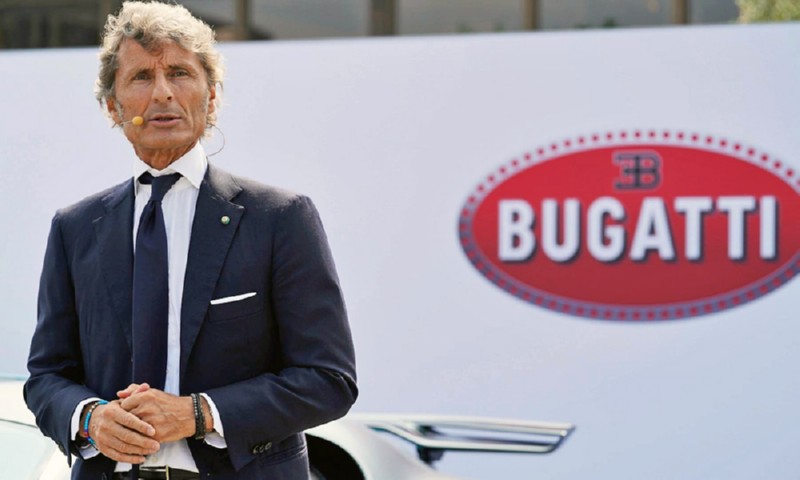
|
Bugatti CEO Stephan Winkelmann says although the French brand is “ready for more than one model”, he didn’t ever confirm it would be an SUV. In September 2018, the 53-year-old seemingly dropped a hint that the hypercar-maker could be considering building an SUV. Now, speaking to Motor Trend, the former Lamborghini boss again said if the firm “did a second model, it would enter into a different segment”, but added “I never said we are building a Bugatti SUV”. “The press said it because I pushed for the Urus at Lamborghini. Coming from my background, what I said is that we are looking into every segment, body style and region. It has to be an approach good for the world and not one part. We have an idea of where we want to go,” Winkelmann told Motor Trend. “It’s not about volumes, but in terms of visibility; if you sell 100 cars or 1 000 cars, there’s still no visibility. But we cannot do a copy of what we do today. So a second car has to enable us to sell more than we sell today. It would be a different segment with a different price tag, but above all the other competition." Winkelmann furthermore revealed a top speed run for the Chiron was “not on the agenda”, before adding an open-top version of the hypercar was not planned either.
|
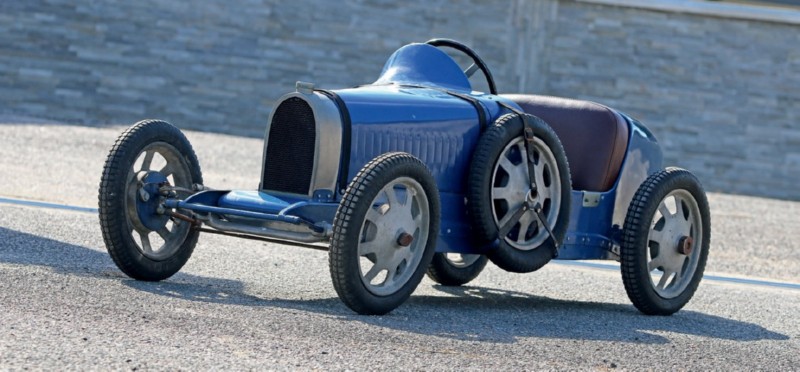
Aguttes Auction, Lyon, France, November 10, 2018
1927 Bugatti Baby, Estimate € 20,000 - 40,000: Sold for € 75,640
Mecum Auction, Las Vegas, USA, November 15 - 17, 2018
1930 Bugatti Type 46 Faux Cabriolet,
Coachwork by Veth & Zoon
Chassis 46293, Engine no. 157,
Estimate: $1,150,000 - $1,250,000: Sold for $1,012,000
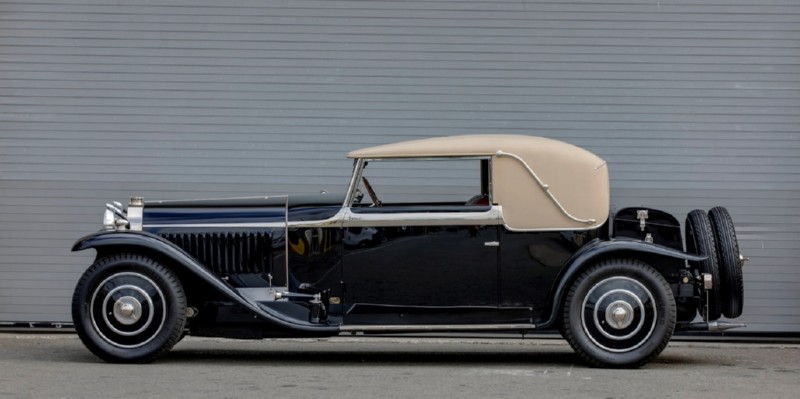

November 13, 2018
Sotheby's Impressionist & Modern Art Evening Sale, New York, USA, November 12, 2018
Rembrandt Bugatti, Deux Girafes, dated 1906 Anvers and stamped with the foundry mark A. A. Hébrard. Cire Perdue Bronze
Estimate $1,500,000 — $2,000,000: Sold at: $1,815,000
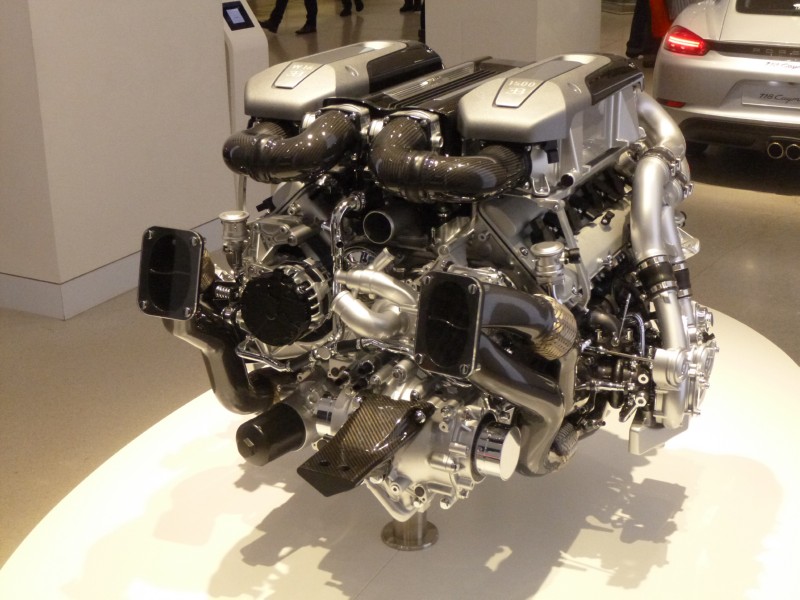
November 10, 2018
|
Bugatti president Stephan Winkelmann says the Chiron’s W16 will be the “last of its kind”, suggesting increasingly strict emissions legislation will kill off the hefty quad-turbo engine “sooner or later”. Speaking to Autocar, Winkelmann said the French brand would – like every other major automaker – soon be forced to take “radical steps” when it comes to powertrain development. “Sooner or later, the legislation will force everybody to take radical steps,” the former Audi Sport boss told the British publication. While Winkelmann didn’t say it outright, it’s all but certain the Chiron’s eventual replacement will feature some sort of electrification. “There will be no new 16-cylinder. This will be the last of its kind,” the 53-year-old added of the 8,0-litre unit that is currently used in the Chiron, Chiron Sport and Divo. And that’s not all that’s changing at Bugatti. In September 2018, Winkelmann dropped a pretty hefty hint the brand is considering building a super-SUV, revealing he would look “at every body style”… |
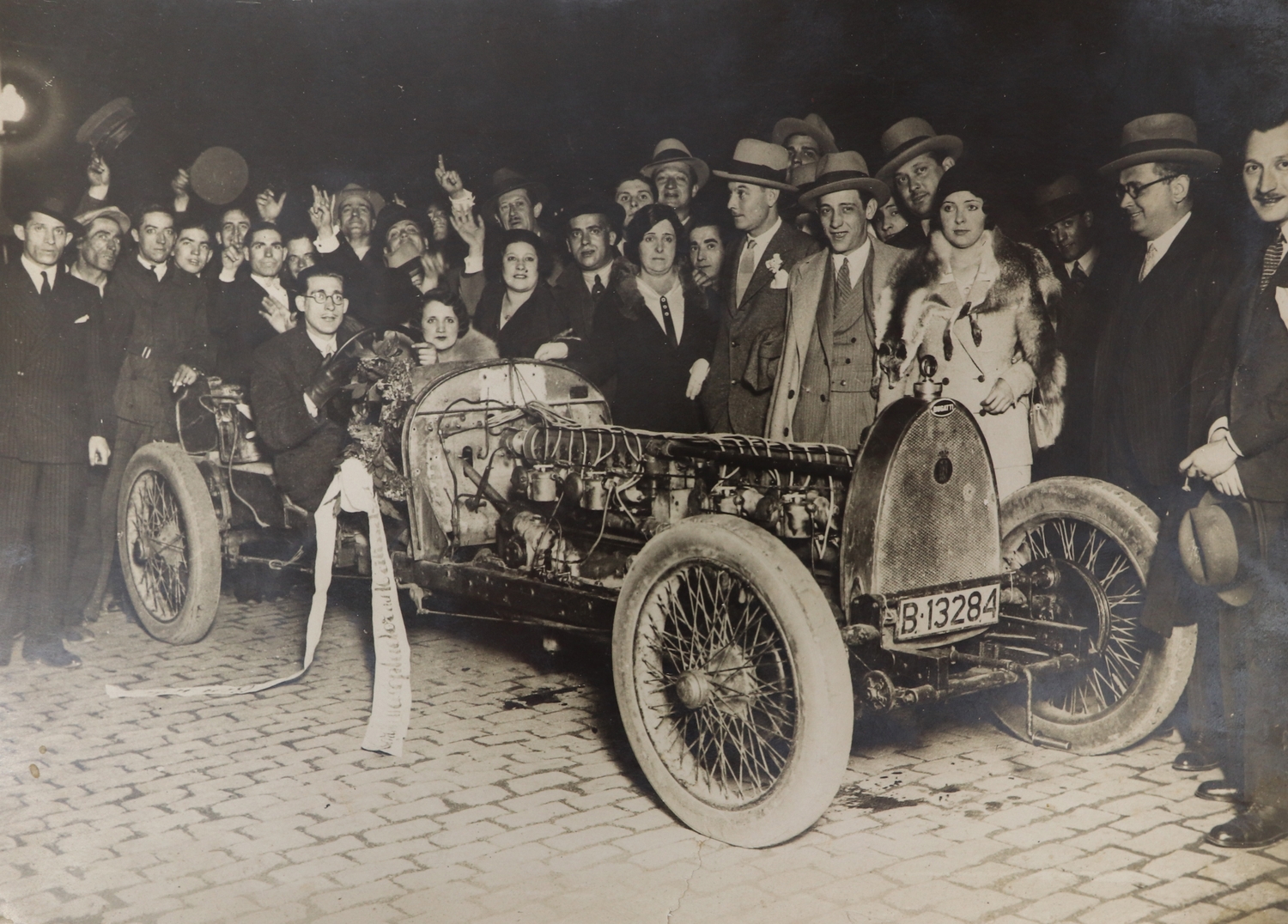
October 15, 2018
|
This seems to be a private build, two eight-cylinder Type 30 engines on a lengthened chassis, making this a straight-sixteen! Probably in the 1920's, and the license plate B-13284 indicates that this must be Spain: Barcelona. It must have been a true
event where this Bugatti appeared, judging from the number of lookers-on. And: the car received some sort of prize, unluckily for me it impossible to read the text on the long ribbon. However, of course knowing Ettore Bugatti, it may also be that he was in some way involved in this project.
Àlex Vergés on Facebook explains that the man at the wheel is José Tous, from Barcelona. The car is a T-30 which was registered initially to
Francisco Samaranch. First published by Greg Morgan on Facebook, who found the photograph on an auction-website in Germany. Click on the image above, the photograph is in fact rather detailed! |
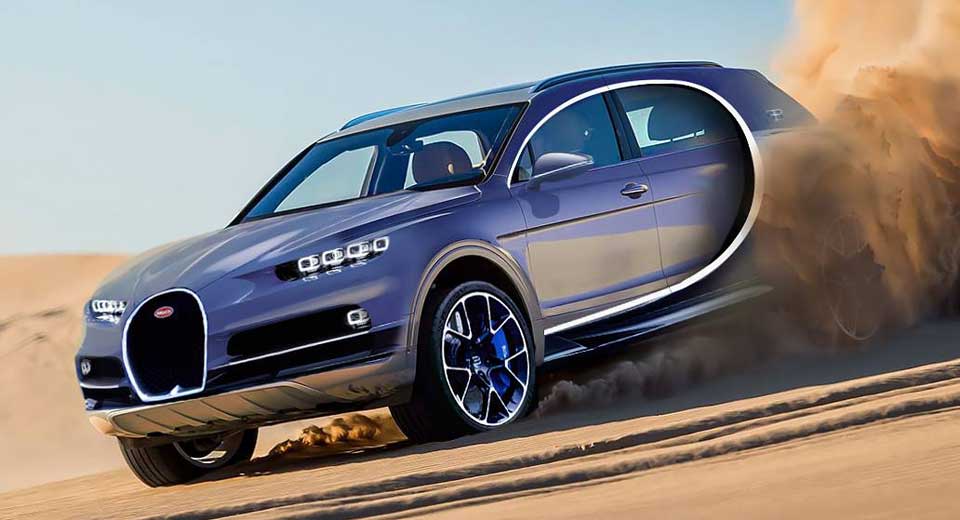
October 13, 2018
|
Last month, Bugatti CEO Stephan Winkelmann said the brand could benefit from a second model,
but he didn’t provide many clues as to how the range would expand. Now, he reveals Bugatti is
considering an SUV, as well as hybrid cars. “The brand is ready for more,” Winkelmann said at the Paris Motor Show. “The W-16 engine is at the core of the brand today, but it won’t remain the heart forever.” The new Bugatti Divo, and the Chiron on which it’s based, pack a 8.0-liter quad-turbo W-16 with 1,479 hp. But Winkelmann says the brand may add new engine and chassis variants. He said a hybrid engine “could be part of the future—you have to consider social acceptance in terms of emissions.”
However: Other sources do not mention an SUV, but Chiron Superlight, Super Sport and Roadster Variants. It remains to be seen how customers of the Divo will react to these additional models, especially since all three will enjoy extremely limited production runs. Nonetheless, it is not surprising to see Bugatti attempting to cash in on a market that’s quickly being flooded by bespoke Pagani Huayras and custom-made Koenigseggs. If the three aforementioned Chiron-based models do see the light of day, they will be powered by Bugatti’s familiar 8.0-liter quad-turbo W16 engine. However, it seems likely that the automaker will tweak power and torque settings according to each version. As if these weren’t enough, Bugatti is also thought to be considering an all-electric hypercar. Such a vehicle could be co-developed not just with Porsche, but also electric hypercar specialists Rimac, in which Porsche bought a 10 per cent stake just a few months ago. So - could we be seeing one of those terrible SUV's bij Bugatti? (The design shown above is not an offical one by Bugatti) I surely hope not. Other versions of the Chiron, or even a Sedan or Limousine would be Ok, in my opinion!
|
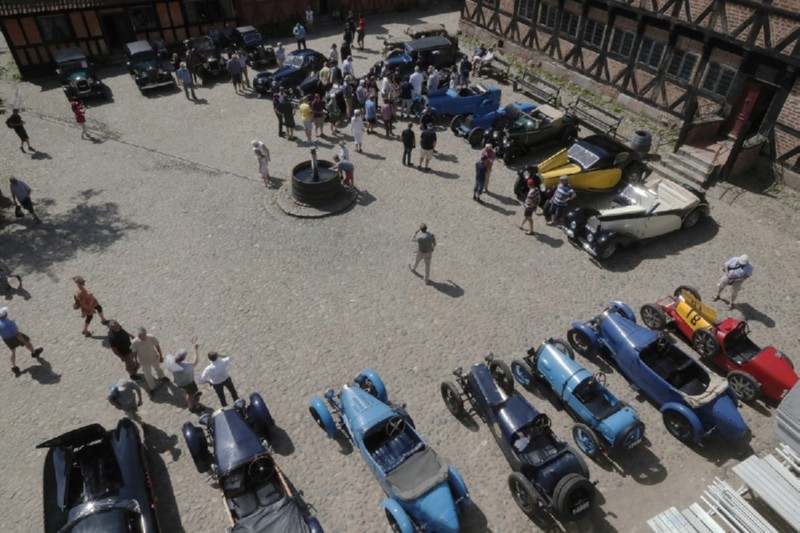
 September 29, 2018
September 29, 2018
|
September 2, 2018 We are very pleased to announce the founding of Bugatti Club Denmark. On 2 June 2018 the club was established formally at a founding meeting in ‘Den Gamle By’ (‘The Old Town’ museum) in Aarhus on one of this year’s most wonderful summer days. A total of 15 Bugatti cars ranging from type 13 (1925) to type 101 (1951) roared down the narrow streets to gather at the central square of the idyllic museum town. More than 30 potential members attended the founding meeting, where the history, the idea and the plans of the club were presented by the board of founding members. Purpose of the club The purpose of the club is to be the hub around which everything Bugatti in Denmark is revolving for enthusiasts. The club is open to all Bugatti-owners and anyone with a genuine interest in Bugatti cars. The club will arrange two annual meetings. One in late Spring or early Summer in conjunction with the annual general meeting. The second meeting will be an Autumn tour – a September saunter. Our first Autumn meeting will take place very soon, as the club-members will gather on 21 – 23 September in northern Zealand for a two-days outing. The club will also be responsible for the Nordic Bugatti Meeting once every six years. Next time for this event in Denmark will be in the Summer of 2021. In addition to national Danish meetings the international forum of Bugatti clubs has accepted Bugatti Club Denmark to host the International Bugatti Rally 2026 – IBR2026. History of the club Actually the new club is a revival of an earlier Bugatti club in Denmark, established informally in the mid-1960s under the name 'Société des Bugattistes Danois'. Founders were Danish Bugatti enthusiasts Erik Koux, H. C. Rasmussen, Jørgen Møller, Peter Elley, Jørgen Riber and Jens Nielsen. This club was active until the late 1970s. To acknowledge the efforts of these pioneers, the new club bears as a second name: ’Société des Bugattistes Danois’. The old Société arranged three rallies with international participation: 1966, 1970 and 1977. The 2026-edition will be the fourth in Denmark, - 60 years after the first meeting.
More information
Vive la Marque!Peter Zinck - Frank Studstrup - Peter Bering - Marc Vogel - Peter Koux, Founding membersFor full contact details, go to Bugatti clubs page Photographs from the founding meeting by photographer Jakob Bonfils. |
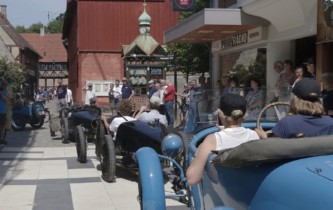
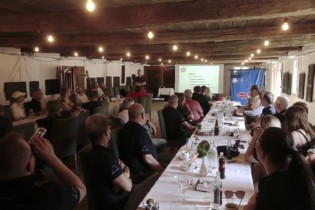
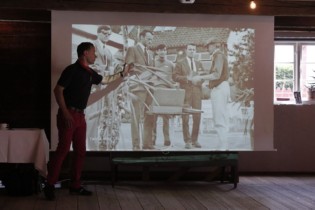
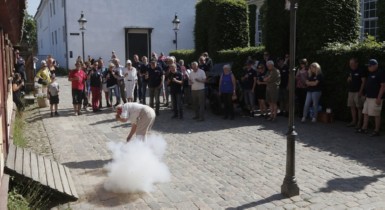
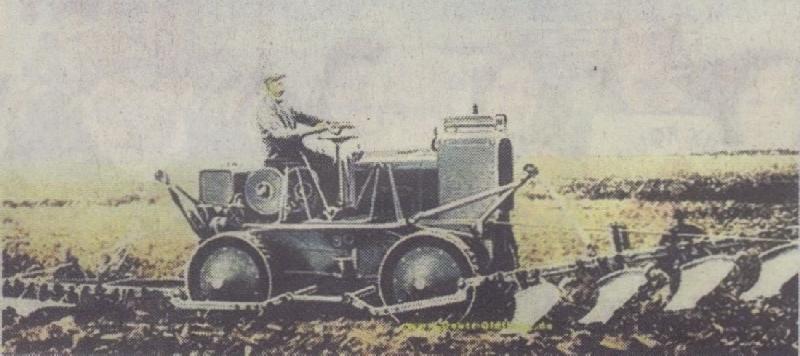
September 23, 2018
|
I had already heard about this from Wolf Kiefer, but found an article about it with more details in the Alsatian Newspaper DNA from Sunday 16, 2018 (Thanks Daniel, for leaving it on the breakfast table!). It is written by Josef Pohl from Cologne, with whom I came into contact recently. I will find out more and come with more informations and hopefully drawings and photographs in due time! We all know that Ettore was working for the Gasmotoren Fabrik Deutz in Cologne, for which he designed a few automobile types. Also, Ettore copied the Deutz red-oval logo for his own brand when he started building cars under his own name in 1910. (Yes, I know that officially the brand started in 1909, but that were only a few weeks when during Christmas time Ettore and Friderich painted the inside of the building. All machinery came in 1910, and just a few cars were built that year, 1910). The Gasmotoren Fabrik Deutz has extensive archives, also about this period, and publishes about it's history regularly. Ettore Bugatti is mentioned as being part of this history. 1908 was a successful year, both for Deutz as well as Bugatti. Several dozen of chassis were completed and many of them delivered to the coachwork company Utermöhle. Meanwhile, Ettore had time to design more than just cars, there were Race boats, Trucks and of course the tractor pictured above. All of these were powered by the same 7 litre engine of approximately 50 - 60 horsepower. The boats were tested in the harbour of Mülheim, the Trucks each had a capacity of 5 tons. However, it is believed that the Tractor was in fact the first one in the world. It had four-wheel drive, and could move in both directions at the same speed of 5 km/h. It could for example be equipped by a four-bladed plow at the front and the rear, the mechanisme to raise and lower these was patented by the engineer Brey, who worked for a company named Müller, famous for agricultural equipment. Of course, other uses were also possible, like using it as a tow-vehicle. There was a separate drive shaft for the plow, with a conical leather lined coupling. This, as well as the engine, gearbox, differentials, thus the complete drive train was designed by Ettore Arco Isidoro Bugatti. This Tractor was in use untile the mid-twenties on the Langen family manor in Oberelvenich near Zülpich. Arnold Langen junior told this to Josef Pohl. Thus: as we can see here: still new discoveries can be made, if one only looks for them, and has a broader mind than just the automobiles from the 1920's and 30's! |
Clicquez pour l'article original en Francais
|
The company will release three versions – Roadster, Super Sport and Superlight. Only recently we watched the new new model Bugatti Divo built on the basis of the famous Chiron hypercar. But now there is evidence that the company is preparing three versions – each with its own characteristics, according to the Chronicle. If You thought that Bugatti Divo’s would be it's last reinvention of the Chiron hypercar, then you were wrong. According to the magazine Automobile Magazine, the Bugatti works at least on three models: Superlight, Super Sport Roadster. And they are all intended for the construction of certain features of the car to a new level. One of the next models will be a model Chiron Superlight – car is aimed at maximum reduction of mass. In addition will be significantly improved aerodynamics. After that will be released a track version Chiron Super Sport, which will apply all developments in aerodynamics and weight reduction, but with additional emphasis on sports use. But the most interesting option would be the Bugatti Chiron Roadster. As the name implies the car will receive the open top, but will be the most slow and heavy in the line (maybe). Although the company had previously stated that such a version will never be released. It remains to be seen how customers will react to these additional models, especially because all three will be produced in very limited series. Although it is not surprising that the company strives to earn as much money as possible in the fast growing market of premium cars. Already closely approached by Pagani Huayras and Koenigseggs. Of course now details are sketchy, but there is a good probability that it will be powered by the quad-turbo 8.0 liter W16 engine. But don’t be surprised if Bugatti does tweak to further increase the power and torque for each variant. |
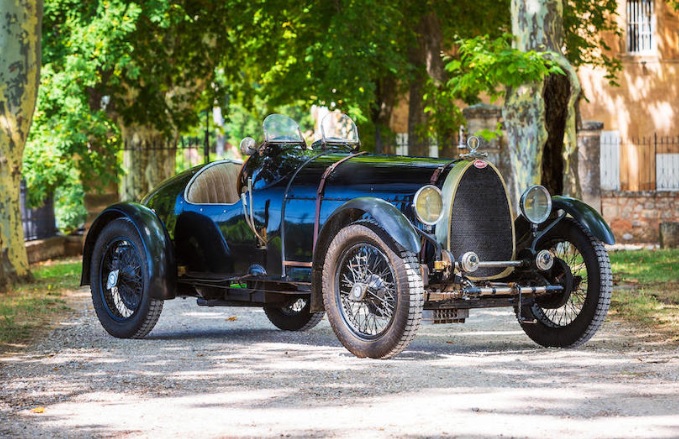
September 22, 2018
Bonhams' Goodwood Revival auction, Goodwood, UK, September 8, 2018
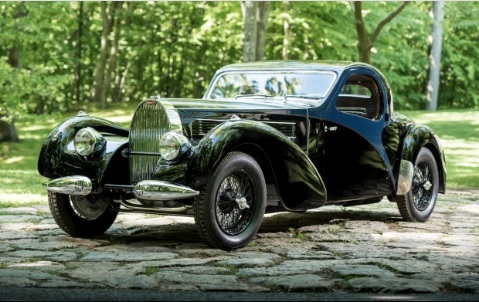
September 1, 2018
Gooding & Company Pebble Beach auctions, August 24 & 25, 2018
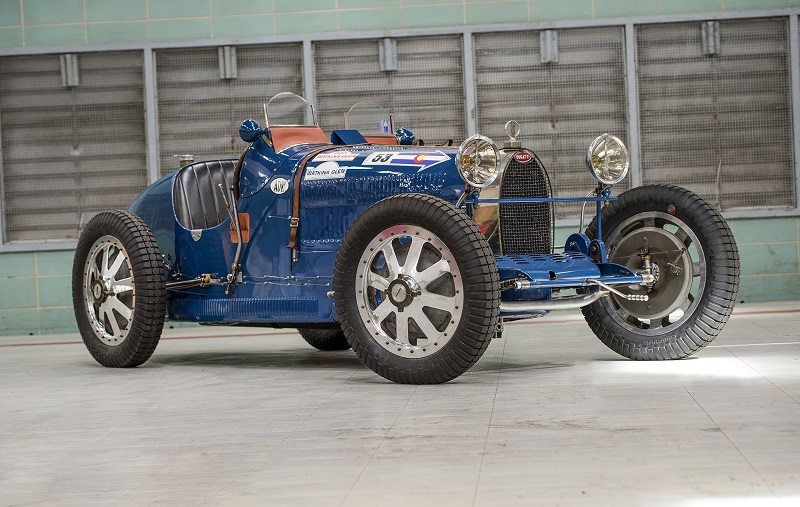
January 16, 2019 Worldwide Auctioneers Scottsdale auction Scottsdale, AZ, USA
Bugatti Type 35A
Auburn, Indiana. November 26th, 2018. Leading the field of early consignments for Worldwide’s annual Scottsdale Auction on Wednesday, January 16th is an exceptional and highly authentic example of Bugatti’s most successful racing model, a rare and impeccably documented 1925 Bugatti Type 35A.
With a limited roster of former keepers that includes Fred Hoffman, it was raced in period by Jean Ollivier and Louis Chiron, with competition history through 1942 that included the 1925 & 1926 Provence Grand Prix.
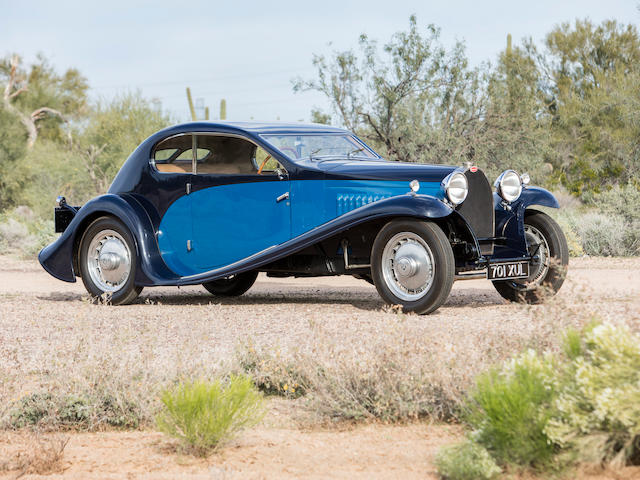
January 17, 2019 Bonhams' Scottsdale auction Scottsdale, AZ, USA
1931 Bugatti Type 46 'Superprofilée' Coupe
Chassis no. 46491,
Engine no. 345345
Coachwork in the style of Gangloff, by Ashton Keynes
One of two chassis purchased from Roland Bugatti by Richard Baudens in the 1950s
Estimate: US$ 750,000 - 1,000,000, € 660,000 - 880,000
THE MOTORCAR OFFERED
One of the most outlandish design studies of its day, Bugatti's aerodynamic coupe, which was christened the 'Superprofilée' was the latest development in the design traits that were coming from the Molsheim works in the late 1920s and start of the 1930s. Jean Bugatti had wisely employed the talented designer Joseph Walter to assist with their coachwork, and between them they developed a style which is now synonymous with the marque. Their influence would start to be seen from the late Type 40 models, with the arched side panels, and is of course evident across the Type 57 factory body range. Along the journey, as with all designers, they would create artwork and the occasional real-life model before rolling this out perhaps in a more practical form on the production cars. And, so is the case with Superprofilée and the less severe Semi-Profilée bodywork. The latter, in a more toned-down form, would of course go into production as the Ventoux Coupe on the subsequent Type 57. While, the Superprofilée style, which was first seen publicly on a Twin Cam Type 50 at the Paris Salon in 1932, does not appear to have become a production designation.
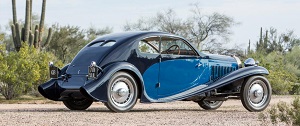
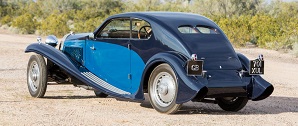
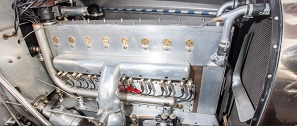
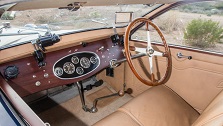
In terms of the statement made by these two profile body styles, it is a true icon of design of which there are very few survivors of the genus, those include a Semi-Profilée in the Louwman Collection, and the sole Superprofilée naturally resides in the Cité de l'Automobile, Musée National de l'Automobile, Collection Schlumpf, in France. The latter has proven to be an irresistible inspiration for others to mirror this striking piece of design. Copy being the sincerest form of flattery... this is one such example.
Most intriguingly, 46491 has a direct connection to the Schlumpf car. It is understood to never received coachwork in period, instead, it was one of a handful of Bugatti rolling chassis which would have languished around the works in the immediate post war era and was one of four which are understood to have been transferred to Ettore's son, Roland Bugatti. In the American Bugatti Club journal, Pur Sang Vol. 21, No. 3. Fall 1980, Andy Rheault wrote publishing a series of letters from Don Stanford to Russ Sceli in 1952, which refers to these cars as such: 'Richard Baudens' 'is a close friend of Roland Bugatti, Le Maestro's son' 'the Baudens-Bugatti friendship has resulted in a situation you won't believe, but here it is: Long ago, Baudens discovered a couple of brand new Bugatti chassis in Roland's garage and it turned out that there had once been four of 'em; Le Patron's last works, still (these two) in their original crates, 5-liter Bugatti engines complete and never yet turned over' 'Anyway—Roland Bugatti sold the last two crated chassis to Baudens, who shipped them to his garage in Paris, where they are today'.
Those two referred to are 46482 and this car 46491, the former would come to the States, and pass to Eri Richardson, who discovered the sole surviving Superprofilée body and matched it to that chassis in the late 1950s. That car is the subject of a number of articles entitled 'the last new Bugatti in the world,' and post Richardson moved on to noted Bugattiste Andy Rheault, who sold it to Fritz Schlumpf. Meanwhile, by elimination, 46491 is the other car referred to, which Don lists in 1952 as being 'definitely and finally not for sale, since Richard Baudens is going to have a body built for it'.
From Baudens this chassis now passed to Michael Glass in the UK and remained there for a number of years, 46491 was still in the UK in the 1980s where it was later acquired by arch car dealer Charles Howard, and then landed with the present owner nearly 25 years ago. A fastidious and passionate collector of French automobiles, he was inspired to recreate this mythical body style. To begin with the ideal was to build a semi-profilee, but as the project developed, the more avant garde Superprofilée became the desired conclusion.
Over the course of more than 10 years, the journey evolved, restoration was begun at Barrie Price's workshops and then transferred to Keith Bowley's renowned Ashton Keynes house in the British Cotswolds area. A color choice of black over blue was made, similar to 46482 and accentuating the car's lines.
The result as evidenced on these pages is stunning rendition of the stylized aerodynamic bodywork penned by Bugatti and Walter. Intriguingly, the coachwork that it wears today is not only to a period style, but also the first and only coachwork that chassis 46491 has ever worn. Once complete its use has been modest, with the occasional display outing including twice at the much-lauded Salon Privé event in 2009 and 2010.
Bugatti's majestic Type 46 is a much coveted and Grand Dame automobile of the brand, and in this form, it is also one of the most of its day. To date, the car has note been shown publicly at any USA Concours events, and is yet to be toured.
Also in the same auction:

January 18 - 19, 2019 Gooding Scottsdale auction Scottsdale, AZ, USA
1936 Bugatti Type 57 Two-Light Ventoux
Chassis: 57469, Engine: 350
Highly Original, Largely Unrestored Condition | One of Six Examples Built
